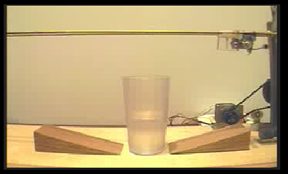« September 2006 | Main | November 2006 »
October 31, 2006
Synthecology
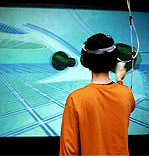
A Tele-Immersive Collaboration
Synthecology combines the possibilities of tele-immersive collaboration with a new architecture for virtual reality sound immersion to create a environment where musicians from all locations can interactively perform and create sonic environments.
Compose, sculpt, and improvise with other musicians and artists in an ephemeral garden of sonic lifeforms. Synthecology invites visitors in this digitally fertile space to create a musical sculpture of sythesized tones and sound samples provided by web inhabitants. Upon entering the garden, each participant can pluck contributed sounds from the air and plant them, wander the garden playing their own improvisation or collaborate with other participants to create/author a new composition.
As each new 'seed' is planted and grown, sculpted and played, this garden becomes both a musical instrument and a composition to be shared with the rest of the network. Every inhabitant creates, not just as an individual composer shaping their own themes, but as a collaborator in real time who is able to improvise new soundscapes in the garden by cooperating with other avatars from diverse geographical locations.
Virtual participants are fully immersed in the garden landscape through the use of passive stereoscopic technology and spatialized audio to create a networked tele-immersive environment where all inhabitants can collaborate, socialize and play. Guests from across the globe are similarly embodied as avatars through out this environment, each experiencing the audio and visual presence of the others.

Participants from the WWW use a browser interface to contribute sound elements to the garden environment for use as compositional items. All the while, this real-time composition is streamed through web broadcast of the virtual environment to illustrate the audio-visual transformation of the garden. Broadcast throughout the entirety of the festival, Synthecology will celebrate the possibilities of collaboration, improvisation, and distributed authorship that exist on the horizon of an increasingly interconnected world.
As current advances in networking become commonplace, the creation of collaborative environments connecting remote individuals will become less involved. By augmenting the possibilities for users to share sensory presence through tele-immersive interfaces, Applied Interactives intends to combine the possibilities of real-time collaboration and socialization with the dynamics of digital creation and manipulation. Synthecology is a speculative glance at how the technology of today may be utilized to create new autonomous zones for sampling & re-mixing culture.
COLLABORATORS
Synthecology is being created as a collaboration of students and faculty from the Electronic Visualization Laboratory at the University of Illinois at Chicago, The School of the Art Institute of Chicago, and Columbia College Chicago, and art(n) through the Applied Interactives organization.
ABOUT APPLIED INTERACTIVES
The purpose of Applied Interactives, NFP is to educate the art and science community about the medium of Virtual Reality as an interactive, computer-generated, immersive computer graphics environment. Applied Interactives, NFP plans to advance the medium through research and experimentation as well as provide a bridge to bring the technology out of institutional labs and into more publicly accessible arenas. Applied Interactives, NFP intends to propagate the medium by providing support and direct access to the resources necessary for artists and scientists to exhibit and develop works in the medium.
Posted by jo at 03:44 PM | Comments (0)
Yahoo! Time Capsule

Add Second Life Pics
The Electric Sheep Company (sponsors of this blog) are holding an event this Thursday and Friday, October 26-27, that will collect screenshots and text from the virtual world of Second Life for inclusion in the Yahoo! Time Capsule project, which will be sealed on November 8 and re-opened in the year 2020. That’s pretty cool (and Yahoo!’s Web site is cool as well). One thing strikes me, though. Why aren’t there 3D models being included in the time capsule? It’s not a particular failure of vision on Yahoo!’s part; it probably has more to do with the fact that there’s not yet a standard for such objects, nor can you export such information out of Second Life in a way that’s supported by the company and intelligible to other applications. Virtual 3D objects are not yet widely and easily manipulable, as, say, a chunk of html code is, or a jpeg file. The problem runs far deeper than the technological; the absence of a standard or other open system or protocol means that many people don’t think of the virtual world as just another part of the rest of their lives. When an online world can reach out to and communicate easily with many other online platforms, we’ll start to see more constructive attention being paid. It’s almost as if we’re now at 3pointD v1.0. Personally, I’m looking forward to 3pointD 2.0. If that makes any sense at all. [posted by Mark Wallace on 3pointD]
Posted by jo at 03:15 PM | Comments (0)
Help the Electric Sheep Destroy Television
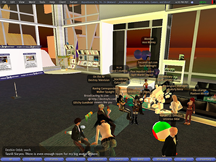
A User-Controlled Photo Documentary of Second Life
If you didn’t show up to the Second Life Herald’s third birthday party tonight, you missed quite a show. Even if you weren’t in the virtual world of Second Life, though, you may have caught the bash on Destroy Television, the new service from the Electric Sheep Company’s spare-time dev pool, Sheep Labs. Check out the Destroy Television avatar in the screenshot above. She looks innocent enough (even though she appears to be mooning the camera), but Destroy is an avatar of unique stripe; she’s controlled for the most part by users dialling over to the Destroy TV Web site, where they can make her chat or walk around. All the while, she snaps a pic every 30 seconds or so and plugs it into her Flickr page. The result is a user-controlled photo documentary of what’s going on around Second Life. More >> [posted by Mark Wallace on 3pointD]
Posted by jo at 03:06 PM | Comments (0)
Klaus Obermaier
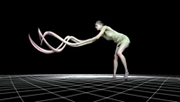
Le Sacre du Printemps
Media-artist, director and composer Klaus Obermaier has created a new performance of Russian composer Igor Stravinsky’s classical ballet Le Sacre du Printemps. In Obermaier’s version, the classical ballet is expressed in the form of an interactive music, dance and 3D project.
On stage distributed stereo-cameras and a complex computer system transfer the dancer Julia Mach into a virtual three-dimensional space. Time layers and unusual views overlay and multiply themselves and enable a completely new perception of the body and its courses of motion. Real-time generated virtual spaces communicate and interact with the dancer. By means of 32 microphones the entire orchestra is integrated in the interactive process as well. Musical motifs, individual voices and instruments influence the form, movement and complexity of both the 3D projections of the virtual space and those of the dancer. As such, music is no longer only starting point, but also completion of the choreography.
Klaus Obermaier’s version of Le Sacre du Printemps was performed first at this year’s Ars Electronica Festival in Linz, Austria. [blogged by Lene Mailund on Digital Experience]
Posted by jo at 02:56 PM | Comments (0)
Adam Greenfield
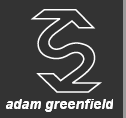
On the failure (or impossibility) of mapping
Last night I had an appointment to meet some old friends at Freemans for drinks and - as is both my habit in general, and an occupational hazard when getting around town on a conveyance that moves faster than just about anything else in the mired cityscape - I showed up quite a bit early.
Having locked up my bike, I found myself with a good fifteen minutes on my hands, an absurdly generous stretch of time in which to stroll up and down the not-particularly-extensive length of Freeman's Alley. I didn't have a book, I didn't happen to have my Moleskine on me, I had nothing close at hand with which to divert my attention, and so I wound up subjecting the space of the alley to the kind of close and sustained inspection I so rarely get to lavish on anything.
I saw windows bricked up, apparently against the encroachment of a neighbor building that was no longer in evidence. I saw fronds of razorwire tangled in rusted lengths of now-obsolescent barb, the both moored to a stanchion that had somehow worked or been torn free from anything more solid than the wire itself and which remained hanging stupidly in the void. Above all I saw a thousand ad hoc interventions, each the trace of some occasion on which an electrician or a plumber or a contractor made an off-plan, field-expedient modification in the name of getting things done - the outstanding example of which was a congeries of coiled, small-gauge utility lines staplegunned to the alley's westerly wall, their distal ends disappearing through holes into the buildings beyond. Some of these were still tagged legibly (feed 193 chrystie roof), but most had long gone mute as to their function or purpose.
I took all of this in, over the course of a quarter-hour. And then I knew, immediately and in my bones, that any project devoted to the Borgesian attempt to map the built environment at even reasonably high resolution is forever doomed to failure, no matter how many self-reporting locational gizmos we tack onto the world. Time and layered improvisation had rendered this one alley-end baroque almost beyond description, calling into question the practicality of any attempt to represent it schematically. And from there, inevitably, the regress beckoned, as it always does for me, and I suddenly understood the world as nothing more than an enormous aggregation of moments like these.
Infrastructure foliates, ramifies. That's what it is, what it does. It has a thousand parents, all of whom work on their own, in effective silence, and none of whose efforts or intentions are fully knowable to anyone else. Infrastructure, as I once insisted to a friend, is a bitch. All the cables, conduits, trunks and buses our planetary girdle of awareness is built from - they may not literally have the power of self-reproduction, but they may as well have, given how far beyond any one agency's knowledge or control they are and continue to grow. You turn around for a moment and it's all changed. How could we possibly hope to map it all?
I can't help but think that this is one of those apparent insights which occasionally strike me with the force of epiphany, and yet are completely banal to others. I don't know why a few minutes at the back of one particular New York alley should impress this feeling on me - maybe it's the effect of recent attention to questions of situatedness and underspecification - but I do know that moving forward, I'll be a lot less likely to take seriously any schema of the world which relies on the accurate description or representation of live infrastructure for its force. [blogged by Adam Greenfield]
Posted by jo at 02:44 PM | Comments (0)
e and eye
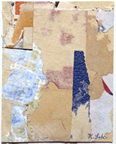
Art and Poetry Between the Electronic and the Visual
e and eye: art Art and Poetry Between the Electronic and the Visual :: Led by Penny Florence, Tim Mathews and John Cayley :: Monday 13 November 2006, 18.30–20.00.
Modern art has had a close historical relationship with poetry and performance since its formation. Electronic poetry has developed a strong element of performance, an implicit demand for some form of exhibition. This series of events explores the relationship between the visual, the poetic and the electronic in art. The sessions begin with a conversation in which invited speakers discuss issues relevant to the Collection and to electronic and visual poetry. This is followed by a short performance or reading of an electronic poem, and an open discussion. Laptop computers with video projection showing interactive electronic works are also placed within the galleries.
The speakers are theorists and practitioners in a variety of media and virtual curators, and include John Aiken, Patrick Burgaud, John Cayley, Penny Florence, Elizabeth James, Mark Leahy, Tim Mathews, Brigid McLeer, Sharon Morris and TNWK (Kirsten Lavers and cris cheek).
Virtual presence practitioners / curators / theorists: Sandy Baldwin, N Katherine Hayles, Camille Utterback, Talan Memmott, Rita Raley, David Rokeby, Alan Sondheim, Noah Wardrip-Fruin.
There is an e and eye blog at where further information is given. Members of the audience and participants can post comments and discuss the talks.
Organised by Penny Florence and Tim Mathews, with John Cayley.
In collaboration with The Slade School of Fine Art, SCEMFA and the Department of French, University College London
Tate Modern Throughout the gallery
Free, booking recommended
Price includes drinks afterwards
A booking fee of 50p applies to online bookings.
For tickets book online
or call 020 7887 8888.
Posted by jo at 11:57 AM | Comments (0)
WRO 07 (C): 12th International Media Art Biennale

International Competition
12th International Media Art Biennale WRO 07 (C) WRO Center for Media Art Foundation in Wroclaw, Poland announces an international competition open to any work created using electronic media techniques, exploring innovative forms of artistic communication.
The competition welcomes creators of artistic projects of diverse forms such as screenings (video art, computer animation), installations, objects, performances, multimedia concerts and network projects from all over the world. The main prize is eur5000 and the total prize money awarded is eur8000.
The deadline date for entry submission is 15 February 2007. Presentation of works selected to the very final along with the international jurys announcement of competition results will take place during public screening at the WRO 07 Biennale.
Agenda: 16 - 20 May 2007 competition, special events, symposium; 16 May - 17 June 2007 exhibition. National Museum in Wroclaw, WRO Art Center.
Posted by jo at 11:28 AM | Comments (0)
Furtherfield.org

The New Reviews/Interviews, Oct/Nov 2006
Welcome to Furtherfield's current collection of reviews and interviews. Please find time to read all of the writings, they are in no particular order. After reading, do explore all the networked behaviour generously written and thought about, in context.
Boredom Research: Interviewed by Aaron Steed
PHONETHICA: Reviewed by Franz Thalmair
Alex Dragulescu - Blogbot: Review by María Victoria Guglietti
VISP Project MACHFELD: Interview by Julian Bleecker
The Lost Biology of Silent Hill: FurtherCritic Article by [[Mez]]
disturb.the.peace [angry women]: Review by Eliza Fernbach
2nd Upgrade Meeting at Oklahoma City: Review by Luis Silva.
Jason Nelson - Vholoce: Review by John Hopkins
Boredom Research: Interviewed by Aaron Steed
An interview with Boredom Research on their latest project 'F.wish' a new online project commissioned by Folly (http://www.folly.co.uk/); based on the Lam Tsuen Wishing Trees. In Hong Kong near the Tin Hou Temple you can visit these trees, write your wish on a “bao die”, tie it to an orange and throw it up into the branches. If your wish is caught in the branches it is said to come true. The tree used to be a camphor tree where a tablet for worshipping Pak Kung was placed before it withered and became hollow. The myth goes that a worshiper prayed to the tree to fix his son who was slow in learning. The granted wish led to many more wishes being made of the tree.
PHONETHICA: Reviewed by Franz Thalmair
The contradictory overlap between diversity and similarity of languages and their corresponding cultures is the initial point for the project PHONETHICA by Takumi ENDO and Nao TOKUI. More than 6.5 billion people on our planet share approximately five to six thousand languages. Nevertheless, every single individual owns a speaking equipment, which enables him/her to produce the same sounds in every corner of the world. Consequently, there exists some coincidental similarity within the different idioms. Looking at languages in this specific way, it must be concluded that phonetic rather than semantic aspects of languages result in an overlapping of language phenomena in different cultural backgrounds.
Alex Dragulescu's Blogbot: Reviewed by María Victoria Guglietti
Blogbot and productive inertia. Sometimes silence is unbearable. Alex Dragulescu’s graphic novel What I Did Last Summer inundates our screen with words that we can almost touch. The phrases are intermittent, fragmentary, irrevocably silent… “I don’t ask why…” “Now, you’ve got all that on…” “I read the Stars and Stripes and….” These are textual bombs; scattered sentences harvested by Dragulescu’s software agent Blogbot. The phrases are actual extracts captured from the famous war blogs My War[sub]1[/sub] and Baghdad Blogger[2], two of the most famous blogs written by participants and witnesses of the war in Iraq.
The Lost Biology of Silent Hill_: FurtherCritic Article by [[Mez]]
The game Silent Hill [all 5 versions] attempts to restitch game-genre predictability. The versions progress using suspense/dread evocation as their primary engagement tool. Various game elements produce this introspective thrill-connection through the use of sound biting [almost literally], sinister environ expectancies [limited visual negotiations through fog/blackness], rotten materiality [decay + dereliction] and puzzle elements designed 2 provoke survival adaptions [fight-or-flight responses].
disturb.the.peace [angry women]: Review by Eliza Fernbach
Can anger be beautiful? Can rage be aesthetic? The collaborative net-based installation site D/tP disturb.the.peace [angry women] thinks so. What after all is more powerful than an angry woman but a group of angry women doing art? The infamous 'angry young man' epitomized by the likes of James Dean and Marlon Brando in the cinema of the Fifties hasn't really been mirrored in a feminine glass. Polishing a reflection on angry women- young or old is the aim of this site that Hollers back and out into the future with bravado. Curated by Jess Loseby (http://rssgallery.com/), submissions to the site are ongoing and the bar has been set high by the founding fems who grace the inaugural page.
2nd Upgrade Meeting at Oklahoma City: Review by Luis Silva
This year, the Oklahoma City node will host the Second International Meeting. Having the DIY (Do-It-Yourself) ideology as its theme, as well as a metaphor for the functioning of the Upgrade! network, this city in the middle of the United States of America will witness, from November 30th to December 3rd, a worldwide meeting of new media artists, curators, critics and theoreticians. Over twenty nodes will be present and have been preparing specially for the occasion a program that will feature exhibitions, performances, lectures, workshops, screenings and debates. Spreading all over the city, in spaces like Untitled [ArtSpace], IAO Gallery or The Oklahoma City Museum of Art.
Jason Nelson - Vholoce: Review by John Hopkins
Vholoce is one project in a long line of projects which seeks to creatively engage the ubiquitous data-streams that are flooding our virtual world. The rising flood of data is useless without sensible display. Visual (and sonic) display of digital data is a fundamental contemporary issue. But what is sensible display? Using a data stream as a basically random source for visual display is one way to play with the stream. The syntax of visual display (possibly) becomes the site for expression by the creative producer. The data-stream source, the method of (and reason for) display, and the overall creative process need to be interrogated in order to find the basis for the type of digital engagement.
If you are interested in being a reviewer on Furtherfield contact: marc.garrett[at]furtherfield.org
Furtherfield Neighbourhood & Projects:
# www.furtherfield.org
# www.http.uk.net
# www.visitorsstudio.org
# www. blog.game-play.org.uk
# www.nodel.org (with many others)
# http://netartfilm.furtherfield.org
# www.netbehaviour.org
# www.furthernoise.org
Posted by jo at 11:06 AM | Comments (0)
Christophe Bruno (2004-2006)
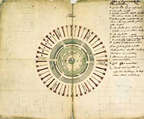
The Web before the Web
The Web before the Web :: Christophe Bruno (2004-2006) :: James Joyce, Jeremy Bentham, Edgar Allan Poe, Stéphane Mallarmé, Alan Turing, Georges Perec & Marcel Bénabou, Stanley Milgram, Frederick Taylor, The Great Chain of Being, The Web after the Web.
In September 2004 Bruno was a guest-blogger for the French online magazine fluctuat.net. He wrote a series of short posts about what could be called "the precursors of the Web"... or "the Web minus the technology". (the posts in french are here.)
Here is an augmented and updated version in English.
To be published in the magazine for art and new media Aminima N°20.
Posted by jo at 10:54 AM | Comments (0)
November

An Online Networked Performance TONIGHT!
November: An online Networked Performance :: Join us as we cast out the stale air of the fading summer and move together into winter. Celebrating Halloween and the changing of the season, we come together online to exchange our collected thoughts across the Internet whilst each eating garlic cloves.
This networked performance by Patrick Simons and Kate Southworth (glorious ninth) in collaboration with Ruth Catlow and Marc Garrett (Furtherfield.org) will be launched at: - Time: 9 minutes and 41 seconds before midnight (GMT) :: Date: 31st October 2006 :: Location: http://november.gloriousninth.net
NOVEMBER is a performance that utilises peer-to-peer instant messaging technology, and the participants were able to see and hear each other on their computers throughout. Working with their own pre-chosen texts, each participant alternated between reading aloud and listening, amending and improvising their performances in response to each other. At times a cacophony of competing voices, the performance was a spontaneous and unrehearsed encounter, exposing moments of vulnerability, intimacy, connection and rhythm.
Posted by jo at 08:57 AM | Comments (0)
[Re: ] magazine
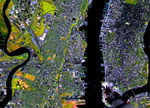
Locative Media
[Re: ] magazine has launched its first edition. The theme of this international new media online magazine is locative media. Locative Media -recently becoming more popular in Media Art discourses- has roots dating back to the dawn of history. Early myths like the Gilgamesch Epic or - more specific - Homer's Odyssee deal with issues of location and the recording of movement on earth's surface...
Developments since then include mediaeval cartography as well as the Situationists' approach to mapping a city. Nowadays Locative Media uses technology to trigger artworks in a specific physical space. The magazine features an depth interview with locative media artist Jeremy Hight about a new form of dissent utilizing smart mobs, on line community and locative media. [posted on RANDOM]
Posted by jo at 08:53 AM | Comments (0)
October 30, 2006
Deb Todd Wheeler:
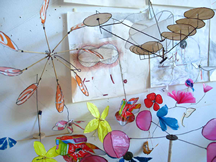
Live Experiments in Human Energy Exchange
Deb Todd Wheeler: Live Experiments in Human Energy Exchange (endurable velocipede, version 3) :: Green Street Gallery :: October 31 - December 14, 2006 :: Opening Reception: November 10, 2006 >> 7 - 9:30 pm :: >> Artist's Talk: Saturday, December 2 @ 6 pm.
This exhibition, part utopian fantasy, part meditation on possibilities and impossibilities in sustainability, concerns technology as a mediator for human interaction with the environment. Working in the 21st century means being captive to 21st century technologies, which for the most part rely on the electrical grid. In this installation, the power to fuel the kinetic sculptures comes from an alternate source: human power.
The experiments begin >> October 31 during gallery hours. We need Volunteer energy generators!! (come by and ride the bike....) Sign up at the gallery. Come by at 6pm to make grocery bag flowers!
Central to the installation is a modified bicycle, which is hooked up to a generator and various rigs, gears and pulleys. By pedaling the bike, the rider (a gallery volunteer) activates the installation, generating light, wind, sound, and motion to fuel a series of kinetic studies on the fraught relationships between nature and technology. In one piece the bike powers a DC generator that in turn powers fluorescent lights embedded in hacked ant farms, in which worker-ant tunnels are dug beneath looming silhouettes of 1964 World's Fair pavillions.
In another work, the same bike turns gears that transfer energy to wind power by turning a windmill-like form with sails made of recycled plastic grocery bags.
That windmill then powers a series of pivoting images, which delicately align into a third image when the wind hits them. At the end of this energy chain, the last bit of energy, animated moths and butterflies made from a year's worth of junk mail cover a wood scale model of Biosphere 2. Behind the bike rider and filling the gallery, a pulley-powered cassette deck connected to the bike plays the soundtrack from 1964 Futurama video at the speed of the rider. Also in the gallery are works on paper, and wire-frame models of flight experiments, inspired by the aerial pursuits of 19th century natural philosopher Louis Pierre Mouillard.
Posted by jo at 04:49 PM | Comments (0)
OPENLAB 3

Free Software Culture
OPENLAB 3 :: Group Show, 4/11-11/11/2006, 1-7pm :: Opening Event and Private View 4/11/2006, 4 -12 pm :: Closing Event 11/11/2006, 4-12 pm :: Auto-Italia South London Gallery, 82-86 Queens Road, SE152QX Peckham, London.
OpenLab is delighted to present OpenLab3, an group exhibition with an opening and closing event featuring musical performances by more than 20 artists and musicians of the OpenLab collective. OpenLab engages in the aesthetics and politics of Free Open Source Software Culture. Free Software Culture seeks to emphasise transparency of the creative process by making all stages of development available to others, enabling them to learn how the creation works and alter it for their own purposes. When this idea is applied to artistic practices, the boundaries between the artistic usage of software tools and their collaborative development become blurred. The workings of the artist's tools are exposed, and the artists are actively engaged in developing media technologies. They can modify them to suit their goals, rather than creating works by using existing tools that impose "their way of doing things" on the artwork.
This group exhibition brings together interactive installations, sonic interventions, video works and animations which explore the audio-visual code of this network culture: computers start to paint pictures on their own, expose their internal circuits and "commit suicide"; birds will sing and fly around in multiple realities, the skylines of two cosmopolitan cities merge, language, meaning and time burst into fragments and recombine. The range of the combined works points to the strength of Open Source Culture ? its increasing versatility as artistic playground essential to contemporary debates and its continued importance not just in the invention of new media realities but also in tackling themes of "real" time and space.
The two music events feature sound and multimedia performances of artists who use and develop open-source tools such as PD, Supercollider, Processing and Fluxus. They will perform prepared sets and code their music live in various programing languages. Musicians will also experiment with a set of live instrument swapping. By exchanging PD-Patches, they will challenge each other in an uncharted space of sonic manipulation. The performances will span from excursions into the symphonica, experimental noise and soundscapes to electronica and beat-oriented minimal techno-sets.
PARTICIPATING ARTISTS: Rob Canning, Chun Lee, Claude Heiland-Allen, Carl Forsell, Sabine Gottfried, Karsten Gebbert, Paul Webb, Rob Munro, Chiharu Kaido, Evan Raskob, U-Sun, Ryan Jordan, Oli Laruelle, Robert Atwood, Luke Jordan, Rene, Monica Subrotova & Daniel Kordik, Michael Woelkner, Andy Farnell, Martin Aaserud, Ryan Jordan & Rachel Horne, Dave Griffith & Alex
McLean
For more information please visit
http://www.fexia.com/openlab
http://openlab.pawfal.org
http://www.midnightbluecollective.com
Posted by jo at 04:28 PM | Comments (0)
Natural Habitat
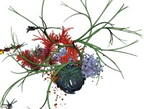
Art + Nature + Technology
Natural Habitat: What happens if art and nature and technology come together? Are new worlds created? Is the distinction between nature and technology still visible, or do the two increasingly merge with one another?
In the Natural Habitat project artists are working at the interface of nature and technology. Here they investigate the extent to which nature and technology complement each other, and show possitive ideas of a new nature. In Natural Habitat the boundaries between nature, culture and technology become increasingly blurred. The project consists of an exhibition Natural Habitat, from November 4 untill December 16 (opening November 4, 15.00 hour) and a seminar Art and Science in their Natural Habitat on Saturday November 11 from 13.00 - 17.30 hour. Information about the Art and Science in their Natural Habitat seminar.
During the MuseumNight Saturday November 4 from 19.00 – 02.00 hour a special programme is organized in relation to Natural Habitat with an all-night intervention by Bodies Anonymous around the video installation Geomania (1987) by Steina Vasulka and visitors can have their own DNA put into a contemporary chain with met Genes in a Bottle (start 21.00 h. limited edition).
Netherlands Media Art Institute
Montevideo / Time Based Arts
Keizersgracht 264
1016 EV Amsterdam
The Netherlands
www.montevideo.nl
T +31 (0)20 6237101
F +31 (0)20 6244423
info[at]montevideo.nl
Posted by jo at 04:14 PM | Comments (0)
net.tv

An Art Browser (browser as art work)
Net.tv, by Garrett Lynch, is a cross between a browser and a streaming media player designed to view the internet as it really is, code or more specifically markup, not a series of web pages designed under a print metaphor. It makes no attempt to interpret the code into an organised layout as do conventional browsers, instead it displays the code as an audio-visual stream of indeterminate length.
Why reduce the internet to an audio-visual stream? Simply to provoke thought around our use and consumption of different media, linear push media such as television and non-linear interactive pull media such as websites, which have been converging for sometime now. Net.tv's purpose is to highlight the way we as users continually construct self made narratives when we use the internet through choices based on an interact / react model. It does this by removing our ability to chose and act on those choices. Users enter a chosen url, click go and from there on the experience of 'surfing' is automated and dictated by a preprogrammed rule:
On start
{
retrieve webpage url entered.
Visualise webpage as an audio-visual stream.
Spider to first webpage url available on current webpage url.
Repeat while new url available.
}
When we use a browser to surf the internet what we view and how we view it is controlled by the browser. It functions as a framing mechanism and for net.art this can be considered a problem or challenge depending on your point of view. The creation of a browser as a work of net.art allows an artist to not alone create an artwork but control how and under what conditions it will be viewed.
"After the first experiments with web sites, the browser rapidly became the unavoidable framework for Net art [sic] in the eyes of the artists. Webstalker, created by the London-based art group I/O/D and introduced in the first part of net.art, was the first 'art browser' to call into question the conventions of representation on the internet on a much more fundamental level than any work on the web was able to. After Webstalker, a whole series of art browsers appeared...they show precisely what 'normaly' browsers try to hide. Instead of Web sites with pretty designs, one sees what lies beneth the surface: the code the pages have been written in and the structure of the Web sites appearing on the screen as complex diagrams which most definitely have their own aesthetic appeal." (Baumgärtel, T. 2001)
By denying the user any possibility of interaction with or control over browsing content when using net.tv, the possibility to surf the internet, the user is in fact denied the status of user and becomes simply a spectator of a broadcast medium much like television. Web pages, net.art works themselves (including the artists own) become input, the equivalent of a signal for the browser, suppling a constant feed of content which controls the browser and the path it takes through the internet. Linking from page to page or site to site is no longer a controlled or chosen decision by the user. Instead the application decides constantly spiraling off onto new pages as soon as it finds a link.
Unlike most browsers which exist and are defined by the content they depict, their message, the internet as viewed / interpreted through net.tv is no longer a source of information. It is a browser which is viewed solely for its aesthetic form, an abstracted composition of sounds and images.
Net.tv is available to download for Mac OSX 10.2+, Mac OS 8/9 and Windows 98 / Millennium Edition / NT 4.0 / 2000, or XP from the artists website.
a+
gar
Garrett[at]asquare.org
http://www.asquare.org/
Posted by jo at 03:59 PM | Comments (0)
Ken Feingold:
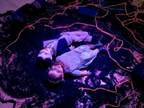
Eros and Thanatos Falling/Flying
Ken Feingold: Eros and Thanatos Falling/Flying :: Exhibition at Mejan Labs :: 2nd November – 10th December 2006 :: Opening on November 2nd 5-8 pm. :: Mejan Labs, Akademigränd 3, Stockholm.
For Mejan Labs Ken Feingold will premiere a new work in his Eros and Thanatos series, titled Eros and Thanatos Falling/Flying. Here he suspends two ventriloquist puppets, one in each room of Mejan Labs, from the ceiling so they appear to fly or fall. This ambivalence, a balance between two opposites, is something you can find in several of Feingold's pieces. The mythical characters of Eros and Thanatos were used by Freud in his formulation of drive theory to metaphorically represent the fundamental biological energies of, on the one hand, Eros: life, creativity, growth, and increase in tension, and on the other, Thanatos: that of the movement towards homeostasis (elimination of all tensions), dissolution, negation, and death. Psychoanalysts who follow Freud’s ideas have characterized these in many different ways, but fundamentally agree that we are constantly driven between stimulation and action by a balance of the forces of these energies, neither one ever found in completely pure state.
Posted by jo at 03:55 PM | Comments (0)
NEW MEDIA ART
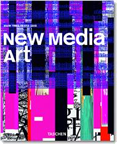
THE LAST AVANT-GARDE
Rough version of an interview with Mark Tribe & Reena Jana, authors of NEW MEDIA ART (Taschen, 2006). A shorter version has been published in Flash Art Italia, Issue 260, October - November 2006, p. 73.
Domenico Quaranta: Even from an editorial point of view, your book describes new media art as a movement (such as Surrealism or
Conceptualism) rather than a mere possibility of the medium. This is a very interesting point. Do you believe in it or is this a marketing strategy? Is new media art the last avant-garde, and why?
Mark Tribe: Before we discuss New Media art as a movement, we describe it more generically in terms of "projects that make use of emerging media technologies and are concerned with the cultural, political, and aesthetic possibilities of these tools." I think this is more-or-less what you mean by "a possibility of the medium." We go on to write, "New Media art is not defined by the technologies discussed here; on the contrary, by deploying these technologies for critical or experimental purposes, New Media artists redefine them as art media." We then talk about New Media art as an art movement because, from our perspective, that is an important aspect of the historical context that has been largely ignored. In order to understand the work that was made by people who called themselves "New Media artists" and thought of what they made as "New Media art," it is crucial to consider the historical specificity of that term (it's relation to the corporate New Media industry, the Dot com boom and bust cycle, etc.), as well as the place of New Media art practices within a broader art-historical framework.
I believe strongly in the value of this kind of contextual reading, as opposed to a more formalist approach that considers the intrinsic qualities of the work in isolation. Your question about the avant-garde actually raises a similar issue: like New Media art, avant-garde can be defined generically as any cultural practice that pushes beyond the limits established norms through innovation and experimentation. But avant-garde can also be defined with historical specificity as a set of movements, such as Dada and Constructivism, that linked experimental cultural practices with radical social and political change. But, to answer your question directly, I do think that New Media art was one of the few historically significant art movements of the late 20th century. There were a lot of other historically significant practices, but none of them galvanized as movements per se. The defining characteristics of art movements, in my view, are: self-definition (the artists tend to use a common term, or set of competing terms, to name their practice); the existence of dedicated organizations, venues, publications, and discourse networks; and a common set of artistic strategies and concerns. Often one finds the last of these without the first two, as was the case with identity-focused work in the early 90s. I do think that New Media art could be described, generically, as avant-garde.
Reena Jana: Mark very eloquently described the parameters of our definition of New Media as a movement. Our point is that during the 1990s, with the dawn of the Internet's popular rise as a mass-market communication medium coupled with the increasing presence of PCs among households, a specific art movement started to take shape that both used these tools as primary artistic media to comment on the effect of these media on society and culture. This movement entailed self-organization and definition on the part of the artists involved on chat rooms, on artist-run Web sites, in gallery exhibitions and at institutions devoted to the movement. We seek to document this phenomenon, and to point out that New Media art is a specific term that refers to a particular historical moment. Our goal is to offer more than simplistic clumping of all work using digital media with a blanket term such as "digital art." New Media artists were not simply experimenting with digital editing to make their video art easier to produce or creating online animations of their paintings (two examples of practices that often were described as "digital art" in the late 1990s and conflated with New Media art). Instead, New Media artists use emerging mass-communications tools to comment on the social, cultural, and philosophical effects that such tools trigger. And yes, in my view, New Media art as it evolved from 1994-2004 can be understood as "avant-garde." As for New Media art's description as "avant-garde," I think it's key to see an antecedent in the Dadaist and Surrealist points of view that avant-garde art strives for using inventive artistic techniques to jar audiences and affect their understanding and experience of life. New Media art also can be described as generically "avant-garde," by definition—consider the term and the artists' imaginative use of emerging mass-media and distribution channels involved to comment on the larger "new media" as a dominant cultural force and influence in the 1990s.
DQ: Why do you focus on the Nineties, seemingly forgetting the Telecommunication art of the Seventies and the Computer art of the Eighties?
MT: We discuss Video art in the "Art-historical Antecedents" section of the introduction. We had to cut a paragraph or two on transmission art of Paik, Douglas Davis, et al due to space constraints (the length of the introduction was pre-defined by the publisher to conform with the series). We left out '80s Computer art (AKA Multimedia art, Electronic Intermedia, etc.) because we felt that it was not, in fact, a significant precursor. Although Computer art and New Media art, to the extent that they can be distinguished from each other, shared a similar set of enabling technologies, and many old-school Computer artists from the Siggraph/Leonardo/ISEA scene joined the New Media art bandwagon in the '90s, the two are crucially and fundamentally different in their relationship to media culture. Of course I'm generalizing broadly here, and there are lots of exceptions, but most Computer art was not as concerned with media culture as it was with information technologies and their cultural applications, whereas New Media art almost always takes a critical position in relation to media culture and media technologies.
RJ: Our focus is not on media art (i.e., video or other telecommunication art) or early experiments with computer, electronic, or biological material and themes, but instead on New Media art. For clarity, we place New Media art within the continuum of media art and computer-based art. Please refer to page 7: "We locate New Media art as a subset of two broader categories: Art and Technology and Media art..." New Media is also its own category.
DQ: What kind of criteria did you follow in the selection?
MT: From page 7 of the English version: "We chose to... focus on works that are particularly influential, that exemplify an important domain of New Media art practice and that display an exceptional degree of conceptual sophistication, technological innovation, or social relevance." Beyond that, we considered geographic diversity and generally selected work that we personally like. Unfortunately, do to the limitations of the series, we had to leave out a lot of work that we very much wanted to include.
RJ: In addition, I think it's important to circle back to the definition of New Media art that Mark mentioned in his first answer. We looked for "projects that make use of emerging media technologies and are concerned with the cultural, political, and aesthetic possibilities of [new media] tools." As for "selecting work that we personally like," such a criterion reflects basic editorial (and, for that matter, curatorial) practice. We spent many hours debating back and forth what the final list would be - an intellectually challenging - and rewarding - process that we feel resulted in a balanced selection of forms, themes, styles, geographical representation, gender, and technologies that reflects the diversity and dynamism of the international movement of New Media art. Please note that our introduction includes many examples of other important works that we had nominated for inclusion in the main entries, which is historically relevant, or was influential. Because the book is meant to be a brief introduction to New Media art, we were required to present a concise list of main entries that illustrate the scope of the movement.
DQ: A book like this is a strange event for media art practitioners: it is cheap, small, captivating and easy to read. Media art gets out of the ghetto and goes mainstream. Don't be shy: do you think "New Media Art" is going to change something in the history of new media art?
MT: New Media art started to emerge from the ghetto and swim in the mainstream several years ago, but I get your point. We tried to write the book in such a way that it would be both accessible to non-specialists and useful to our peers. I like the fact that the book has so many large images of the art work and that Taschen does such a beautiful job with printing and design. I do hope that the book helps broaden the audience for New Media art and generate more support for New Media artists and organizations.
RJ: Yes, the price-point, portability, and accessible-yet-informed tone are indeed intended to broaden the audience of New Media art, although certainly New Media art is quickly gaining attention in mainstream outlets (for example, one artist in the book, Cory Arcangel, was named best emerging artist of 2005 by Mark Stevens, New York magazine's critic/co-author of the Pulitzer Prize-winning de Kooning biography). At the same time, we hope to offer a fresh thesis within the ever-growing field of new-media studies. In 2006, it is possible to now look back and offer historical context for both of these audiences, the non-specialists and specialists. Our aim is to suggest a focused lens through which students, art-historians, artists, curators, collectors, and the general gallery and museum visitor alike can look at New Media art.
Domenico Quaranta
mob. +39 340 2392478
email. qrndnc[at]yahoo.it
home. vicolo San Giorgio 18 - 25122 brescia (BS)
web. http://www.domenicoquaranta.net/
Posted by jo at 03:42 PM | Comments (0)
ART CAKE:

THE DELICIOUS TRANSIENT NEW MEDIUM
AXIOM Gallery presents: ART CAKE: THE DELICIOUS TRANSIENT NEW MEDIUM :: One night show and Opening Reception - November 3rd 6-9pm :: AXIOM Gallery 186 Hampshire Street, Cambridge Corner of Hampshire and Prospect Sts in Inman Square.
ART CAKE: THE DELICIOUS TRANSIENT NEW MEDIUM: features work from eight artists and teams selected from an open call. Artists were asked to get creative and use new media, sound, video, and theory in order to create an interactive cake piece.
Featuring: Rob Coshow, Catherine Dechico and Emily Su, Heloisa Escudero, George Fifield, Mary Greenfield and Taylor Hayward, Brian and Rebecca Higgins, Ravi Jain, Georgina Lewis
Posted by jo at 12:05 PM | Comments (0)
Mil i una veus-Mil y una voces
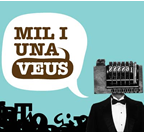
Thousand and one voices
Orquestra del Caos presents the sound art festival MIL I UNA VEUS (thousand and one voices) next 3rd and 4th of November in CCCB (Contemporary Culture Centre in Barcelona), focused on the research of unconventional and artistic use of the human voice.
Featuring concerts by David Moss and José Iges. Presentations by Bartolomé Ferrando and Eduard Escoffet, and a selection of over 150 sound pieces by other artists organized in four collections for individual consultation: "Text Sound", "Radio Radio", "Linebreak", "Música electroacústica i veu" and "Camí fressat: itineraris per les escriptures contemporànies"; and two collections for public audition with eight loudspeakers: "Le sixte livre dit éléctroacoustique de François Rabelais" (GMEB) and "Octofonies per a Veus" (Simon Fraser University).
With interviews and works by : Charles Amirkhanian, Bruce Andrews, Paul Auster, Milton Babbitt, Michael Basinski, Jacques Bekaert, Françoise Barrière, José Manuel Berenguer, Charles Bernstein, Lars-Gunnar Bodin, Rainer Boesh, Pierre Boeswilwald, Bufffluxus, William Burroughs, cris cheek, Michel Chion, Henry Chopin, Bob Cobbing, Robert Creeley, Hugh Davies, Francis Dhomont, Jane Draycott & Elizabeth James, Stephen Erickson, Barbara Guest, Ray Federman, Ben Friedlander, Madeline Gins, Sten Hanson, Carla Harryman, Georg Katzer, Leo Kupper, Lyn Hejinian, Ake Hodell, Susan Howe, Bengt Emil Johnson, Sianed Jones, Sherwood Lazier, Karen Maccormack, Steve Mccaffery, Jennifer & Kevin McCoy, Jackson Maclow, Christof Migone, Paul D. Miller (a.k.a DJ Spooky), Robert Normandeau, Lance i Andrea Olsen, Jena Osman, John Oswald, Ted Pearson, Piers Plowright, Michel Redolfi, Roger Reynolds, Jerome Rothenberg, Leslie Scalapino, Ron Silliman, J.A. da Silva, Martin Spinelli, Peter Straub, Ulrich Suesse, Luci Tapahonso, Dennis Tedlock, Fiona Templeton, Daniel Teruggi, Daniel Tosi, Barry Truax, Lawrence Upton, Ben Yarmolinsky,
Cecilia Vicuña, Hannah Weiner, Hildegard Westerkamp, Gregory Whitehead, Ben Wilson, Trevor Wishart and many others.
Free Admission
Programme on http://www.sonoscop.net/
Press information on http://www.sonoscop.net/prensa/
MIL I UNA VEUS is one of Sonoscop's showcases. Sonoscop is the public sound art archive initiative by the Orquestra del Caos, open to anyone for consultation and contribution.
Posted by jo at 08:02 AM | Comments (0)
re:place 2007
s![]()
CALL FOR PROPOSALS
re:place 2007: The Second International Conference on the Histories of Media, Art, Science and Technology :: Berlin, 15 - 18 November 2007.
re:place 2007, the Second International Conference on the Histories of Media, Art, Science and Technology, will take place in Berlin from 15 - 18 November 2007 as a project of Kulturprojekte Berlin GmbH in cooperation with Haus der Kulturen der Welt. This conference is a sequel to 'Refresh!', the first in this series, chaired by Oliver Grau and produced by the Database of Virtual Art, Leonardo, and Banff New Media Institute, and held at the Banff Center in Canada in September 2005, which brought together several hundred artists, scientists, researchers, curators and theoreticians of different disciplines.
re:place 2007 will be an international forum for the presentation and the discussion of exemplary approaches to the rapport between art, media, science and technology. With the title, 're:place', we propose a thematic focus on locatedness and the migration of knowledge and knowledge production in the interdisciplinary contexts of art, historiography, science and technology.
The re:place 2007 conference will be devoted to examining the manifold connections between art, science and technology, connections which have come into view more sharply through the growing attention to media art and its histories over the past years. It will address historical contexts and artistic explorations of new technologies as well as the historical and contemporary research into the mutual influences between artistic work, scientific research and technological developments. This research concerns such diverse fields as cybernetics, artificial intelligence, robotics, nano-technology, and bio-technology, as well as investigations in the humanities including art history, visual culture, musicology, comparative literature, media archaeology, media theory, science studies, and sociology.
Conference Programme
The conference programme will include competitively selected, peer-reviewed individual papers, panel presentations, poster sessions, as well as a small number of invited speakers. Several Keynote Lectures, by internationally renowned, outstanding theoreticians and artists, will deliberate on the central themes of the conference.
The conference will also include dedicated forum sessions for participants to engage in more open-ended discussion and debate on relevant issues and questions.
CALL FOR PROPOSALS
re:place 2007 welcomes contributions from established as well as from emerging researchers in diverse fields. The conference will be of interest to those working in, but not limited to, the following areas: art history and theory, literary studies, cultural studies, film and media studies, theatre, dance and performance studies, philosophy, history, gender studies, human-computer interaction, contemporary art, musicology, sound studies, anthropology, sociology, geography, science, technology and society studies, history of science, and history of technology.
We are especially keen on empirical, conceptual, and historical contributions that exemplify and expand the diverse methodological and thematic concerns of this extended interdisciplinary area. These might include contributions to:
- institutional histories of centers, sites, or events that have helped to concretize and engender the intersections between media, art, science and technology. Some broad areas could be: experimental arts spaces, collaborative research labs, significant exhibitions, etc.
- 'place studies' that highlight significant locations or situations where such interdisciplinary intersections or significant historical episodes have occurred. A few examples might be: 'Tesla in Budapest', 'Flusser in Brazil', USSR in the 1920s, 'Japan between 1950s-1970s,' etc.
- historiographical issues, methods, and debates that pose critical questions in the formulation of the histories of the 'media arts'. These might include: archaeology, genealogy or variantology as methodological tools, bridging the divide between art and media history, sociologies of interactivity, etc.
- theoretical frameworks from various philosophical and disciplinary positions. Topics might include the exemplary role of film studies or musicology for the study of media arts, or the significance of cultural specificities and location in media and technologies, etc.
- the migration of knowledges and practices from different contexts, whether disciplinary, institutional, geographical or cultural. Topics might include: the role of migrant artists in the development of new discourses and practices; the movement and adoption of disciplinary ideas from science into art contexts or vice versa, etc.
SUBMISSIONS
A dedicated website and online paper submission system will be ready for submissions from 1st December 2006. Abstracts of proposals, panel presentations and posters will have to be submitted in either Text, RTF, Word or PDF formats.
The DEADLINE for submissions will be 15 January 2007.
INFORMATION about the submission process and general information can be found at: http://tamtam.mi2.hr/replace
replace 2007 is a project of Kulturprojekte Berlin GmbH in cooperation with Haus der Kulturen der Welt, Berlin. Funded by Hauptstadtkulturfonds, Berlin.
Conference partners include Leonardo, Database of Virtual Art at Danube University Krems' Center for Image Science, Ludwig Boltzmann Institute Media.Art.Research, Forum Goethe Institut, and others.
Conference chairs: Andreas Broeckmann (D), Gunalan Nadarajan (SG/USA)
Posted by jo at 08:01 AM | Comments (0)
Upstage Walk Through
![]()
Try out UpStage 2
The next open walk-through will be this coming Wednesday, 1 November, at 8pm NZ time. Convert to your local time here. We will be on the Swaray stage, so audience members should come directly here; if you'd like to log in and participate as a player, it's imperative that you email me for a log-in as it's now impossible for more than one person to log in with the same username, so we need to make sure you aren't all trying to use the same guest log-in!
We now have the alpha version of UpStage 2 running on our server, so this walk-through is your first chance to try out the new features and enhanced interface (and help us identify bugs - this is the ALPHA version after all!). We're extremely grateful to the AUT student team - Beau Hardy, Francis Palmer, Lucy Chu & Wise Wang - who have been working on UpStage all year, and also our wonderful programmer Douglas Bagnall who is back on board to integrate the students work & continue with other developments for UpStage 2.
Hope to see you online on Wednesday,
helen : )
PS - Wednesday is also Leena's birthday - she's immersed in her current project (the interactive TV series "Accidental Lovers") so can't join us for this walk-through, but we'll definitely be drinking a virtual toast to her virtual birthday in her virtual presence/absence ...
Helen Varley Jamieson: helen[at]creative-catalyst.com
http://www.creative-catalyst.com
http://www.avatarbodycollision.org
http://www.writerfind.com/hjamieson.htm
Posted by jo at 07:50 AM | Comments (0)
October 27, 2006
The Rose Art Museum
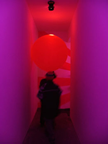
Balance and Power: Performance and Surveillance in Video Art
Amid unprecedented concern over privacy and security issues in America and abroad, The Rose Art Museum at Brandeis this fall will feature a look at artists’ uses of surveillance techniques related to performance art and government spying systems. Michael Rush, the Henry and Lois Foster Director of The Rose, will curate the timely exhibit called “Balance and Power: Performance and Surveillance in Video Art.”
“This exhibit examines both the early days of video art as well as current practices,” Rush said. “It’s an attempt to understand the complex relationship between voluntary acting for the camera and involuntary taping by a camera on the part of power systems that have an interest in the movement of citizens.” The exhibition will run Sept. 21 through Dec. 17, 2006.
“Balance and Power” features work by a diverse group of artists, from early video pioneers such as Andy Warhol, Vito Acconci, and Bruce Naumann, to emerging practitioners such as Jill Magid and Tim Hyde. Other international artists are Sophie Calle, Jim Campbell, Peter Campus, Jordan Crandall, Harun Farocki, Subodh Gupta, Kevin Hamilton, Tiffany Holmes, Paul Kaiser and Shelley Eshkar, Kristin Lucas, Steve Mann, Jenny Markatou, Jonas Mekas, Muntadas, Martha Rosler, Julia Scher, and Kiki Seror.
Balance, says Rush, can be described as “an essential talent for the performer,” while power is “the essential currency of surveillance.” The terms are interconnected through themes such as “star” culture, identity theft, privacy and cultural paranoia, he said.
Many of these psycho-social phenomena are reflected in the current mega success of reality TV. “People voluntarily allow themselves to be taped openly and surreptitiously. Surveillance becomes performance and vice versa,” Rush said.
The exhibit will feature a dozen video installations in a uniquely designed space created by Antenna Design Group in New York. There will be large-scale installations, single channel tapes, and newly commissioned work. The exhibition was originally organized by the Krannert Art Museum at the University of Illinois.
Symposium: Privacy Rites: Space, Surveillance, and Power in Historical Perspective :: Brandeis University :: Wednesday, November 8, 2006
4:00 - 6:30 p.m. :: Levine-Ross, Hassenfeld Conference Center
Co-conveners: Mark Auslander (Anthropology) and Andreas Teuber (Philosophy)
The landmark essay, “The Right to Privacy” (1890) by Louis Brandeis and Samuel Warren, was reportedly inspired by a highly evocative episode: a newspaper photographer climbed over a garden wall to photograph Warren’s daughter’s breakfast wedding party, leading to the image’s mass dissemination across the city. This symposium explores some of the fascinating paradoxes suggested by this telling example. “Privacy” and its twinned antithesis, “surveillance,” emerged out of the intersection of built domestic space and emerging optical technologies of mass reproduction. Note the spatial metaphors in Brandeis and Warren’s anxious prophecy: “numerous mechanical devices threaten to make good the prediction that ‘what is whispered in the closet shall be proclaimed from the house-tops.’” A violation of the core spatial distinction of the modern city, the tenuous distinction between public and private, helps catalyze the image of a sacrosanct, sovereign self that is in principle beyond the gaze of sovereign state power or the untrammeled forces of the market.
In this symposium we will reflect upon the broader historical antecedents, resonances, and implications of Brandeis and Warren’s anxious plea. For some theorists, the accelerating proliferation of optical and electronic technologies of surveillance and mechanical reproduction exemplifies a postmodern decoupling of space and power. Bentham’s Panopticon depended on fixed architectural structures, binding together warden and prisoner, the routinzer and the routinized, in intimate disciplines of mutual engagement and physical proximity. In contrast, the synthesis of electronic surveillance, mass mechanical reproduction, and complex information networks seems to promise power that is entirely “extraterritorial,” in which controlling elites are fluid, inaccessible, and no longer spatially entangled with their subordinates. In turn, other scholars insist, sophisticated technologies of remote or virtual monitoring do not transcend space and place as such, but are rather embedded in shifting forms of architecture, landscape, selfhood, and embodiment that are themselves the products of complex social and material histories.
Participants include:
Mark Auslander (Anthropology)
Alex Green (Brandeis '04; owner, Book Pages Books)
Caren Irr (English and American Literature)
Laurie Kain Hart (Anthropology, Haverford College)
Peter Kalb (Fine Arts)
Alice Kelikian (History)
Tom King (English and American Literature)
Ann Koloski-Ostrow (Classics)
Adrianne Krstansky (Theater Arts)
Laura Miller (Sociology)
Rick Parmentier (Anthropology)
John Plotz (English and American Literature)
Michael Rush (Director, Rose Art Museum)
Ellen Schattchneider (Anthropology)
Dr. Ramie Targoff (English and American Literature)
Andreas Teuber (Philosophy)
Jonathan Unglaub (Fine Arts)
Michaele Whelan (English and American Literature)
Discuss Privacy and Surveillance
http://culturalproduction.wikispaces.com/Surveillance+and+Privacy+Comments
About the Rose Art Museum at Brandeis
Opened in 1961, The Rose Art Museum has one of the most distinguished collections of modern and contemporary art in New England. Each year, The Rose organizes highly acclaimed special exhibitions and collection displays, presenting a mix of international, national and local artists.
Rose Art Museum
Brandeis University
415 South Street
Waltham, MA 02453
Posted by jo at 06:11 PM | Comments (0)
Art and Aporia: Imaging Place
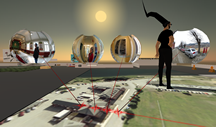
Interview with JC Fremont (aka John Craig Freeman)
JC Fremont: I am considering your two pieces on the white cube (part 1 and part 2 ) and my feeling is that if it looks like art then it probably isn't art.
Lythe Witte: interesting!
JC Fremont: In RL but especially here in SL.
I asked JC Fremont to elaborate via email: “Well art that imitates art in the real world is repugnant. SL art that imitates RL art is irrelevant. Okay a painting served the ideology of 20th century consumer capital society. It became the ultimate commodity object. More profitable than gold or plutonium. Remember that art before the rise of commodity capital was sight specific. It resided in the cathedral or on the cave wall. No way to buy and sell. What could possibly be the purpose of making cartoon representations of paintings in a virtual environment? Art should be unrecognisable as such. In electrate culture the forms will change drastically. We don't know what electrate art will be yet. First, Electrate art will have no object, evade commodity consumption. If it can be commodified then it is not good electrate art. Second, never finished it will always be in a state of becoming, upgrading. Art needs to disrupt.” Continue reading Art and Aporia: Imaging Place by Lythe Witte.
Posted by jo at 10:42 AM | Comments (0)
Furtherfield Commissions 5+5=5
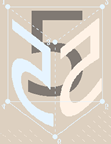
Exploring Imaginative and Critical Approaches to Social Engagement
5+5=5 :: 5 short movies by 5 film makers about 5 networked art projects :: Free Media - Mongrel + Polyfaith - Chris Dooks + Golden Shot (Revisited) - Simon Poulter + Want and Need - C6 + VisitorsStudio - Furtherfield.
5 short movies by 5 film makers about 5 networked art projects exploring imaginative and critical approaches to social engagement. Furtherfield has commissioned 5 short movies about 5 UK-produced networked art projects which explore critical approaches to social engagement.
These pieces offer alternative interfaces to the artworks and the every-day artistic practices of their producers. They introduce the motivations and social contexts of artists and artists' groups who are working with DIY approaches to digital technology and its culture, where medium and distribution channels merge.
These movies each feature the concepts, contexts and techniques involved in the creation of five specific pieces of work. They include conversations between artists, audiences/participants and film- makers, talking on their own terms.
Original concept and production Furtherfield, London, UK, 2006. In association with HTTP Gallery [House of Technologically Termed Praxis], London, UK. Made with the support of Stiftelsen Laangmanska Kulturfonden and Mejan Labs in Stockholm, Sweden - Arts Council of England and Awards for All in UK.
Posted by jo at 10:27 AM | Comments (0)
Hz Journal

Call for Articles
Hz is looking for articles on net art, new media, electronic music / electro-acoustic music and sound art. Previously published / unpublished articles in English are welcomed. Please send your submissions to hz-journal[at]telia.com.
Hz is published by Fylkingen, a non-profit art organization in Stockholm. Established in 1933, Fylkingen has been promoting new and experimental art forms throughout its history. For more information, visit http://www.fylkingen.se/fylkeng.html or
http://www.hz-journal.org/n4/hultberg.html
Posted by jo at 10:19 AM | Comments (0)
October 26, 2006
Noah Wardrip-Fruin
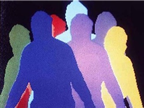
e and eyeToy
Noah Wardrip-Fruin's contribution to the Tate’s e and eye project has just gone live: “e and eyeToy.” Where else can you get Myron Krueger, Camille Utterback, Rafael Lozano-Hemmer, EyeToy: Play and much more all bundled into one short essay?
"The Tate's "material gestures" hang cuts across time, but I find my mind settles, first, on the moment of abstract expressionism in the U.S. This work brings the artist's gesture into a particular relationship with artworks shown in museums.
This might be contrasted with the nearby moment of the Happening - the attempt to incorporate the live gesture, including the audience gesture, into artwork that was self-consciously unshowable. The blurring of art and everyday life, as a book title of the Happening's most famous proponent would have it later.
Now we enter a moment in which, through interaction, we see the gesture of the audience being incorporated into showable art. This work moves beyond video art, which included the audience as an image of itself. Now the audience, while perhaps also visible as an image within the work, becomes data - one of the fundamental components of digital media. In work such as that selected by Camille Utterback for the "New Materiality" installment of "e and eye" the audience's gesture is seen to drive the work, to fundamentally produce what we see. The audience's gesture can drive the work by providing data because the artist has begun to work with a particular material: digital computation." Continue reading e and eyeToy by Noah Wardrip-Fruin. [via]
Posted by jo at 03:42 PM | Comments (0)
AUTOSTART Begins

Release of Electronic Literature Collection Volume 1
The full announcement and Web site with participant bios are already up, but here’s a quick run-down of what’s coming up at the Writers House:
The festival is in Philadelphia, PA, at 3805 Locust Walk on the Penn campus. We’re celebrating the release of the Electronic Literature Collection volume 1, which is being published on CD-ROM and the Web. AUTOSTART attendees will get a copy of the CD edition.
The big events are the discussion (1-2:30pm) and the reading (5:30-7:30pm) on Thursday. There’s an open house between these to allow people to drop in for discussion with festival participants, to see the ELC vol 1, and to take tours of it given by me and Stephanie Strickland.
Two RSVP-only events are the Wet Digit workshop for digital media newcomers (Thursday 4-5:30pm) and the Electronic Writing Jam (Friday 1-4pm). Register for these now if you’re hoping to attend: wh[at]writing.upenn.edu. There’s also a tour of the Slought Foundation Friday morning.
I’ll write up the basics of what happens at the festival as best I can. Noah and Mary will be there in their own bodies, and Scott will appear via videoconference at the E-Writing Jam. I hope to see at least a few Grand Text Auto folks out there - please say hi to me (and Noah, and Mary) if you do make it by! [blogged by Nick on Grand Text Auto]
Posted by jo at 03:35 PM | Comments (0)
Hideki Nakazawa
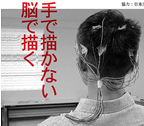
Brain Waves Drawing
[posted by Yukihiko YOSHIDA] Brain Waves Drawing :: Live Performance by Hideki Nakazawa :: Nov 4-5, 2006 at Fuchu Art Museum, Tokyo Supported by Nihon Kohden.
Not to Draw by Hand. To Draw by Brain: Artists usually draw pictures by hand with brushes or pencils. However, the activities of brains must be more important and essential than the ones of hands at the moment of creating art. Therefore, I decided to draw pictures with electrodes being set on my head through controlling the activities of my own brain. The curved lines so-called "brain waves" in medicine must be the "drawings" in the world of fine art, directly drawn by my brain without using hands.
Posted by jo at 02:52 PM | Comments (0)
dorkbot-nyc

November 1st, 2006
The dorkbot-nyc meeting will take place on Wednesday, November 1st, 2006, at 7pm at Location One in SoHo. MAKE will likely be there, so if you want to meet up, drop a comment.
Albert Hwang: The Wiremap :: The Wiremap is a design that uses an LCD projector and a custom surface to make real and interactive 3d images. The images rendered exist in the same spatial dimension as our bodies do, bridging the gap between digital 3d and analogue 3d. With this project, I hope to redefine how we encounter digital 3d. Instead of a collection of weightless polygons, digital 3d can engage with our bodies and our intuitive spatial instincts in a visceral and tangibly real way.
Cameron Browning: Electrosketch :: Electrosketch is an interactive art installation that uses a number of technological hacks to allow users to scribble paths onto the walls of their environment in real-time. During the short period of time the images are recorded, other users have the opportunity to use digital controls connected to the installation to manipulate the paths in 3D.
Natalie Bewernitz & Marek Goldowski: sound art :: EPG (Expanded Polyphonetic Generation) is an audio installation performance that uses an artificial mouth palate to control voice fragments. Using the voice of artist Meredith Monk, which is fragmented in over 3000 pieces (sylables and phonemes), two performers attempt to control the triggered samples with the mouth palate interface to build up an improvised (musical) communication between them.
dorkbot-nyc, people doing strange things with electricity - Link. [via MAKE]
Posted by jo at 10:11 AM | Comments (0)
TEXELECTRONICA ‘06

Instrumental Texts and Texas Instruments
Those who can’t make it all the way from Texas to Philadelphia for AUTOSTART next week can still catch a grand several days of electronic media art…TEXELECTRONICA ‘06: International Forum, Exhibition & Performance-Series featuring Electronic Media Art & Music (Dallas/Ft Worth, Texas, USA).
Theme: SPIN: SOCIETY, PERSONA, INTERACTIVITY & NETWORKS :: 3-Day Forum: Fort Worth Modern Art Museum, Oct. 27-29 :: Free for the public with a suggested donation of $15 for 5 sessions, or $5 per session :: Nightly Exhibitions & Performances: DFW area art spaces. [blogged by Nick on Grand Text Auto]
Posted by jo at 09:51 AM | Comments (0)
October 25, 2006
[DAM] Berlin

COMPUTER FINE ARTS COLLECTION OF DORON GOLAN
COMPUTER FINE ARTS COLLECTION OF DORON GOLAN :: Internet Art / Software Art :: www.computerfinearts.com :: Exhibition 06: 10th November 2006 – 5th December 2006 :: Exhibition Opening: Thursday, 9th November 2006, 7-9 pm. :: [DAM] Berlin, Digital Art Museum, Tucholskystr. 37, D-10117 Berlin.
Doron Golan collects artwork, which have been developed for the internet. He concentrated on an aspect of contemporary art, which was consindered as not marketable. The different pieces, which were developed specifically for the Web are free available for everybody. In many cases the internet, with its specific possibilities, is an integral part of the artwork. By aquiring these pieces he enables the persistence of these artworks online. The collection is internationally and you´ll find some important artists, which were already known for internet-art in the 1990s. We present his collection as a projection in the gallery.
ARTISTS: a.abrahams s.y.ahn m.amerika j.andrews s.biggs n.bookchin m.bravo
m.breeze s.brooks h.bunting e.burton x.cahen a.campbell g.chatonsky shu
lea cheang n.clauss c.cloninger coyarzun m.daggett a.de cologne e.de kok
a.deck doctor hugo r.drouhin a.galloway m.garrett v.grancher p.horvath
s.hourany g.h.hovagimyan l.jevbratt y.kanarek j.klima KRN l.lacook m.lafia
tamara.lai t.laporta b.lattanzi j.r.leegte g.levin lia o.lialina p.lichty lokiss
j.loseby lo_y p.luining j.mcdonald j&d mcelroy a.mendoza mouchette mtaa
m.nakamura m.napier j.nechvatal j.nelson r.packer pavu.com c.peppermint
a.polli m.rackham a.schmitt j.simon a.shulgin y.sodeoka a.sondheim
n.stern b.stryker m.szpakowski m.takeo magruder i.stromajer thomson&
craighead b.todd m.tribe j.van anden m.walczak m.wattenberg a.weintraub
p.wood young-hae chang heavy industries j.zeleznikar j.zellen zhang.ga
Guest: Holger Lippmann ( GER) with his animation /Popular/
[DAM] Berlin
Digital Art Museum
Tucholskystr. 37
D-10117 Berlin
Di - Fr 12-18 Uhr | Sa 12-16 Uhr
Tue- Fri 12-6 pm | Sat 12-4 pm
phone: +49 30 280 98 135
www.dam.org/berlin
www.dam.org
www.ddaa-online.org
Posted by jo at 02:41 PM | Comments (0)
PRC | POV: PHOTOGRAPHY NOW AND THE NEXT 30 YEARS

Turbulence.org!
PRC | POV: PHOTOGRAPHY NOW AND THE NEXT 30 YEARS :: November 3, 2006 – January 28, 2007 :: The PRC and 30 luminaries predict "ones to watch" :: Opening reception, Thursday, November 2, 5:30-7:30pm.
Boston, MA. The Photographic Resource Center—a non-profit gallery, education, and resource center—is pleased to present a unique exhibition in honor of the organization’s founding in 1976. The PRC has always been at the forefront of emerging ideas and work and for our 30th anniversary, we chose to focus attention on new and novel ideas in photography and related media. Nominations were solicited from current and past PRC staff, board, and luminaries for people, places, and things that might just be getting attention (or deserve more) as well as those that will likely make a significant contribution to the field of photographic arts in the next 30 years.
Conceived as one generation shaking the hand of another, the exhibition and its title honors all of our nominators’ “points of view” as well as the former PRC publication, VIEWS: A New England Journal of Photography. It was hoped that the “PRC 30” would reflect the insights of our nominators, but also direct attention outwards towards “up-and-coming” artists, entities, and ideas. Final selections were primarily informed by our mission as a “vital forum for the exploration and interpretation of new work, ideas, and methods in photography and related media.” The resulting gallery and online exhibition is collaborative and future-focused.
Numerous themes have emerged in PRC/POV that speak to current photographic practices and larger artworld issues. Media and genre boundaries continue to blur and frontiers, international and virtual, are ever expanding. The artists and artworks are international—including artists and images from Finland, Germany, the Netherlands, and more—and the selected entities include everything from a photography bookstore, to an online arts magazine, eBay, and Photoshop. The artwork is both traditional and innovative—including documentary work from Lebanon, Ghana, and Manila to an installation from a scanned 16mm film, a collage made using a photobooth strips, to photographs and videos from performances.
Installed as an inventive survey exhibition, we hope that this unique show and project will be a true snapshot of “photography and related media now” and, if we are correct collectively, a benchmark for the next 30 years. More information and images from each artist and entity are found in a special full-color insert in the PRC’s November/ December newsletter, in the loupe, as well in a *special PRC/POV website* with statements, links, and more, to launch November 1 at prcboston.org.
FEATURED ARTISTS AND ENTITIES:
1.) Adobe® Photoshop®, (San Jose, CA), Nominated by Andrew D. Epstein
2.) Julie Anand (Phoenix, AZ), Nominated by Jim Stone
3.) ASPECT Magazine (Boston, MA), Nominated by Pamela Allara
4.) Big RED and Shiny, Inc. (Boston, MA), Nominated by Bruce Myren
5.) Martha Buskirk (Cambridge, MA), Nominated by Patricia Johnston
6.) John Chervinsky (Somerville, MA), Nominated by Barbara Hitchcock
7.) Dashwood Books (New York, NY), Nominated by Eelco Wolf
8.) Robert Ladislas Derr (Columbus, OH), Nominated by Anita Douthat
9.) eBay Inc. (San Jose, CA), Nominated by Rodger Kingston
10.) Foundation for the Exhibition of Photography (Minneapolis, MN & Paris, France), Nominated by A. D. Coleman
Lajos Geenen (Born 1972, Bleiswijk, The Netherlands;Lives in New York City, NY),
Preliminary #5, From “The Preliminary” series,2004/2006, Digital C-print, 24 x 20 inches, Courtesy ofthe artist and Robert Klein Gallery, Boston, MA
11.) Miklos Gaál (Helsinki, Finland), Nominated by John Stomberg
12.) Tim Garrett and Photobooth.net (St. Louis, MO), Nominated by Henry Horenstein
13.) Lajos Geenen (New York, NY; Born The Netherlands), Nominated by Robert Klein
14.) Elijah Gowin (Kansas City, MO), Nominated by Jim Dow
15.) Chehalis Hegner (Campton, NH), Nominated by Arno Rafael Minkkinen
16.) Todd Hido (San Francisco, CA), Nominated by Carl Chiarenza
17.) In-Sight Photography Project Inc. (Brattleboro, VT), Nominated by Arno Rafael Minkkinen & Jim Dow
18.) interrupt art productions (Artist Collective; Based in Brooklyn, NY), featuring the work of Mikael Kennedy and Mandy Lamb, Nominated by Robert Seydel
19.) Jaclyn Kain (Jamaica Plain, MA), Nominated by Rick Grossman
20.) Misty Keasler (Dallas, TX), Nominated by Jean Caslin
21.) Linda Kroff (Los Angeles, CA), Nominated by Bart Parker
22.) Jonathan Monk (Berlin, Germany; Born Leicester, England), Nominated by Darsie Alexander
23.) Scott Peterman (Hollis, ME), Nominated by Terrence Morash
24.) PUBLIO Magazine (Boston, MA), Nominated by Karl Baden
25.) Susana Reisman (Toronto, CA; Born Caracas, Venezuela), Nominated by Jeff Weiss
26.) Dana Romanoff (Works Washington, DC), Nominated by John P. Jacob
27.) Claudia Saimbert (Methuen, MA), Nominated by Stan Trecker
28.) Karina Aguilera Skvirsky (New York, NY), Nominated by Sara Rosenfeld Dassel
29.) Paul Taggart (Based in Middle East), Nominated by Lou Jones
30.) Turbulence.org, a project of New Radio and Performing Arts, Inc. (aka Ether-Ore), (Roslindale, MA & Staten Island, NY), featuring “Self-Portrait” commission by Ethan Ham (New York, NY), Nominated by Laura Blacklow.
And one to grow on…Flickr ! This unique website and photo management application was selected by the PRC and is dedicated to our audience. We invite gallery visitors to take a snapshot, which will be uploaded to the PRC’s Flickr site. We also welcome you to leave thoughts and predictions on the future of the PRC and photography in the gallery and online.
LOCATION AND HOURS:
Photographic Resource Center, 832 Commonwealth Avenue, Boston, MA 02215.
617.975.0600 (tel), 617.975.0606 (fax), www.prcboston.org, prc@bu.edu MBTA: B Green Line, BU West T-stop
HOURS: Tuesday through Friday from 10 to 6pm, Thursdays from 10 to 8pm, Saturday and Sunday 12 to 5pm.
ADMISSION: $3/general public, $2/students and seniors and FREE to all Institutional Plus Member Schools. In addition, the PRC is FREE to all on Thursdays and on the last weekend of every month. The PRC is always FREE to members, IP member schools, children under 18, BU students, faculty, and staff, as well as all school groups with appointments. The PRC is accessible.
ABOUT THE PRC: Founded in 1976, The Photographic Resource Center is a vital independent non-profit organization dedicated to photographic education and presentation. Operating from the campus of Boston University, it provides a highly acclaimed exhibition program of 5-6 exhibitions a year, a bi-monthly newsletter, lectures, workshops, special events, and a 4,000-volume resource library to our members and the general public. It is supported by grants from the Massachusetts Cultural Council, numerous private foundations, corporations, and individuals, and the ongoing generosity of its members.
Posted by jo at 02:03 PM | Comments (0)
EvoMUSART 2007
![]()
FIRST CALL FOR PAPERS
EvoMUSART 2007 :: 5th European Workshop on Evolutionary Music and Art :: 11-13 April, 2007, Valencia, Spain :: EVOSTAR :: EVOMUSART :: "ArtEscapes: Variations of Life in the Media Arts"
The use of biological inspired techniques for the development of artistic systems is a recent, exciting and significant area of research. There is a growing interest in the application of these techniques in fields such as: visual art and music generation, analysis, and interpretation; sound synthesis; architecture; video; and design.
EvoMUSART 2007 is the fifth workshop of the EvoNet working group on Evolutionary Music and Art. Following the success of previous events and the growth of interest in the field, the main goal of EvoMUSART 2007 is to bring together researchers who are using biological inspired techniques for artistic tasks, providing the opportunity to promote, present and discuss ongoing work in the area.
The workshop will be held from 11-13 April, 2007 in Valencia, Spain, as part of the Evo* event.
The event includes the exhibition "ArtEscapes: Variations of Life in the Media Arts", giving an opportunity for the presentation of evolutionary art and music. The submission of art works for the exhibition session is independent from the submission of papers.
Accepted papers will be presented orally at the workshop and included in the EvoWorkshops proceedings, published by Springer Verlag in the Lecture Notes in Computer Science series.
TOPICS OF INTEREST
The papers should concern the use of biological inspired techniques - e.g. Evolutionary Computation, Artificial Life, Swarm Intelligence, etc. - in the scope of the generation, analysis and interpretation of art, music, design, architecture and other artistic fields. Topics of interest include, but are not limited to:
- Generation
o Biological Inspired Art - Systems that create drawings, images, animations, sculptures, poetry, text, etc.;
o Biological Inspired Music - Systems that create musical pieces, sounds, instruments, voices, etc.;
o Robotic Based Evolutionary Art and Music;
o Other related generative techniques;
- Theory
o Computational Aesthetics, Emotional Response, Surprise, Novelty;
o Representation techniques;
o Surveys of the current state-of-the-art in the area; identification of weaknesses and strengths; comparative analysis and classification;
o Validation methodologies;
o Studies on the applicability of these techniques to related areas;
o New models designed to promote the creative potential of biological inspired computation;
- Computer Aided Creativity
o Systems in which biological inspired computation is used to promote the creativity of a human user;
o New ways of integrating the user in the evolutionary cycle;
o Analysis and evaluation of: the artistic potential of biological inspired art and music; the artistic processes inherent to these approaches; the resulting artifacts;
o Collaborative distributed artificial art environments;
- Automation
o Techniques for automatic fitness assignment;
o Systems in which an analysis or interpretation of the artworks is used in conjunction with biological inspired techniques to produce novel objects;
o Systems that resort to biological inspired computation to perform the analysis of image, music, sound, sculpture, or some other types of artistic object;
ADDITIONAL INFORMATION AND SUBMISSION DETAILS
Submit your manuscript, at most 10 A4 pages long, in Springer LNCS format (instructions downloadable from here) no later than November 1, 2006.
The papers will be peer reviewed by at least three members of the program committee. Authors will be notified via email on the results of the review by December 15, 2006.
The reviewing process is double blind. Authors should remove their names from submitted papers, and avoid statements and references that would identify the authors.
Papers must be submitted using the conference management software. Please follow the instructions in: http://evonet.lri.fr/EvoWorkshops07-Submission/
The authors of accepted papers will have to improve their paper on the basis of the reviewers' comments and will be asked to send a camera ready version of their manuscripts, along with text sources and pictures, by January 8, 2007. The accepted papers will appear in the workshop proceedings, published in Springer LNCS Series, which will be available at the workshop.
Further information can be found on the following pages:
Evo*2007: http://www.evostar.org
EvoMUSART2007: http://evonet.lri.fr/TikiWiki/tiki-index.php?page=EvoMUSART
IMPORTANT DATES
Submission: 1 November 2006
Notification: 15 December 2006
Camera ready: 8 January 2007
Workshop: 11-13 April 2007
WORKSHOP CHAIRS
Penousal Machado
University of Coimbra, Portugal
Machado AT dei DOT uc DOT pt
Juan Romero
University of A Coruna, Spain
jj AT udc DOT es
PROGRAM COMMITTEE
Alan Dorin, Monash University, Australia
Alejandro Pazos, University of A Coruna, Spain
Amilcar Cardoso, University of Coimbra, Portugal
Andrew Gildfind, Royal Melbourne Institute of Technology, Australia
Andrew Horner, University of Science & Technology, Hong Kong
Antonino Santos, University of A Coruna, Spain
Artemis Sanchez Moroni, Renato Archer Research Center, Brazil
Bill Manaris, College of Charleston, USA
Brian J. Ross, Brock University, Canada
Carlos Grilo, School of Technology and Management of Leiria, Portugal
Charlie D. Frowd, University of Stirling, UK
Christian Jacob, University of Calgary, Canada
Colin Johnson, University of Kent, UK
Eduardo R. Miranda, University of Plymouth, UK
Eleonora Bilotta, University of Calabria, Italy
Evelyne Lutton, INRIA, France
Francisco Camara Pereira, University of Coimbra, Portugal
Francois-Joseph Lapointe, University of Montreal, Canada
Gary Greenfield, University of Richmond, USA
Gary Lee Nelson, Oberlin College, USA
Gerhard Widmer, Johannes Kepler University Linz, Austria
Gianfranco Campolongo, University of Calabria, Italy
James McDermott, University of Limerick, Ireland
Janis Jefferies, Goldsmiths College, University of London, UK
Jeffrey Ventrella, Independent Artist, US
Joao Martins, University of Plymouth, UK
John Collomosse, University of Bath, UK
Jon McCormack, Monash University, Australia
Jorge Tavares, University of Coimbra, Portugal
Larry Bull, University of the West of England, UK
Luigi Pagliarini, Pescara Electronic Artists Meeting & University of Southern Denmark, Italy
Maria Goga, University of Bucharest, Romania
Martin Hemberg, Imperial College London, UK
Matthew Lewis, Ohio State University, USA
Nicolas Monmarch., University of Tours, France
Nicolae Goga, University of Groningen, Netherlands
Paul Brown, University of Sussex, UK
Paulo Urbano, Universidade de Lisboa, Portugal
Peter Bentley, University College London, UK
Peter Todd, Max Planck Institute for Human Development, Germany
Pietro Pantano, University of Calabria, Italy
Rafael Ramirez, Pompeu Fabra University, Spain
Rodney Waschka II, North Carolina State University, USA
Ruli Manurung, University of Indonesia, Indonesia
Scott Draves, Independent Artist, USA
Stefano Cagnoni, University of Parma, Italy
Stephen Todd, IBM, UK
Tim Blackwell, Goldsmiths College, University of London, UK
Tony Brooks, Aalborg University, Denmark
William Latham, Art Games Ltd, UK
Posted by jo at 10:29 AM | Comments (0)
Thinking the Surface

A Workshop on Screens, Mobilities, Environments in the Global Age
Thinking the Surface: A Workshop on Screens, Mobilities, Environments in the Global Age :: Cornell University, Oct. 27-28, 2006 :: Convened by Timothy Murray, Mohsen Mostafavi, María Fernández for The Rose Goldsen Lecture Series, College of Arts and Sciences/ The Dean's Lecture Series, College of Architecture, Art, and Planning.
How might the surface and its extension in mobility contribute to the evolving contexts of global networks, political frontiers, architectonic environments, cinematic visions, and lived subjectivities? In relation to both the cinematic screen and the architectural façade, the surface is both a philosophical construct and an environmental event that challenges its subordination in the binaries depth/surface, structure/appearance, mind/body, nation/frontier. Participants will discuss international developments in art, politics, architecture, philosophy, and new media that expand the energetic event and promising agency of the surface in the global age.
Schedule of Events, free and open to the public:
Friday, October 27, 2006
Opening Sessions: Guerlac Room, A. D. White House
2:00 Introduction by Mohsen Mostafavi and Timothy Murray
2:10-3:00 Cinematic Surfacings
Timothy Murray, Department of Comparative Literature
"Poiesis and the Surface of New Media"
Lauren Beeley, Department of Romance Studies
"Surreal Surfaces: Thinking Cinema through Artaud"
Katherine Groo, Department of Comparative Literature
"Rereading Josephine Baker and the Surface of Ethnographic Film"
3-4:15 Technological Complicities: Chair: Phoebe Sengers, Depts. of Science & Technology Studies, Information Science.
Park Doing, Department of Science and Technology Studies
"Laying on of the Laboratory Hands: Surfaces, Knowledge, Labor"
Natalie Jeremijenko, Department of Art, UC San Diego; NYU Distinguished Global Visiting Professor
"Interfacing human and nonhuman; re: imagining the interplay; re: calculating the interaction"
Plenary Lecture
4:30 Hollis E. Cornell Auditorium, Goldwin Smith Hall :: Chair: Brett de Bary, The Society for the Humanities.
Brian Massumi, Department of Communication, University of Montreal
"The Body Transspatial: On the Art of the Event"
Saturday, October 28, 2006:
Guerlac Room, A. D. White House
9:30 Coffee and Bagels
10-12 Architectural Surfaces: Chair: Buzz Spector, Department of Art
Mohsen Mostafavi, Dean, College of Architecture, Art, and Planning
"Structuring the Surface"
Paul Andersen and David Salomon, Department of Architecture
"The New Architecture of Patterns"
12-1:30 Lunch
1:30-3:00 The Personal and The Political in Art:Chair: Renate Ferro, Department of Art
Horit Herman-Peled, Media Artist, Tel Aviv
"Witnessing in elusive surfaces"
Brooke Singer, Preemptive Media Collective; Dept. of Art SUNY Purchase
"Upside-down and inside-out: A Reorientation Guide to Emerging and Mobile Technologies"
3:15:4:45 Responsive Architecture: Chair: Timothy Campbell, Department of Romance Studies.
Branden Hookway, Department of Architecture
"Cockpit Console Cubicle"
Marc Böhlen, Media Studies (SUNY Buffalo)
"Preliminary Notes on a House for the Computer for the 21st Century"
5:00-5:45 Rethinking the Surface: Workshop Roundtable: Moderators: María Fernández and Timothy Murray
Sponsors: The Rose Goldsen Lecture Series (College of Arts and Sciences),
College of Art, Architecture, and Planning, Comparative Literature Theory Project, Rose Goldsen Archive of New Media Art, The Society for the Humanities
Timothy Murray
Professor of Comparative Literature and English
Director of Graduate Studies in Comparative Literature
Director of Graduate Studies in Film and Video
Curator, The Rose Goldsen Archive of New Media Art, Cornell Library
Co-Curator, CTHEORY Multimedia: http://ctheorymultimedia.cornell.edu
285 Goldwin Smith Hall
Cornell University
Ithaca, New York 14853
office: 607-255-4012
e-mail: tcm1[at]cornell.edu
Posted by jo at 10:09 AM | Comments (0)
October 24, 2006
Aspect vol.7

Personas and Personalities
"If 'identity' is one of the most important topics concerning the digital possibilities of reality construction, 'personality' is a more general aspect of the core personal traits that let us still recognize an (almost) 'human' (opposed to a 'machine'). In this issue of the valuable Aspect dvd magazine, works focused on artificially constructed or artistically abstracted personalities are included and commented, as usual, by some interested critics. Singular human entities are effectively constructed (or duplicated) upon social conventions, gestures, dresses, expressions, assumed roles and identity crisis. The daily mediated experience made us used to perceive a vast range of entities to naturally interact with. But destructuring pieces of identity and constructing credible personalities is a different process than configuring an attracting avatar. Nevertheless the avatar form is a recognized liquid second skin, that embodies some of the instinctual traits of the owner. And both these methods of representing an apparently independent entity constitute nothing more than an appropriate meaningful conglomerate of data, that can as well represents a completely artificial entity in a crowded mediascape. So the question could be: will persons be recognized as 'human' because of their ability to manage themselves as an information node? In this collection there's a wide investigation, ranging from the seminal work 'Roberta' by Lynn Hershmann made in early seventies, to the Kristin Lucas' 'Involuntary Reception', the Jill Magid's 'Evidence Locker' and The Yes Men's 'WTO', building a seminal selection that represent these topics for future references." -- Neural.

ASPECT :: Personas & Personalities, Vol 7, Spring 2006.
This volume of ASPECT features artists working with issues of identity and personality. For some, a constructed identity is an opportunity to explore personal or cultural issues of gender, accountability and culpability. Other artists make their own personality an integral part of their work and process. All the works in this issue examine the role of personal psychology in how we interact with others and our surroundings on an everyday basis. We are thrilled by the quality and diversity of work in this issue, and with the diverse ways in which the artists and commentators interpreted our open call. Enjoy.
In this issue:
Tea Party by Anthony Goicolea
w/ commentary by Terri Smith
Boop-opp-A-Doop by Sachiko Hayashi
w/ commentary by Nicholas Economos
Becoming Roberta, DiNA by Lynn Hershman
w/ commentary by Claudia Hart
Involuntary Reception by Kristin Lucas
w/ commentary by Marcia Tanner
Evidence Locker by Jill Magid
w/ commentary by Jelle Bouwhuis
The Day We Met by Christian Jankowski
w/ commentary by Bill Arning
More Man by Erik Levine
w/ commentary by Elizabeth Smith
Dow by The Yes Men
w/ commentary by Marisa Olson
The Veils of Transference by Adrianne Wortzel
w/ commentary by Christiane Paul
Bequeaths, Oaths of Signature by CarianaCarianne
w/ commentary by Julie Rodrigues Widholm
Credits: Editor:Michael Mittelman; Assistant Editor:Liz Nofziger; Production:Meghan Tomeo;
Art Direction: 2Communique; Animation:Jonathon Ouellette; Intern:Keagan Stiles; Sound Design:George Cox; Audio Mastering:Dexter Media
Posted by jo at 02:34 PM | Comments (0)
2nd Chinese Bloggers Conference
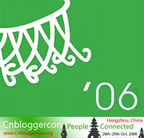
CREATIVITY 2.0
CREATIVITY 2.0: Rotterdam Satellite of the 2nd Chinese Bloggers Conference :: V2_ (Rotterdam) :: Saturday October 28, 2006 :; 10.00 – 13.00 (CEST - Central European Summer Time) :: realmedia stream: www.v2.nl (rtsp://helix.v2.nl/encoder/cnblog_nl.rm) :: IRC channel at irc://irc.freenode.net/#cnbloggercon.
V2_ invites you to participate in CREATIVITY 2.0, an extra-territorial Tangent_Event taking place in Rotterdam connecting to the 2nd Chinese Bloggers Conference, in Hangzhou China October 28/29. Featuring special guest Régine Debatty in Rotterdam and cultural bloggers Zhang Qing and Gino Yu in Hangzhou, CREATIVITY 2.0 will bring together leading independent writers and curators to discuss the rise of the blog as an open medium of expression in establishing and supporting unrestricted forms of dialogue and community, both in the sense of cultural enterprise and artistic practice.
Recently, and during the past year in particular, it has become increasingly popular to use the new tools and expanded online facilities that weblogs provide in order to create new social identities, define cultural practices and create active communities beyond the physical constraints of urban or national structures. This is especially the case in countries such as the People’s Republic of China in which a new ‘middle landscape’ of an increasingly affluent and mobile citizenry has zealously and enthusiastically attuned to the latest in global technology and telecommunications. Forming a significant part of the ‘Web 2.0’ phenomenon Blogs pick up the faded myth of the Internet as a user generated space of exchange with both cultural and commercial repercussions.
Associated online tools and services such as, YouTube, Biku, Flickr and del.icio.us augment the omnipresence of Blogs into complex global communities of users linked via an infinite number of personal backgrounds, interests and goals and create new forms of social, cultural, artistic and economic networks. In areas where traditional forms of monitoring and control of information is pervasive the complexity and diversity of blogging’s reach drives the creation of new platforms and forms of expression. Blogs brought to life by anyone anytime are now creating a blogosphere rapidly replacing traditional information structures by unifying in cross-media frameworks the same mechanisms of text and visual tagging, cross-referencing of information, and opinion gathering established with the Internet over a decade ago. But how do these structures originate, who do they serve, and how are the bloggers covered by ‘traditional’ or local media? Beyond global entertainment and free-for-all journalism can Blogs instill new cultural identities and open up new zones of dialogue and critique? Can they lead to cultural and artistic production per se, or drown in parody and hasty mash-ups during their authors’ 5 minute bursts of fame?
CREATIVITY 2.0 links the worlds of blogging between Europe, Asia and beyond in a live and online dialogue hosting players including Régine Debatty, Zhang Qing, Gino Yu, aaajiao and Kuang Huang who are active in defining and sharpening both active art communities and establishing new contexts for transnational cultural dialogue.
CREATIVITY 2.0 will be moderated in Rotterdam by V2_ program curator Stephen Kovats, and in Hangzhou by writer and cultural theorist Tian Sun.
The event will be streamed live using REAL MEDIA and IRC moderated online by Berlin based independent curator Vera Tollmann. The stream can be accessed directly via www.v2.nl or by using the following direct REAL player link: rtsp://helix.v2.nl/encoder/cnblog_nl.rm You can download a free Real Player at www.real.com. If you are online we invite you to participate in the event via IRC text chat on: irc://irc.freenode.net/#cnbloggercon
Schedule and Format:
V2_Institute for the Unstable Media, Rotterdam
Saturday October 28, 2006
10.00 Doors open at V2_, welcome coffee
10.30 CREATIVITY 2.0 intro + selected Chinese videoblog screening
11.00 – go live, online with Hangzhou – Stephen Kovats and Tian Sun
11.05 – speaker 1: Zhang Qing, in Hangzhou
11.15 – speaker 2: Régine Debatty, in Rotterdam
11.25 – speaker 3: Gino Yu, in Hangzhou
11.35 – open discussion with local and online participants 12.00 – close connection 12.00 – 13.00 discussion/conclusion at V2_, with screenings All times listed are local Rotterdam times (CEST)
To check your time zone, please consult:
http://www.timeanddate.com/worldclock/converter.html
V2_ will also be streaming the entire conference in Hangzhou and will moderate online selected presentations and discussions. Check the conference site for full schedule: http://cnbloggercon.org/2006/en/Schedule NOTE!: Most areas (but not China!) will revert to Standard Time at 0300 on Sunday October 29. Check if your area has a Daylight Saving Time shift during the conference weekend: http://www.timeanddate.com/time/dst2006b.html
CREATIVITY 2.0 Participants:
Régine Debatty (panelist, in Rotterdam): Régine Debatty initiated we-make-money-not-art.com a pioneering weblog for critical media art and cultural discourse. She studied Classics in Belgium and England, worked as a teacher of Latin and ancient Greek, then moved to media, directing documentaries for Belgian national TV, working as a reporter for the radio Onda Cero in Spain and as a consultant for the MEDIA programme of the European Commission in Italy. She is now an independent writer and researcher in electronic art. As a jury member she participates in several new media art and interaction design commissions and festivals. She also gives talks about how today's artists, amateurs and hackers are using and misusing emerging technologies.
Gino Yu (panellist, in Hangzhou): Dr. Gino Yu is chairman of the Hong Kong Digital Entertainment Assocation. He received his PhD at the University of California at Berkeley in 1993 where he worked to establish multimedia initiatives such as the Integrated Media Systems Center. He later taught and worked in Hong Kong where he helped to establish the Center for Enhanced Learning Technologies at the University of Science and Technology and the Multimedia Innovation Centre at the Hong Kong Polytechnic University (PolyU), a leading edge think tank and research centre on digital entertainment. He is currently an Associate Professor and Director of Digital Entertainment and Game Development in the School of Design at PolyU where he oversees MERECL, a commercial digital entertainment entity that provides consulting, research, instruction and new ideas for the industry. His main area research interests involve the application of media technologies to cultivate creativity and promote enlightened consciousness.
Zhang Qing (panelist, in Hangzhou): Zhang Qing is Artistic Director of the 6th Shanghai Biennale (Hyper Design), Deputy Director of the Shanghai Art Museum editor and editor of Art China . He has been a regular contributor to magazines including Art Monthly, Dushu , Avant-garde Today and Shanghai Culture since 1989, as well as editor-in-chief of the magazine Chinese Art of the 1990s. In 2000, he was named one of the "best curators in China" by CCTV. His main curatorial roles include Curator of the exhibition The Art of Yan Peiming (Shanghai,2005); Co-Curator for the 5th Shanghai Biennale(2004); Curator for Interpreting the Modern: The Collection Exhibition of Amsterdam Art Museum (Amsterdam, Shanghai, Singapore, 2003);Junction:Architectural xperiments in Chinese Contemporary Art (Shanghai, 2003); Red China: Exhibition of Chinese Contemporary Art , (Gwangju, 2002); Co-Curator for City_Net Asia (Seoul, 2002); Curator for Cai Guoqiang (Shanghai, 2001); Curator for Expressions of Contemporary China (Singapore, 2001); and Co-Curator for the 3 rd Shanghai Biennale (2000).
aaajiao (participant, in Hangzhou): The Chinese pendant to Régine Debatty’s media art and culture blog
Kuan Huang (online participant, New York): Kuan Huang is a software engineer and new media artist. In 2004, in order to let his artistic side of his brain breathe the freedom of life, he came to New York City to pursue his master degree in Interactive Telecommunications Program of Tisch School of Art, New York University. His art works vary from interactive musical instrument, cell phone based video installation, interactive public projection and etc. His works have been exhibited in Sony Wonder Tech Lab, Chelsea Museum of Art, Eyebeam and New York University. Kuan Huang together with Yuchen Chiu and Chun Xi Jiang are the founders of the Chinese new media art blog Villagypsy. They are hoping that Villagypsy can serve as a bridge that links the new media industry between USA and China.
Tian Sun (moderator, in Hangzhou): Tian Sun is editor of Time+Architecture, a Shanghai-based bimonthly architectural magazine. She graduated from B. Arch. Tongji University in 2000 and received her MSc in Architectural History at the University College London in 2005.
Stephen Kovats (moderator, in Rotterdam): Canadian architect and media culture researcher Stephen Kovats is chief curator and events programmer at V2_Institute for the Unstable Media in Rotterdam.
Vera Tollmann (online moderator, Rotterdam): Vera Tollmann studied Cultural Studies in Hildesheim and Liverpool. From 2004 to 2006 she worked as programme curator for the international media art festival transmediale in Berlin. As an independant curator, she recently curated the group exhibition Hands-on history and the video programme Picturing free knowledge. She publishes articles on internet issues and contemporary art. Her text 'I will chocolate you' deals with the internet use in China and the role of the western world, published in springerin.
More info:
www.v2.nl
http://cnbloggercon.org/
http://cnbloggercon.org/2006/en/Schedule
V2_Institute for the Unstable Media
Stephen Kovats_Program Curator
Eendrachtsstraat 10
3012 XL Rotterdam
The Netherlands
t_ **31 10 750 1519
f_ **31 10 206 7271
e_ kovats[at]v2.nl
CREATIVITY 2.0
2nd China Bloggers Conference
V2_Rotterdam Satellite
Saturday October 28, 10.00 - 14.00 (CEST)
realmedia stream: www.v2.nl (rtsp://helix.v2.nl/encoder/cnblog_nl.rm)
IRC channel at irc://irc.freenode.net/#cnbloggercon
entire conference: http://cnbloggercon.org/2006/en
Posted by jo at 02:08 PM | Comments (0)
Paul Chan at

PORTIKUS
Paul Chan :: Opening: October 27, 2006, 8 p.m. :: Exhibition: Oct 28 – Dec 3, 2006 :: Press Talk: Oct 27, 2006, 11 a.m. :: PORTIKUS :: Alte Brücke 2 Maininsel, 60594 Frankfurt am Main, Germany :: Telephone +49 69 962 44 54-0 Fax +49 69 962 44 54-24.
The Portikus in Frankfurt am Main proudly presents Paul Chan’s first exhibition in Germany. Born in Hong Kong in 1973 and educated in the US, he has established himself as an important international artist. In the wake of 9/11 and the war in Iraq, Chan has become a key figure both in the American art world and in the world of political activism. He is also an artist who emphasizes what is specific of these two spheres.
Like fleeting shadows on the ground, we see objects defying gravity. Sunglasses, cars, people—everything is falling against a backdrop in shifting colours. But what appears to be simple shadows are digital animations projected on the floor—a recurring feature in Chan’s ongoing series The 7 Lights. Portikus presents 3rd Light, the first part to also involve a sculptural element: a 3-dimensional replica of the table in Leonardo da Vinci’s Last Supper. This ingredient emphasizes the theological quality already strongly felt in the previous chapters, and the first falling object to appear is an apple, followed by chairs and dogs. In spite of the calm and meditative atmosphere, this seems to be a work about a world falling apart. Here the world seems to end in silence.
Paul Chan creates films, animations and works with references to Goya as well as to Japanese pornography, to the Bible as well as to the Samuel Beckett. Previously this year he participated in the Whitney Biennial. Other recent exhibitions include a solo show at the ICA in Boston (2005), ‘Uncertain States of America,’ at Astrup Fearnley Museum of Modern Art in Oslo (2005), the Lyon Biennial (2005), and the ‘Greater New York’ at PS 1 in New York (2005).
This exhibition is accompanied by a catalogue produced together with Magasin 3 Stockholm Konsthall, where the artist currently presents other key works. Portikus’ and Magasin 3’s joint venture is the artist’s first institutional solo presentation in Europe.
Posted by jo at 02:01 PM | Comments (0)
Turbulence Artist’s Studio:
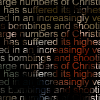
"Headlines" by Michael Takeo Magruder
Turbulence Artists' Studios: Headlines by Michael Takeo Magruder [Needs Flash Player 7] :: Headlines examines the mediated histories generated by today’s news corporations and reflects upon our collective preoccupation with real-time information generation, distribution and access. Given the developed world’s countless network structures and our current state of data saturation, has news media evolved beyond mere information source and become a new form of cultural stimulant?
Headlines was created for OOG, a commentary and opinion platform for the online edition of De Volkskrant a major Dutch daily national newspaper. "OOG" began in September 2005 as a platform in which every week a different artist working in sound and image is asked to respond to news and current affairs. The selection of artists participating has grown into a varied group of national and international artists working with very different forms of expertise and approaches. In this way, artists are using their skills to become commentators on events in a news environment. After each week, the work is placed in the archive.
The artists participating in "OOG" are a diverse and renowned group of applied and autonomous artists both from inside and outside The Netherlands. "OOG" is one of the most visited pages within the Volkskrant website with weekly visits of 3,000-5,000.
BIOGRAPHY
Michael Takeo Magruder is an American artist based in the UK deploying New and Technological Media within Fine Art contexts. He graduated from the University of Virginia in 1996 receiving a BA (Hons) in Biological Science. He is a long-standing member of King's Visualization Lab in the Centre for Computing in Humanities, King's College London. Through this organization he undertakes research, development and implementation of emerging technologies; including motion capture, immersive space and virtual environments, for use in contemporary creative and academic practice.
Takeo’s artworks have been showcased in over 150 exhibitions and 25 countries, including venues such as the Courtauld Institute of Art, London, EAST International 2005, Tokyo Metropolitan Museum of Photography and Trans-Media-Akademie Hellerau. His works are regular inclusions in international New Media festivals, such as Cybersonica, CYNETart, FILE, Filmwinter, SeNef, Siggraph and Split. His artistic practice has been funded directly by Arts Council England, The National Endowment for the Arts, USA and numerous public galleries both within the UK and abroad. He is also recognized for his on-line arts practice and has been commissioned by leading portals for Internet Art such as Turbulence.org and Soundtoys.net. As artist/curator, he has been responsible for the internationally-renowned touring exhibitions, Net:Reality, the Cyber-Kitchen and Spectrum.
Artistically, his current interests concern the simultaneous utilization and dissection of new technology as a means to explore the formal structures and conceptual paradigms of the digital realm. He seeks to create artworks in which there are no divisions between technologies, aesthetics, and concepts.
Posted by jo at 11:16 AM | Comments (0)
Katy Shepherd's
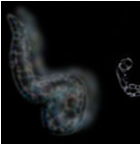
Vitreous Humour Project
In this age of "high definition" I have taken a contrary interest in technology's failings, for example the way certain camera film has colour biases, scratches and glitches on the surface / distortions of brightness and contrast / flickering / dropped frames when a computer plays back. Consequently I have developed a fascination in the parallel limitations of an artist as a fallible mortal, in particular the inadequacies of memory and eyesight.
Is it a common held belief that an artist is born with the talent to see the world differently to others? - more vividly perhaps, a heightened experience? - with more insight? - they are more visually aware? - they are gifted? They are able to see beauty and design where others see the everyday? An onerous responsibility I think. What are the public's expectations of an artist?
The Vitreous Humour project will allow people to explore these beliefs (myths?) by enabling them to view their own images through the eyes of an artist - my eyes.
I have particles in my eyes called floaters that move around in the fluid of my eyes - the vitreous humour. They are very common, many people have them but of course each person's are individual to themselves. "Floaters" are the shadows cast on the retina of the microscopic structures in the vitreous humour. Some of these may be due to condensations of vitreous collagen which degenerates with age - creating increasing numbers of floaters. These may look like specks, worms, single or clumped, hair - like, forms. Others may be remnants of debris from the hyaloid artery that nourishes the eye of the foetus but starts to disintegrate by the seventh month of development. It disappears by birth bar a small amount of debris inside the eye.
Floaters are easier to see if you lie on a bed and look at a diffusely illuminated ceiling or a bright sky. However they are constantly falling away from the centre of the eye so can only be seen clearly for a brief moment. If your eyes move more quickly the floaters will flick around your eye, rushing to keep up with the movement but always slightly behind or overshooting it. This flickering movement gave rise to the latin name - muscae volitantes - fluttering flies.
I have attempted to create my own elusive shadows as digital entities. "Vitreous Humour" the film is an animation of my eyes examining , in close up, a family snap of myself as a new born baby (taken 1961). The photo appears as if seen through my eyes. It is a self portrait - of sorts.
Secondly there is a program to download that enables you to view your own images as if through my eyes. It will certainly be a unique vision but whether this will enhance or degrade the image I couldn't say.
Posted by jo at 10:02 AM | Comments (0)
Gail Wight
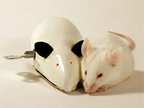
Sliding Scale
Stanford, CA-The Department of Art & Art History at Stanford University is pleased to present Sliding Scale: Gail Wight, an exhibition that opens November 7, on view through December 10, 2006 at the Thomas Welton Stanford Art Gallery where a reception will take place on November 10 with honored guest, Gail Wight.
When conducting an experiment a scientist should always control as many variables as possible, reducing the object of the investigation to the one aspect she is seeking to understand. This insight has been the great strength of the scientific method; it has allowed enormous increases in our understanding of the world through the summation of millions of tiny investigations. As we have become increasingly aware in the last fifty years, however, conducting research at such a level of abstraction is also science’s most dangerous weakness. In “Sliding Scale,” Gail Wight’s art playfully resists the dematerialization of the objects of scientific investigation. Mice eat through a representation of their genome, butterflies struggle to escape their pins, and beetles tell their stories.
Wight’s art simultaneously takes on the two great flaws of abstract scientific thinking—oversimplification and loss of perspective. In Crossing a live mouse plays with a robotic one, and the viewer is left marveling at the incredible complexity of the living being. Recursive Mutations gives a muse the chance to redesign it own genome through its interaction with the paper it lived on. With humor, “Sliding Scale” asks the viewer what has been lost in abstracting a mouse to its genes or to a mechanical prototype that replicates only some of its functions. As viewers zoom in and out with The Meaning of Miniscule they find that where they end up is not where they began. And Kings Play Cards reminds us all that no field, including science, is exempt from the lure of the hot new thing or the enticement of corporate dollars. Wight’s art prompts viewers to see the objects of scientific research and the larger field of science in a new and different light.
Through “Sliding Scale” Gail Wight will be adding her voice to the conference, "Imaging Environment: Maps, Models, Metaphors," November 8-10 at the Stanford Humanities Center, which brings together scholars from the sciences and the humanities to consider how the environment shapes how we study and use it.
VISITOR INFORMATION: Thomas Welton Stanford Art Gallery is open Tuesday through Friday, 10 am – 5 pm and Saturday and Sunday, 1-5 pm. Admission is free. The Gallery is located on the Stanford campus, off Palm Drive at 435 Lasuen Mall. Parking is free after 4 pm and all day on weekends. Information: 650-723-3404, www.art.stanford.edu
Posted by jo at 09:44 AM | Comments (0)
UPGRADE! BOSTON:
![]()
Will Pappenheimer
UPGRADE! BOSTON: Will Pappenheimer :: WHEN: October 26, 7:00-9:00 p.m. :: WHERE: Art Interactive, 130 Bishop Allen Drive, at the corner of Prospect Street, Cambridge. Free parking in the lot on the corner or take the T to Central Square and walk 1 block.
WILL PAPPENHEIMER is currently an assistant professor of Digital Media at Pace University. He received his MFA from the Museum School/Tufts University, Boston and BA from Harvard. His work in video, mixed media, installation and new media has been exhibited in over 50 solo and group exhibitions internationally, including the The ICA (Boston), the Stedman Art Gallery (NJ), Exit Art, New York, "immedia: 1901," MI, "Free Biennial," New York and Art Basel Miami Beach 2003. Recent work resulting from collaborations with New Media theorist Gregory Ulmer has been the subject of articles in Visual Culture, ArtUS and a chapter of Ulmer's 2005 book, "Electronic Monumentality."
Pappenheimer’s recent projects reconfiguring webcam and home surveillance networks have been presented at "Interactive Futures05" in British Columbia, FILE 2005 in Sao Paulo, Brazil and ISEA 2006/ZeroOne at the San Jose Musem of Art (CA). He was recently chosen for one of the School of the Museum of Fine Arts’ prestigious Traveling Scholars Awards and will exhibit work from this grant at the Museum of Fine Arts, Boston in 2008. http://willpap-projects.com/
Upgrade! Boston is curated by Jo-Anne Green for Turbulence.org in partnership with Art Interactive. It is one of 22 nodes currently active in Upgrade! International, an emerging network of autonomous nodes united by art, technology, and a commitment to bridging cultural divides. If you would like to present your work or get involved, please email jo[at]turbulence.org.
Posted by jo at 09:30 AM | Comments (0)
Make your own Wearable Workshop

smart clothing for smart users
Make your own Wearable Workshop
smart clothing for smart users
10November2006>12November2006
Amsterdam, Mediamatic
Oosterdokskade 5
Amsterdam
T 020 638 9901
www.mediamatic.net
10:00 hr, from 10.11.06 t/m 12.11.06
Tiny chips, cheap sensors and the possibilities of emerging smart fabrics, conductive yarns and cheap wireless communication (bluetooth or even rfid) make wearables easier and cheaper to make. Arduino boards are small physical computing platforms: Arduino developed a fairly simple integrated development environment to deal with the small portable input/output board. With all these tools at our fingertips, nothing is stopping us from making our own smart coats, reactive hats and luminescent skirts.
To help you get started, Mediamatic is organizing a wearables workshop where you can develop your own Arduino-driven wearable. Assisted by Massimo Banzi, one of the creators of the Arduino board and several coding/soldering/sewing helpers, you have three days to make your prototype in the stimulating surroundings of the Mediamatic Winter Garden.
What?
During the workshop, you will design your own wearable. You will define the sensor inputs and the actuator outputs. You will program the Arduino board to react correctly to the different inputs. You will do this in Arduino's own IDE, which helps you write a kind of simplified Java code similar to Processing. Then you will stitch/glue/felt together your prototype so you can participate in the wearables fashion show!
Who?
Computer scientists, fashion designers, hardware hackers, art students, fabric experts, product developers, dancers- everyone is welcome. However, note that some technical affinity is required. Some experience in programming and electronics is useful, specifically in soldering and java, but not strictly necessary. We would advice participants to come in teams of max. 3 people, so you can distribute soldering, coding and sewing tasks.
Where?
The workshop will take place in the latest Mediamatic exhibition: the Winter Garden. The Winter Garden is an indoor botanical garden filled with plants and robots. From the minimalistic electronic creatures of Ralf Schreiber to the virtual forest of Michiel Samyn to the interactive plant by Christa Sommerer and
Laurent Mignonneau to the pheromone tinged garden benches of Mateusz Herczka and the communicative crickets of Felix Hess- the Winter Garden is full of wonders.
What to bring?
If there is a specific sensor or actuator you would like to use during the workshop, we advise you to bring it yourself. You can also bring the actual clothing article beforehand, and not sew it during the workshop, or you can bring fabric and other material for the base of your wearable. You'll have to bring your own laptop to do your coding, and we advise you to download the Arduino software and have a look at it beforehand. Also, bring lunch.
How to prepare?
Besides looking at the Arduino software you can have a look at the Mediamatic wearables reader - a collection of interesting articles, websites and blogposts that can get you started in the world of wearables. Virtual Platform and V2 are organizing a wearables symposium in Rotterdam called Fleshing Out the day before the Mediamatic Arduino workshop with speakers such as Ionat Zurr (SymbioticA: the art and science collaborative research laboratory), Tobie Kerridge (Royal College of Art, London) and Joanna Berzowska (Design and Computation Arts , Concordia University, Montreal).
When?
The Fleshing Out Symposium is on Thursday November 9th at V2. The Mediamatic Arduino Wearables Workshop is from Friday November 10th to Sunday November 12th. The Kiem Cuisine Wearables dinner is Friday at 19:30 at Mediamatic. The Wearables fashion show is Sunday evening at 18:00.
Costs?
The Fleshing out symposium costs 40 euros. Students receive a discount of 20 euros. The Wearable Arduino workshop costs 125 euros. Dutch students receive a discount of 50 euros.
register at www.mediamatic.net/workshopregistration
Posted by luis at 08:49 AM | Comments (0)
LIMINAL SPACES/

grenzraeume
LIMINAL SPACES/ grenzraeume :: GfZK Leipzig, 28 October 2006 – 21 January 2007 :: Exhibition opening: 27 October, from 19.00 pm :: Gallery Open: Tue-Sat 14.00 – 19.00 pm/ Sunday 12.00 – 19.00 pm.
LIMINAL SPACES/ grenzraeume originated from an initiative of individual Palestinian and Israeli artists united in their opposition to the destructive dynamics and ever growing hardship and deprivation of basic civil and political rights endured by Palestinians under Israeli occupation. An unprecedented network of artists, curators and cultural producers emerged, meeting often under difficult circumstances, despite the harsh context of ever increasing violence and the complete collapse of the political peace process. LIMINAL SPACES/ grenzraeume, a project by the Palestinian Association of Contemporary Arts (PACA), Ramallah, The Israeli Centre for Digital Art, Holon and the University of the Arts, Berlin wishes to support and strengthen this informal network and its stance.
In March 2006, the project invited Palestinian, European and Israeli artists, architects, academics and film makers to examine the condition of everyday space, borders, physical segregation, cultural territories within a reality of occupation and challenge the possibilities of art as a catalyst for political and social change. The foc! us of th e project is the radically divided and fragmented urban region of Jerusalem/ Ramallah, which has become a laboratory for an urbanism of radical ethnic segregation. Curators, cultural figures and artists developed this project through a series of meetings and discussions that sought to generate a more active political engagement of the art sector. Additionally, it is hoped that through participation in the project, new possibilities of contact and exchange will emerge on an individual basis and beyond.
The project was launched with a conference in March, 2006, in the area of the Qalandiya checkpoint between Jerusalem and Ramallah, followed by individual residencies which gave artists the opportunity to research tactics and artistic strategies for addressing the physiognomy of specific sites and their everyday operations and adhering to exposing spatial and contextual politics of the Israeli occupation. The perception of the frontiers were investigated, and their accessibility, permeability and potential as contact and communication zones challenged. Artists employed new forms of creative practice adopting and subverting contemporary technology and systems of media communication, underlining the central role played by technology in the shaping of the physical borders.
The process resulted in over 20 new works, which are now being shown to the public for the very first time! The future library spaces of the Gallery for Contemporary Arts Leipzig (GfZK), including the already acquired shelves of Vito Acconci’s library installation at Documenta 10, provide an unusual exhibition context and generate mutual resonances between LIMINAL SPACES/ grenzraeume as an evolving archive of research and production in the Middle East and the GfZK’s declared ambition to build up a public library.
Participating artists: Jumana Emil Abboud, Sameh Abboushi, Azra Aksamija, Ayreen Anastas und Rene Gabri, Yochai Avrahami, Yael Bartana, Peter Friedl, Hagar Goren, Inass Hamad, Sandi Hilal and Alessandro Petti, Khalid Horani, Sabine Horlitz and Oliver Clemens, Ligna, Suleiman Mansour, Oren Sagiv, Sala-Manca Group, Miri Segal, Sean Snyder, Superflex, Simon Wachsmuth
Curatorial Advisors: Khalid Horani, Andreja Hribernik, Barbara Steiner, in cooperation with Interdisziplinäres Projekt-Forum (Wolfgang Knapp) of the University of the Arts Berlin/ Institute for Art and Context
Curated by: Eyal Danon, Galit Eilat, Reem Fadda, Philipp Misselwitz
Screening program:
2 November 2006
20.00 pm CINEMA: >Trespassing<, selection of Israeli short films and videos curated by Eyal Danon: Artists without Walls, >April 1st< (19'30'', 2004) // Avi Mograbi, >Details 3&4< (9', 2004) // Annan Tzukerman, >Anxious Escapism< (26', 2005) // Ruti Sela & Ma'ayan Amir, >Beyond guilt #2< (18', 2004) // Ruti Sela & Ma'ayan Amir, >Alei Zahav after Aliza Begin< (5'30'', 2005) // Nira Pereg, >Souvenir< (5', 2005) // Ruti Sela & Clil Nadav, >Loopolice< (6'55'', 2003). An event organized for the Friends of the GfZK Leipzig.
7 December 2006
20.00 pm CINEMA: >Pasolini Pa* Palestine< by Ayreen Anastas (Jerusalem, 2003). An event organized for the Friends of the GfZK Leipzig.
4 January 2007
20.00 pm CINEMA: >Quelques Miettes Pour Les Oiseaux - Some Crumbs for the Birds< by Annemarie Jacir (France/ Jordan, 2005) and >Avenge But One Of My Two Eyes< by Avi Mograbi (Israel, 2005). An event organized for the Friends of the GfZK Leipzig.
International Workshop (28.10 – 29.10)
The opening of the exhibition will be accompanied by an international workshop, which will explore political and social responsibilities of art production, dis! cussing current trends that are changing the role of institutions, artists, curators and activists. The conference will explore the notion of 'responsibility' in the context of the Middle East - characterised by the escalation of violence and violations of human and civil rights, the continuation of the military occupation, the building of an apartheid wall and complete breakdown of the peace process – as well as in the context of Post-Fordist Central Europe where the erosion of social democratic principles challenges artists and institutions to survive in a harsher social climate and fight for the acceptance and the engagement of a wider public.
In Hebrew, the word responsibility (acherayut) contains within it the word acher, which means ‘other’ or ‘different.’ It also contains the word achrey, which means ‘after’ or ‘following an event or act.’ In English, the word ‘responsibility’ contains within it the word ‘response’ (originating from the old French responsun meaning ‘something offered in return’). There is a delicacy in the English language through prepositions following the word ‘responsibility’ as one can be responsible for something or responsible to someone. In Arabic, the word mas’uliyah contains within it the verb su’ila, which literally means to require a response. In all three languages, we find a unified stance which states that responsibility is linked to responding or answering an external other. How may we respond or answer the contemporary demand for a responsibility to another or a different worldview? How may we take responsibility or act differently as cultural producers and/or cultural consumers? Participants will include the artists of the project LIMINAL SPACES/ grenzr! aeume as well as international guests.
DAY 1 (Saturday, 28 October 2006)
Forum 1: Reflections on the LIMINAL SPACES project
Moderator: Francis McKee
11.00 am Short presentations by artists participating in the LIMINAL SPACES project
13:30 pm Lunch Break (for invited participants only)
15.00 pm Project presentation by the curators: Reem Fadda, Philipp Misselwitz, Eyal Danon and Galit Eilat.
16.00 pm Open session
17.00 pm Coffee Break
17.30 pm Panel discussion - Cultural Territories: Wolfgang Knapp, Salwa Mikdadi, Nina Möntmann, Erzen Shkololli, Hito Steyerl
18:30 pm Conclusion
19:00 pm Joint dinner (for invited participants only) followed by party
DAY 2 (Sunday, 29 October 2006)
Forum 2: Crisis and Potentials of Institutions (The Middle East, Near East and Europe)
Moderator: Francis McKee
11.00 am Nina Möntmann: Art and its Institutions – Current Conflict, Critique and Collaborations
11.30 am Case study 1: Jumana Emil Abboud: Al Mamal Foundation, East Jerusalem. The establishment of The Museum of Contemporary Art – Palestine (CAMP)
12.00 am Case study 2: Eyal Danon: Jaffa – An Autobiography of a City. Untold stories of different national, ethnic, religious and gender groups within Israel
12.30 am Case study 3: Boris Buden: EIPCP – European Institute for Progressive Cultural Policies
13.00 pm Case study 4: Salwa Mikdadi: Institutionalization of Art Practice under Occupation/Palestinian Artists Working Under Siege (West Bank, East Jerusalem and Gaza)
13.30 pm Case study 5: Erzen Shkololli: Exit Institute for Contemporary Art in Peja, Kosovo – the dramatic transformation of the region, connected in particular with the disintegration of the local totalitarian regimes during the 1990s
14:00 pm Lunch Break (for invited participants only)
15.30 pm Open session
16.30 pm Conclusion
Partners: LIMINAL SPACES/ grenzraeume has been jointly organized by the Palestinian Association of Contemporary Art (PACA), Digital A! rt Lab, Holon and the University of the Arts, Berlin.
The Palestinian Association for Contemporary Arts - PACA
Reem Fadda, Director
Aref Al-Aref House
Behind Arab Bank Al-Bireh
Al-Nahdah Street
Ramallah, Palestine
T: +972 2 2951849
F: +972 2 2967601
E: reemfadda[at]gmail.com
The Israeli Centre for Digital Art Holon
Galit Eilat, Director
Digital Art Lab
16 Yirmiyahu st
Holon 58373
Israel
T +972 3 5568792
F +972 3 5580003
E galit[at]digitalartlab.org.il
Web www.digitalartlab.org.il
Universität der Künste Berlin
Philipp Misselwitz (Lehrstuhl Prof. Peter Bayerer) and Wolfgang Knapp (Interdisziplinäres Projekt-Forum der Universität der Künste Berlin)
Hardenbergstraße 33
10623 Berlin
T +49 177 4107168
E misselwitz[at]studio-uc.net
The exhibition and conference is made possible by:
Kulturstiftung des Bundes
Robert Bosch Stiftung
European Cultural Foundation
Heinrich Böll Stiftung Ramallah
Goethe Institut Jerusalem
Posted by jo at 08:27 AM | Comments (0)
October 23, 2006
HABITATS

A 4 Day Cultural Festival
HABITATS: a 4 day Cultural Festival :: Artists, scientists, and cultural commentators are joining together to create a collective vision of a sustainable habitat. The Habitats conference and festival is a 4 day event organized to promote an exchange between art, technology, and environment. With public and private cooperative efforts leading to cleaner water, the Gowanus Canal area has experienced an increase in wildlife and improved prospects for commercial and cultural revitalization. Habitats celebrates this process. Instigated by Eidolon Culture, The Habitats conferences will include speakers such as best-selling author Steven Johnson (“Emergence” and “Mind Wide Open,”); long-standing community organizers such as the Gowanus Canal Community Development Corporation (GCCDC) ; electronic artists such as Pauline Oliveros (Deep Listening Foundation) ; site specific sound and video recordings, live music performances, site specific installations, collaborative projects, recycled art, workshops and active audience participation.
The placement of the artworks in their site-specific rendition, the sharing of thought provoking ideas of contemporary cultural relevance, and the active role of audience interaction all create a “Habitat” -- a place defined by the indispensable nature of everyone and everything within it. Habitats is being Presented by Eidolon Culture and Sponsored by the Brooklyn Arts Council, Polytechnic University: Integrated Digital Media Institute (IDMI), CEC Arts Link, New York State Council on the Arts, and Material for the Arts.
Date: November 9th – 12th , 2006
Time: Programs begin daily at 12:00pm until 11pm
Location: The Brooklyn Lyceum 227 4th Ave, Brooklyn, NY 11215
N Train to Union Street, Corner of President Street
Contact: mwarren[at]eidolon.org
Admission: $5 for environmental + cultural conferences, $15 for live performance program
www.global-habitat.net
ArT. ENVirONMENT. CULTUrE. COMMUNiTY. gOWANUS
CONfirMED CULTUrAL SPEAKErS
Steven Johnson – author of “Emergence, the connected lives of ants, brains and cities”
Douglas Rushkoff – author of “Media Virus”
Peter Principle of Tuxedomoon
Daniel Pinchbeck – author of “Breaking Open the Head”
ENVirONMENTAL CONfErENCE
Coordinated by: Gowanus Canal Community Development Corp
COMMUNiTY ArTS AND WOrKSHOPS
Carol Caputo, IRUBNY
Walking Tours of Gowanus with NY Acoustic Ecology
Workshop with the Prospect Park Zoo
iNSTALLATiON/ PErfOrMANCE ArTiSTS
Pauline Oliveros, Deep Listening Foundation
Amoeba Technology, NYC
Kim Holleman, NYC
David Linton of Unity Gain
Bill Etra, NYC
Michael Schumacher of Diapason Gallery
free103.9, NYC
Share, NYC
Keiko Uneshi, NYC
Disney NasaBorg, NYC
Harlan Emil, NYC
2012, sponsored by CEC Arts Link
Project503, Russia
Antartic Project, Russia
Efi Amantidou, Greece
Luis Maurette, Argentina
Klauss, Argentina
Eva Sjuve, Sweden
Ken Hiratsuka, Japan
Also… Zarah Cabanias, Hans-Christoph Steiner,
Kathi von Koerber, Marianna Ellenberg, Lary Seven,
Zemi17, Peripheral Media, Claire Barrett, Ne(x)twork
GCCDC is a neighborhood preservation non-profit organization dedicated to the
revitalization of the Gowanus Canal area in South Brooklyn, New York, for twentyfour years. A community-based group with an extensive record of initiatives and involvement in the physical improvement of the Gowanus Canal, Red Hook and Carroll Gardens communities. GCCDC’s efforts are focused on the environmental remediation of the Gowanus Canal, housing, economic development, and commercial revitalization.
Eidolon Culture is a Brooklyn based non-profit arts organization, directing and producing onsite and online platforms for interdisciplinary projects, bridging the gaps of specialization between disciplines and geographical distances. Eidolon Culture focuses on the potential for creative activity at the intersections of art, technology, and culture. Eidolon Cultures identity is based on interactive sustainable business practices, promoting collaboration and partnerships between government, industry, foundations, non-governmental organisations and the general public.
FOR aDDitiONaL iNFORMatiON pLease visit www.global-habitat.net. Day aND eveNiNg pROgRaM scHeDuLe aND DetaiLs wiLL sOON be avaiLabLe.
Posted by jo at 05:58 PM | Comments (0)
Tagzania's Spanish Architecture on Google Earth
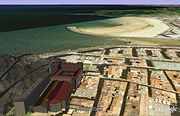
Venice Architecture Biennale
The Spanish Pavillion at the Venice Architecture Biennale commissioned Tagzania and its parent company, CodeSyntax, to develop several architectural models for Google Earth, and produce a set of videos using Google Earth flights.
The installation consists of 16 screens geographically organised: 16 simultaneous and synchronized 3-min videos are shown on those screens. 13 of the screens have a 3D architectural model on it, developed with Sketchup, and transplanted to the Google Earth scenario. Two more screens shown urban plans in 2D, as flat layers over Google Maps. One of the screens has no project to show, but the city of Palma de Mallorca needed to be there, so the panel with all screens made geographic sense, and therefore a series of pictures from the city Cathedral are visible in that particular flight. Several target cities in Spain where models had to be developed lacked hi-resolution imagery at Google Earth, so aditional ortophotographic layers were added to film the videos. These are the locations of the projects:
http://www.tagzania.com/user/tagzania/biennale.
Flights show the buildings in close detail, and there are also some context changes in the videos, all screens go to Madrid, Barcelona and Venice, first from a distance and then zooming into great detail: in those close positions, Google Earth's pool of information layers and pinpoints is visible in the videos. All positions made sense with the screen arrangements in the panel...
About Tagzania: Tagzania is a site for bookmarking places in a map. It's interface is mainly flat, 2D views served by Google Maps thru their API. However, all points uploaded to Tagzania, and the collections of places organised by users or tags, have dinamic links to Google Earth. Anyway, developing 3D models didn't have much to do with our site's conception... Until now, at least.
The explosion of map mashups, geotagging, geography 2.0 we may say, has had a clear impact so far. Latitude and longitude are no longer terms exclusive to cartographers. They're in the hands of common net users.
Now, tools like Sketchup, Google Earth and the competitors of Google may have an impact in architecture, civil engineering and 3D design as well. Tools like Tagzania will not substitute professional cartography or architecture, but may make those realms accessible to myriads of users. There's space for all in Internet, and we all shall create, share and build our own spaces (geographic, architectural, urban spaces) on the web.
Posted by jo at 05:49 PM | Comments (0)
KEVIN HAMILTON

Bulletin No. 9
1. WEBSITE :: This week sees the launch of a new homepage, including documentation of new projects, more information on old projects, works rarely seen, video, sound and writing. I hope you'll take some time to have a look around, and perhaps pass some links along to someone else. This site will be updated fairly often - not as a blog exactly, but as you'll see there are some new ways to keep up with where and what I'm up to.
2. MIRROR SITE :: Also this week, a new sited project launched in Boston and Urbana, a live image/video link between spaces at Brandeis University and the Siebel Center for Computer Science here at University of Illinois. Visitors to the two spaces will experience an occasional, temporal window that opens between the two sites. The project was invited as part of the exhibition Balance and Power: Performance and Surveillance in Video Art, which is currently on display at Brandeis' Rose Museum of Art.
3. PUBLIC TALK IN BOSTON :: In connection with the Balance and Power exhibition I'll be in Boston for a public conversation/discussion with curator Michael Rush, Director of the Rose Museum at Brandeis - the talk will be held on Saturday, November 4 at the Rose Art Museum. Later that week I'll be working with some classes there at Brandeis as well.
4. PUBLICATIONS :: Two recent writing projects, one long and one short, debuted in print and online. My paper for the ISEA symposium, "Absence in Common" is available for download or print-on-demand from the journal Intelligent Agent. My review for the new DVD from People Like Us is the the current issue of MIT Press' Computer Music Journal - I've also included it in full on my website.
5. OTHER PROJECTS :: The Department of Rhythmanalysis met with some good mentions in the Chicago press (WBEZ, New City Chicago) before that exhibit's close at the end of the summer. Be sure and check out the photos on the site, and stay tuned for video documentation soon of this ongoing project.
Mobile Mapping for Everyday Spaces, a long-term research project based here at UIUC but including collaborators in Vancouver, has its own website, with some initial documentation of resulting projects. We're currently in a writing stage of the project, evaluating last Spring's efforts for informed application of what learned about pedagogy and interdisciplinary collaborations.
I've recently joined researcher Brian Bailey's project, the Science of Design, through the Department of Computer Science at UIUC. Together we received a National Science Foundation grant for development of new tools to aid in supporting rich, critical development processes for interactive art and design. In connection with this project I'll be leading a new, experimental course this Spring at UIUC that focuses on collaboration in the context of theme or content-based problems in new media and public space.
6. UPCOMING
- Panel presentation at College Art Association conference in NYC, February
- Zeno Boundary in an upcoming traveling exhibition, along with a new web presence
- CHI (Computer/Human Interaction) Workshop in San Jose in April 2007
- Paper for Interfaces symposium, UIUC in April 2007
- a mystery video project
Thank you for your time.
Kevin Hamilton
University of Illinois, Urbana-Champaign
http://kevinhamilton.org
Posted by jo at 04:26 PM | Comments (0)
KLab9:
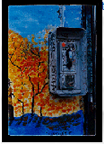
Art Call for Contributions
KLab9: Art Call for Contributions :: Technology, Authorship and Ways of Living :: A weekend gathering for collaborative and creative reflection :: 5th - 7th October, 2007 tbc. :: Institute for Advanced Studies, Lancaster University, North West England.
The Knowledge Lab is an attempt to provide a collective space for anti-capitalist reflection. It is located at the margin of the university, an institution essentially geared towards the production of knowledge as a resource for corporate interest and as justification for particular constellations of power relations. This knowledge lab will address art and ways of critically thinking about our world. Within this broad region of enquiry, the lab will encompass notions of life and art as a political commitment, the influence art can exert in politics and how political ideas in turn influence art. It will also address new ways of making art and how this relates to technologies and social changes, and the use of art as an anti-capitalist means to change and fight the system.
We hope that the knowledge lab will not merely address, but also show that art can initiate critical thinking in the various guises outlined above. Our expectations, in terms of the event, and its outcome, are that this be a sharing of creative ideas and ideas about creativity. We hope that it will draw together people with a common interest in art and alternative ways of living, but working in different fields. From this collective thinking we hope that people will be incited to realize, or make manifest, some of these ways of living and thinking creatively when they leave: We will learn from each other.
STREAMS: Like previous knowledge labs the day will be divided into four streams, each will take place in a separate room:
STREAM 1: TECHNOLOGY Free software, art spaces and interfaces, hardware, and recycling/reusing.
STREAM 2: WAYS OF LIVING Process, moment, performance, politics, gender issues, community and cultural production, personal/political, and imaginative resistance. Also we hope to see papers touching on initiatives in direct democracy; the art of changing that system, and the paradigms of inspiration.
STREAM 3: AUTHORSHIP Copy rights, ownership, patenting, and appropriation.
STREAM 4: THE ART MARKET (new ways of) curating, spaces (physical and virtual) to show art, ways of making money: Marketing, the means of production, market forces and anti-market forces, the art market, and art and ethics.
ACADEMIC PAPERS: The list above is not prescriptive, it simply outlines some of the issues we envisage arising given the titles of the four streams. Please also send papers on other themes, these will be gratefully considered. Submit an abstract of no more than 500 words. In addition please enclose a brief biography. Try to make this, along with your paper, as accessible as
possible.
WORKSHOPS, FACILITATED DISCUSSIONS, ARTWORKS AND PERFORMANCES
These will broadly tie in with, and be presented as part of, one of the four streams above. Send a proposal [Max: A single side of A4], elaborate on: What your contribution will be e.g. a workshop, a discussion, a performance, an artwork. How long you envisage it taking. Do you need any equipment or materials? Do you want to limit the number of participants? If so, how many? What do you hope will be born out of this? How do you propose to arrive at
this end?
SATURDAY EVENING: DJ and VJ session: Call for DJs and VJs to send in samples so they might come and contribute to an evening of art in many guises. Nb. Groups are welcome to contribute workshops, materials for display
INVOLVEMENT AND SKILLS SHARING: Anybody is welcome to attend the weekend, get involved in the discussions, and take part in the workshops. HOWEVER, YOU NEED TO REGISTER TO ATTEND AS THE EVENT IS LIMITED TO 100 PEOPLE, SO PLEASE GET IN TOUCH: klab9art[at]googlemail.com
If you'd like to take a more pro-active role during the conference, you might want to ADOPT a session - that is, prepare it in advance (suggest questions, main issues, reading material etc and propose the length of the session), arrive prepared for discussion themselves, attend it, and participate passionately in the debates and in the drafting of the "output". We also still need people to FACILITATE sessions -ideally a session should NOT be adopted and facilitated by the same person(s). Facilitators are usually best if experienced in their task, and will be called upon to facilitate not only discussion, but also the drafting of the "output". Any which way, please get in touch.
INFORMATION
DEADLINE FOR ALL PROPOSALS: February 1st 2007
CONTACT: klab9art[at]googlemail.com :: Amy, Ana and Synnove
COSTS AND PRACTICALITIES: Unwaged persons: free Unfunded students / low-paid persons: donation Funded students/Lancaster university staff: £20 Academics / waged persons: £65 This contribution is for the whole weekend and includes Friday and Saturday dinner, Saturday and Sunday breakfast and lunch. All food will be vegan and predominantly organic.
ACCOMODATION: Shared accommodation is available on the floor of the very spacious and friendly Quakers' Meeting House, it is free, but please bring sleeping bag and mat. Get in touch if you have any special requirements, and again, please let us know in advance if you're bringing a child.
FOR MORE INFORMATION:
Visit respectively the respective sites for the
previous knowledgelabs:
http://knowledgelab.org.uk/wiki/FirstKnowledgeLab
http://knowledgelab.org.uk/wiki/SecondKnowledgeLab
http://knowledgelab.org.uk/wiki/ThirdKnowledgeLab
About Klab9:Art
http://knowledgelab.org.uk/wiki/KLab9
Posted by jo at 03:34 PM | Comments (0)
HMKV Workshop + Vortrag + Party
![]()
10 YEARS
WORKSHOP >> SPACES OF OPERATION IN MEDIA ART (in English) :: 11:00-17:00 >> guentherstraße 65 > dortmund:
adam hyde, xs4all.nl > amsterdam
alessandro ludovico, neural.it > bari
inke arns, mikro e. v. > berlin
hans christ // iris dressler, wuerttembergischer kunstverein > stuttgart
jacob lillemose, artnode > copenhagen
laurence rassel, constant > brussels
susanne ackers, obn.org > berlin
rasa smite, raitis smits, rixc.lv > riga and others
PUBLIC LECTURE by hans d. christ und iris dressler (in German) :: 19:00 >> phoenix halle > hochofenstrasse / ecke rombergstrasse > dortmund
After the lecture the Hartware MedienKunstVerein cordially invites you to join the HMKV Party at PHOENIX Halle. The exhibition "The Wonderful World of irational.org. Tools, Techniques and Events 1996-2006" stays open!
Posted by jo at 10:42 AM | Comments (0)
Leonardo Electronic Almanac Discussion

Live Chat with Manuel Portela
_Leonardo Electronic Almanac Discussion (LEAD): Vol 14 No 5_ :: Live chat with poet and critic Manuel Portela, discussing concrete and digital poetics, and other topics :: Chat date: Monday, October 23 :: 1 pm West Coast US / 4 pm East Coast USA / 10 pm Paris FR / 6 am Melbourne AU :: LEAD is an open forum around the New Media Poetics special issue of Leonardo Electronic Almanac.
Chat instructions are here. PLEASE NOTE: The instructions are intended to apply to all jabber chat clients, but there may be some variation for individual clients. For example, some clients may require the chat room server "conference.jabber.org" and others clients only "jabber.org." Also, please refer to the link for a complete schedule of upcoming chats and for instructions on joining chats.
Manuel Portela has written books of visual and sound poetry, as well as a number of satirical poems. His early poems have been collected in Cras! Bang! Boom! Clang (1991) and Pixel Pixel (1992). He organized an international exhibition of visual and concrete poetry in 1993 - Wor(l)d Poem/ Poema Mu(n)do, which was held at the Museum of Figueira da Foz, Portugal. He has also exhibited his own visual poetry and he has created several digital poems. Since 1994 he has published 10 volumes of translation, including the first Portuguese editions of William Blake's Songs of Innocence and of Experience (1994) and Laurence Sterne's The Life and Opinions of Tristram Shandy (2 vols, 1997-98). He was awarded the National Prize of Literary Translation for Tristram Shandy. Many other translations have appeared in Portuguese and Brazilian journals and anthologies, including poems by Samuel Beckett, Edwin Morgan, Tony Harrison, John Havelda, Charles Bernstein, Mike Basinski, Bill Howe, Ron Silliman, Bob Perelman, Dennis Cooley, Robert Kroetsch, Roy Miki, Don Paterson. He has written short plays both for radio and stage. His latest book is O Comércio da Literatura [The Commerce of Literature] (2003), a study of representations of the literary marketplace in eighteenth-century England. Currently he works as an Assistant Professor at the University of Coimbra, Portugal. His latest research is concerned with textual forms in digital media.
Posted by jo at 10:34 AM | Comments (0)
Participate in
Nothing Happens, Act 2
in which a glass of water tips over....
Posted by jo at 08:27 AM | Comments (0)
October 21, 2006
ARCO/BEEP New Media Art Awards
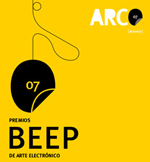
Call for submissions
ARCO/BEEP NEW MEDIA ART AWARDS :: 2nd edition :: Conceded by BEEP, in collaboration with ARCO
Worth 8.000 euros and 6.000 euros.
The goal of these awards is to advance the production and exhibition of New Media Art, and art linked to new technologies. Its purpose is to promote new high-tech art, and to foster communication between the manufacturers / creators of this new technology and those who create art. A natural collaboration, which will benefit and enrich both sides.
There are two ACQUISITION PRIZES:
1) @ARCO Prize: worth 8.000 euros. To be eligible, an artwork must be shown by a gallery at the 26th edition of ARCO, the International Contemporary Art Fair, in Madrid (15-19 February 2007), and must have a significant component involving new technology or electronic media.
2) OFF-ARCO Prize: worth 6.000 euros. Artworks presented by individual artists or collectives.
The prizes will be awarded by an international jury of prestigious specialists.
Registration form will be available from the 30th of October on the ARCO/BEEP NEW MEDIA ART Prize website http://www.arco.beep.es
Posted by luis at 09:24 AM | Comments (0)
October 20, 2006
CASAzine #4: Drawing the Line

Call for Submissions
Following the activity of the 2006 Cultural Analysis Summer Academy (CASA) international meeting in Amsterdam (June 23 – 25), the fourth CASAzine will explore the subject of art and direct action. In particular, the issue seeks to investigate the tension between hegemonic forms of knowledge concerning what constitutes art as it is embodied by the academy versus alternative forms of creative action and knowledge production. It is an enquiry into distinctions, limits and possibilities, and into the positions our actions occupy in relation to academic knowledge sets, institutions, and ultimately to other people.
"Drawing the Line" aims to examine the implications and potential of our actions. How do aesthetic concerns affect our politics and vice versa? Do actions utilizing mass media heighten awareness, or do they merely contribute additional imagery to the spectacle? More basically, to what extent is art as creative activism a productive way to work for social change? Can ‘radical aesthetics’ productively challenge distinctions drawn between art and activism in traditional academic knowledge systems?
"Drawing the Line" applies to our negotiation with institutionalization. What happens to creative forms of direct action when they are defined as art by public bodies or art markets? How can creative practices push agendas for political change in relation to, or even within, those contexts? How can we take critical action that is aware of its own position in a cultural climate of fashion, celebrity, and shopping? How do aspects of cultural life as it is currently conceived (i.e. the figure of a charismatic creator a.k.a. "the artist as genius") affect our goal for leaderless, equal, collaborative forms of art and action?
"Drawing the Line" is pertinent to how we relate to others. In all our forms of activism including research, art, and direct action, the nature of our engagement with others is crucial, be they involved, hostile, critical, or indifferent. How do our activities relate to those outside the group of people specifically engaged in this alternative practice? How do the microcosms of dissent created in our daily lives relate to wider social frameworks?
These questions are not new, but they are critical to framing the daily distinctions and decision making necessary to create awareness and change. As we move on to review, discuss, and share responses to these questions, we hope to arrive at better questions to ask, which will in turn create new answers in the struggle for social and political equity and environmental protection.
Formats:We are seeking contributions in both text and image form. Contributions may be a reflection on the subject of art and direct action as it was addressed during the meeting, or it can present an entirely perspective. Contributions may be offered by anyone, including those who have not attended CASA meetings in the past.
Guidelines:
- 500-3000 words.
- Language: English preferred; German, French, and Spanish understood.
Send
- Email is preferred: casazine2006[at]gmail.com. Please attach text in .doc or .rtf; and attach image samples in low resolution .jpg.
- Surface mail: Monika Vykoukal, Peacock visual arts, 21 Castle Street, AB11 5BQ, Aberdeen, Scotland. If you would like your materials returned, please include a stamped return envelope.
Deadline: 1 February 2007
We, Milena Placentile and Monika Vykoukal, the editors of this year's zine, met at CASA Meeting 2006. We live in Canada and Scotland respectively, and we are both curators of contemporary art.
The Cultural Analysis Summer Academy (CASA) came into existence in 2003 as an international forum that seeks to discuss the shifting functions of academia and the scholar in a globalized society. CASA offers a platform for people to combine efforts and information with a view towards social transformation.
To date, CASA has organized three meetings to provide a platform for these discussions. For more information about CASA 2004 "Acting and Spectating", CASA 2005 "Borders, Markets, Movements", and CASA 2006 "Constructing Social Change: Art, Direct Action, Knowledge, Utopia, and Desires."
Posted by jo at 04:45 PM | Comments (0)
Global Conflict: Palestine
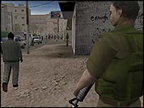
Middle-East Conflict Informs Game
"Global Conflict: Palestine gives the option of three perspectives. A game based in the midst of the conflict in the Palestinian territories is set to be the latest release in the trend of politically-conscious gaming. Global Conflict: Palestine centres on the activities of a young journalist. The player must navigate between different Palestinian and Israeli sources to get to the truth of a story. "You can take a pro-Palestinian angle, a balanced angle, or a pro-Israeli angle," said Simon Egenfeldt-Nielsen, of Serious Games Interactive. Mr Egenfeldt-Nielsen told the BBC's Culture Shock programme: "The game is much more about the personal experience; the emotional experience."
The player walks around a city resembling Jerusalem and its surrounding areas talking to people. As the conflict intensifies, however, the situation becomes increasingly complex and exposes some of the reasons for the ongoing violence ... Different perspectives: Global Conflict: Palestine, which is released early next year, follows music channel MTV's internet-based Darfur Is Dying, which went online earlier this year and had 700,000 players in its first month. Later, tens of thousands of players sent e-mail messages to politicians to urge action over Darfur." From Middle-East Conflict Informs Game, BBC News.
Posted by jo at 04:27 PM | Comments (0)
Fleshing Out
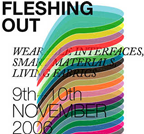
Seminar and Workshop
V2_, Institute for the Unstable Media, Rotterdam, and Amsterdam-based Virtueel Platform, the expertise centre for E-Culture, are organising a two-day event on the theme of close-to-the-skin technology.
Recent developments in science, including DNA and stem cell research, tissue culturing, smart materials and wearable technology, have a growing impact on how we perceive materials and clothing in design practice. In laboratories across the globe researchers at the boundaries of materials research, electronics, chemistry, and biotechnology are laying the foundations of future applications. The key characteristics of the materials and clothing developed in these labs are their ability to adapt (such as fabrics that adapt their density according to the surrounding temperature), the seamless integration of technology (for example, woven-in solar panels) and the self-organising nature of the design process (such as skin that grows in the form of a leather jacket, independent of any living being).
It is up to the designers, artists, and developers to determine how this ‘adaptivity’, seamless integration and self-organisation will take place. Designers and artists play an essential role in the way these technologies are formed and the way they are used in society at large. More is at stake here than merely the design of the products.It is also vital to stop and think about the impact that the introduction of these kinds of technologies may have on society.
Fleshing Out aims to create a breeding ground for Dutch initiatives in the field of new technologies, in the arts, materials and clothing design practice. It also examines the social impact of this scientific innovation on our daily lives, by testing out various scenarios in conjunction with their users.
Featuring: Kristina Andersen (Media Design, Piet Zwart Institute, Rotterdam and Steim, Amsterdam) / Joanna Berzowska (Design and Computation Arts , Concordia University, Montreal) / Ger Brinks (Textile Materials, Saxion Hogescholen, Enschede) / Anne Galloway (Sociology & Anthropology, Carleton University Ottawa) / Janine Huizinga (Waag Society, Amsterdam) / Tobie Kerridge (Royal College of Art, London) / Suzanne Lee (Central Saint Martins College of Art & Design, London) / Michiel Scheffer (Fashion and Materials Design, Saxion Hogescholen, Enschede) / Thecla Schiphorst (Interactive Arts, Simon Fraser University, Vancouver) / Sabine Seymour (University of Art and Industrial Design in Linz, Austria) / Ionat Zurr (SymbioticA: the art and science collaborative research laboratory, School of Anatomy and Human Biology, University of Western Australia).
FLESHING OUT: Seminar :: Thursday 9th November 10 am - 6 pm, at V2_ in Rotterdam: This seminar brings together leading and critical initiatives in the field of wearable technology and smart materials and presents them to a wide audience of artists, designers, scientists and students from a variety of disciplines. The seminar is part of V2_’s Test_Lab events series. Admission seminar: 40 Euro (students: 20 Euro)
FLESHING OUT: Scenario Workshops: The workshop provides a more intimate setting for a selected group of speakers from the seminar and several invited Dutch experts. They come together in this workshop to analyse best practices in the interdisciplinary field of wearable technology, come up with scenarios, and research the possibilities of setting up new innovative projects in the Netherlands.
The workshop wil be held on Friday 10th of November at the Zwijger in Amsterdam. The Fleshing Out workshop is by invitation only. However there are some open seats available. Admission scenario workshops: 75 Euro (students: 35 Euro).
You can register via our online registration form.
Posted by jo at 04:10 PM | Comments (0)
Alive and clicking
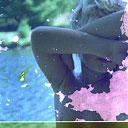
"Your Gallery: A Unique Reader-Curated Exhibition"
Alive and clicking :: Last month we asked you to choose 10 artists from the web for a unique reader-curated exhibition. As it opens, Jonathan Jones introduces the finalists :: Slideshow: Preview the exhibition.
"Heath Bunting, the first internet artist, showed me his piece A Visitors Guide to London at an underground arts event in the early 1990s. By clicking on a dustbin or a bit of waste ground, you could take a magical mystery tour of the metropolis. It was primitive, innocent, and infused with a radical optimism. Bunting was one of a generation of young activist-artists for whom the digital revolution was a superhighway to world anarchy.
They are still at it, only now it's the commercial structure of the internet they are trying to subvert - one project recently commissioned by the new media art site rhizome.com is called Google Will Eat Itself; the creators propose to buy bits of Google until they own the entire business. Such artists now seem a bit old-fashioned. The internet is no longer a utopian possibility but an ever-mutating reality; the hacker has been replaced by conventional artists who simply want to show their work online. And the man who has been first to tap into this desire and produce the art equivalent of YouTube is Charles Saatchi, whose reputation as a businessman and collector could scarcely be more different from Heath Bunting's lo-fi activism." From Alive and Clicking by Jonathan Jones, The Guardian, October 19, 2006.
Posted by jo at 03:49 PM | Comments (0)
Confronting the Challenges of Participatory Culture:
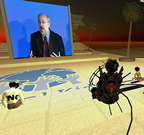
Media Education for the 21st Century
[Image left: Henry Jenkins in Second Life] "According to a recent study from the Pew Internet & American Life project (Lenhardt & Madden, 2005), more than one-half of all teens have created media content, and roughly onethird of teens who use the Internet have shared content they produced. In many cases, these teens are actively involved in what we are calling participatory cultures.A participatory culture is a culture with relatively low barriers to artistic expression and civic engagement, strong support for creating and sharing one’s creations, and some type of informal mentorship whereby what is known by the most experienced is passed along to novices.A participatory culture is also one in which members believe their contributions matter, and feel some degree of social connection with one another (at the least they care what other people think about what they have created). Forms of participatory culture include:
Affiliations — memberships, formal and informal, in online communities centered around various forms of media, such as Friendster, Facebook, message boards, metagaming, game clans, or MySpace).
Expressions — producing new creative forms, such as digital sampling, skinning and modding, fan videomaking, fan fiction writing, zines, mash-ups).
Collaborative Problem-solving — working together in teams, formal and informal, to complete tasks and develop new knowledge (such as through Wikipedia, alternative reality gaming, spoiling).
Circulations — Shaping the flow of media (such as podcasting, blogging).
A growing body of scholarship suggests potential benefits of these forms of participatory culture, including opportunities for peer-to-peer learning, a changed attitude toward intellectual property, the diversification of cultural expression, the development of skills valued in the modern workplace, and a more empowered conception of citizenship. Access to this participatory culture functions as a new form of the hidden curriculum, shaping which youth will succeed and which will be left behind as they enter school and the workplace. Some have argued that children and youth acquire these key skills and competencies on their own by interacting with popular culture.Three concerns, however, suggest the need for policy and pedagogical interventions:
The Participation Gap — the unequal access to the opportunities, experiences, skills, and knowledge that will prepare youth for full participation in the world of tomorrow.
The Transparency Problem — The challenges young people face in learning to see clearly the ways that media shape perceptions of the world.
The Ethics Challenge — The breakdown of traditional forms of professional training and socialization that might prepare young people for their increasingly public roles as media makers and community participants.
Educators must work together to ensure that every American young person has access to the skills and experiences needed to become a full participant, can articulate their understanding of how media shapes perceptions, and has been socialized into the emerging ethical standards that should shape their practices as media makers and participants in online communities. A central goal of this report is to shift the focus of the conversation about the digital divide from questions of technological access to those of opportunities to participate and to develop the cultural competencies and social skills needed for full involvement. Schools as institutions have been slow to react to the emergence of this new participatory culture; the greatest opportunity for change is currently found in afterschool programs and informal learning communities.
Schools and afterschool programs must devote more attention to fostering what we call the new media literacies: a set of cultural competencies and social skills that young people need in the new media landscape. Participatory culture shifts the focus of literacy from one of individual expression to community involvement. The new literacies almost all involve social skills developed through collaboration and networking. These skills build on the foundation of traditional literacy, research skills, technical skills, and critical analysis skills taught in the classroom.
The new skills include:
Play — the capacity to experiment with one’s surroundings as a form of problem-solving
Performance — the ability to adopt alternative identities for the purpose of improvisation and discovery
Simulation — the ability to interpret and construct dynamic models of real-world processes
Appropriation — the ability to meaningfully sample and remix media content
Multitasking — the ability to scan one’s environment and shift focus as needed to salient details.
Distributed Cognition — the ability to interact meaningfully with tools that expand mental capacities
Collective Intelligence — the ability to pool knowledge and compare notes with others toward a common goal
Judgment — the ability to evaluate the reliability and credibility of different information sources
Transmedia Navigation — the ability to follow the flow of stories and information across multiple modalities
Networking — the ability to search for, synthesize, and disseminate information
Negotiation — the ability to travel across diverse communities, discerning and respecting multiple perspectives, and grasping and following alternative norms.
Fostering such social skills and cultural competencies requires a more systemic approach to media education in the United States. Everyone involved in preparing young people to go out into the world has contributions to make in helping students acquire the skills they need to become full participants in our society. Schools, afterschool programs, and parents have distinctive roles to play as they do what they can in their own spaces to encourage and nurture these skills."
From Confronting the Challenges of Participatory Culture: Media Education for the 21st Century by Henry Jenkins, Director of the Comparative Media Studies Program at the Massachusetts Institute of Technology; with Katie Clinton, Ravi Purushotma, Alice J. Robinson and Margaret Weigel.
Posted by jo at 03:12 PM | Comments (0)
Ah-ha: Narrative Structures in Reactive and Interactive Video Art

Connecting the Physical and the Digital
[Image left: "Guillotine" by Steve Shoffner) "Performance is so many things: the synchronized sounds of a symphony; actions with words in a play; steps and turns in a dance; words from a pulpit. Performance art, too, is variable, perhaps too multifarious to define, even with semicolons. At traditional performances with traditional support materials, from symphonies with program notes to theatre productions with playbills, performance acts as replay, a repeat of an event, a memorization of a string of notes or a set of lines, a reformulation of a tested formula. Then there are those performances that vary, that respond to the moment, that unfold through the implementation of chance or improvisation or, more and more, digitization. With the insertion of new technologies into performance, the question arises – do actions result from numbers? What indeed is the connection between the physical and the digital? Does the digital component determine the performance, or do actions generate a numeric pattern, which then underlies the piece's structure?
The aesthetic and conceptual import of digital performance pieces is linked to the ordering of a piece's technological components. Random sequencing is one form of structuring immersive environments or data-triggered scenes. Fixed sequencing of scenes, with a predetermined index of performed actions and triggered events, follows a preset score. Alternately, sensory responsive improvisation is flexible and often produces variations in structure. In each case, the piece's content is the result of a digital system: programming or computer responses to external stimuli determine how the performance plays out. Even interactive improvisation, in which a human action triggers a computerized event, is a digital system, albeit one that emphasizes the human element, or input, in that system. The content of an interactive piece is closely related to its structure – the interaction between trigger, whether generated by the viewer or performer, and event. Interesting variations in content emerge when the structure becomes the art.
Below, by electronic interview, four new media artists describe their modes of working with interactive technologies and probe the relationship between order and content in their work. Johannes Birringer makes telematic connections in performance, installation, and video. Mark Coniglio co-directs the interactive dance company, Troika Ranch, with Dawn Stoppiello; he both designed and implements the interactive software, Isadora. Cat Jones' alternate persona catgURL interacts with viewers while performing live on and off the screen. Steve Shoffner instigates interactions with viewers while performing simultaneously on video and within his installations." From Ah-ha: Narrative Structures in Reactive and Interactive Video Art by L. Hermes Griesbach, VJ Theory: ART, 12/10/06.
Posted by jo at 02:29 PM | Comments (0)
Liminalities: A Journal of Performance Studies: Issue 3.3: Special issue on Sound
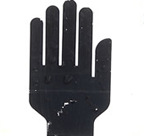
Call For Papers
Liminalities: A Journal of Performance Studies: Issue 3.3: Special issue on Sound :: Call For Papers
The aim of this issue of Liminalities is to visit new areas of research in sound culture and oral traditions; new media potentials for using audio in and as performance; and to revisit classical performance topics like elocution, oral interpretation, and voice. This special issue responds to the increased interest in sound and music in cultural studies and performance studies, the increasing availability of sound-editing and music-production software, and the rise in cultural relevance of podcasting and other methods of distributing audio-centered theoretical, ethnographic, documentary, and aesthetic content. We are looking for both audio projects and projects about sound. Contributors may address some of these themes as they relate to performance:
Aural environments :: Oral interpretation :: Digital storytelling :: Spoken word performance :: Sound environments :: Auditory culture :: Oral histories :: The "return" of orality :: Digital technology :: Multimedia performance :: Noise Sound art :: Music :: Propaganda :: Radio :: Soundscapes :: Podcasting :: Voice :: Aural memory :: Listening :: Documenting performance :: Documentary as performance :: Recording.
The editors anticipate the issue may contain (at least) three sections:
. Audio performances
. Audio essays/projects addressing the special issue theme
. Textual essays exploring theoretical and practical issues of sound in/ and/ as performance.
Submission Procedures:
Step One: Proposals (Deadline: February 15th, 2007)
For essays: In approximately three to seven pages, plus works cited, please identify the primary argument you plan to make in your essay, providing some sense of the context for that argument's relevance in terms of disciplinary conversations and praxis. Additionally, please identify any nontraditional / mediated sources / texts / strategies (e.g., video, audio, flash, etc.) you intend to use in your final piece. Please use MLA format where appropriate and submit three hard copies of the proposal to the address below.
For performances: Please describe your performance, contextualizing the work's relevance in terms of disciplinary history, conversations, and praxis. In addition, please identify and discuss (where necessary) any presentational strategies you have beyond mp3 audio files.
The editors will notify authors about the status of their proposals by March 15th.
Step Two: Final Materials (Deadline: July 15th, 2007)
Authors with accepted proposals should plan to submit final versions of their essays/works in appropriate formats: (a) audio and other media projects should be burned onto a CD or DVD and mailed to the address below; (b) for essays, please send three hard copies to the address below and email one copy, in MS-Word, to the email address below.
Step Three: Peer review and editorial changes will take place over the summer, with publication of this issue scheduled for November 1st, 2007.
Please send all proposals and submissions for this special issue to: Marcyrose Chvasta (mchvasta[at]cas.usf.edu ) or Michael LeVan (mlevan[at]tampabay.rr.com )
Or by mail to:
Marcyrose Chvasta
Editor, Liminalities
Department of Communication CIS1040
University of South Florida
4202 East Fowler Ave
Tampa, FL 33620-7800
Liminalities: A Journal of Performance Studies is a peer-reviewed online journal for performance studies scholarship, criticism, praxis, and pedagogy. We welcome the submission of essays, interviews, reviews, performance scripts, poetry, and multimedia projects. We support a wide range of performance perspectives, practices, methodologies, media, contexts, styles, and sites. All submissions should be in cross-platform formats. For information or inquiries, contact Marcyrose Chvasta or Michael LeVan at editor[at]liminalities.net .
Posted by jo at 12:14 PM | Comments (0)
Two Thousand + SEVEN: International Symposium on Virtual Performance Environments

Call for Presentations / Papers
Two Thousand + SEVEN: 2nd international symposium focusing on networked performance environments :: The upcoming edition of Two Thousand + SEVEN will once again run in parallel to the Sonorities Festival of Contemporary Music, hosted by the Sonic Arts Research Center, Queen's University Belfast. The festival is the longest-running new music festival in Ireland that presents cutting-edge new music and features some of the most thought-provoking and controversial musicians.
Call for papers/presentations: The call for papers is now open. Please go to: www.sonorities.org.uk/symposium for details. The focus will be on cultural and practical issues that arise in virtual performance environments.
Keynote Speakers: George Lewis (Columbia University) and Steven Connor (Birkbeck College, London).
George Lewis previously taught at UC San Diego,Mills College, the School of the Art Institute of Chicago, and Simon Fraser University's Contemporary Arts Summer Institute. He has served as music curator for the Kitchen in New York, and has collaborated in the "Interarts Inquiry" and "Integrative Studies Roundtable" at the Center for Black Music Research (Chicago). A member of the Association for the Advancement of Creative Musicians (AACM) since 1971, Lewis studied composition with Muhal Richard Abrams at the AACM School of Music, and trombone with Dean Hey. An active composer, improvisor, performer and computer/installation artist, Lewis has explored electronic and computer music, computer-based multimedia installations, text-sound works, and notated forms. His artistic work is documented in over 120 recordings and has been awarded by a 2002 MacArthur Fellowship, 1999 Cal Arts/Alpert Award in the Arts, and numerous fellowships from the National Endowment for the Arts. His oral history is archived in Yale University's collection of "Major Figures in American Music," and his published articles on music, experimental video, visual art, and cultural studies have appeared in numerous scholarly journals and edited volumes.
Steven Connor has taught since 1979 at Birkbeck College, where he is now Professor of Modern Literature and Theory. He is currently Academic Director of the London Consortium Masters and Doctoral Programme in Humanities and Cultural Studies. He is also the College Orator. For publications see: www.bbk.ac.uk/english/skc.
Further Details:
Paper sessions will take place in the morning and the afternoon bridged by a lunchtime performance and finished off with two evening concerts.
Date: Saturday, 21st of April 2007
Location: Sonic Arts Research Center/Belfast.
Deadlines:
A maximum of 8 papers of 20 minutes duration (plus question time) will be accepted. Abstracts (max. 350 words) are due in electronic format by the 15th of December 2006. Presenters of accepted papers/presentations will be informed by the 15th of January 2007. All accepted papers will be published on the SARC site.
Registration: This includes free access to all Sonorities Festival events on the day of the symposium.
Submissions and all queries should be directed to:
f r a n z i s k a s c h r o e d e r: franzisk[at]lautnet[dot]net
Posted by jo at 12:02 PM | Comments (0)
Andy Deck
Archived Performance at VisitorsStudio

Every now and then somemof the Furtherfield crew review some of the
archived content on the VisitorsStudio. Some times by projecting it up
on as wall whilst consuming coffee or alcohol in the studio at Furtherfield.
Earlier today we came across an archived performance by Andy Deck in the
VisitorsStudio - and thought, this is pretty decent work.
- Turn the volume up and give it a few seconds to load, and then just
sit back and enjoy... [Marc Garrett]
Posted by jo at 08:50 AM | Comments (0)
October 19, 2006
A Journal of Interactive Media

Games and Culture
Games and Culture: A Journal of Interactive Media is a new, quarterly international journal that publishes innovative theoretical and empirical research about games and culture within interactive media. The journal serves as a premiere outlet for ground-breaking work in the field of game studies.
Games and Culture's scope includes the socio-cultural, political, and economic dimensions of gaming from a wide variety of perspectives, including textual analysis, political economy, cultural studies, ethnography, critical race studies, gender studies, media studies, public policy, international relations, and communication studies. Other arenas include the following:
• Issues of gaming culture related to race, class, gender, and sexuality
• Issues of game development
• Textual and cultural analysis of games as artifacts
• Issues of political economy and public policy in both US and international arenas
Posted by michelle at 03:14 PM | Comments (0)
workshop by JULIAN OLIVER

Art + Game
Art + Game: 3D GAME for ART :: iMAL , Brussels, 27/11 - 1/12/2006.
A workshop about artistic usage of 3d game engines directed by Julian Oliver The workshop will explore artistic usages of 3d game engines, with a particular emphasis on using open source tools. The workshop will be directed by Julian Oliver, an artist internationaly known in the field.
Using Blender as a core development context, Julian will cover rapid protoyping, 3D modeling, event frameworks, game scripting (using Python) and the basics of networking your interactive project with PureData or MaxMSP. In the last day, Julian will introduce how engines such as Soya3D, Ogre3D and QuakeIII can be used for more ambitious projects, using techniques and strategies learned in the first phase of the intensive.
About Julian Oliver: Julian Oliver is a New Zealand born artist, free-software developer, educator and media-theorist. He has presented papers and artworks at many international electronic-art events and conferences. Under the moniker 'delire' he has performed his game-based music software at venues throughout North America, the EU, Japan and the South Pacific. More on selectparks.net/~julian/index.php
Julian has given numerous workshops and master classes in game-design, artistic game-development, virtual architecture, interface design, augmented reality and open source development practices worldwide. In 1998 he established the artistic game-development collective www.selectparks.net.
When ?
Workshop dates are : from Monday 27 NOV to Friday 1 DEC in Brussels. From 10am to 18pm with lunch break.
Where ?
at iMAL office, Centre Dansaert, 7 rue d'Alost, 1000 Brussels.
Registration > registration form
Only through the registration form. The workshop will accept a maximum of 12 participants. The participation fee is 80 EUROS.
Posted by jo at 12:15 PM | Comments (0)
RISD Digital+Media Lecture Series
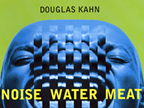
Douglas Kahn + David Rokeby
Douglas Kahn :: 11.07.06 - Tuesday, 7:00 PM :: RISD Auditorium (North Main St.).
Douglas Kahn, Professor of Technocultural Studies at University of California at Davis, is author of Noise, Water, Meat: A History of Sound in the Arts (MIT Press) and, under a 2006 Guggenheim Fellowship, is completing the book Sound No Sound, on the artistic trade between acoustics and electromagnetism. He will be a keynote speaker at Sonic Focus at Brown University, November 3-4.
Media Ventriloquy: Election Night Coverage: News editing is a crude form of ventriloquism. Throughout the 20th Century artists, musicians and media activists have taken editing news events and personalities into an art form. Present day media ventriloquists have grown increasingly sophisticated in how speak through representations of people who are still, ostensibly, alive through performed recordings and electoral performance, as crafted revenge for the way these selfsame people speak for others. This evening’s talk surveys the history before focusing on Bryan Boyce, Pauline Pantsdown and the speaker's own one-hit wonder.
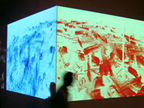
David Rokeby :: 11.28.06 - Tuesday, 7:00 PM :: RISD Auditorium (North Main St.).
David Rokeby is a sound and video installation artist based in Toronto, Canada. He has been creating interactive installations since 1982. He has focussed on interactive pieces that directly engage the human body, or that involve artificial perception systems. His work has been performed / exhibited in shows across Canada, the United States, Europe and Asia, including:
the Venice Biennale in 1986
Ars Electronica (Linz Austria) in 1991
the Mediale (Hamburg Germany) in 1993
the Kwangju Biennale (Korea) in 1995
the Biennale di Firenze (Florence, Italy) in 1996
Alien Intelligence (Kiasma, Helsinki) in 2000
The National Gallery of Canada in 2002
The Venice Architecture Biennale in 2002
Ars Electronica in 2002
Recent Awards include the first BAFTA (British Academy of Film and Television Arts) award for Interactive Art in 2000, a 2002 Governor General's award in Visual and Media Arts and the Prix Ars Electronica Golden Nica for Interactive Art 2002. He was awarded the first Petro-Canada Award for Media Arts in 1988, the Prix Ars Electronica Award of Distinction for Interactive Art (Austria) in 1991 and 1997.
Posted by jo at 12:06 PM | Comments (0)
sonic.focus

Symposium / Performances / Screenings
sonic.focus: theory and practice between sound and image :: Symposium / Performances :: Modern Culture and Media, Brown University :: 11.03-11.04.06, Friday and Saturday
sonic.focus is a project that examines complementarities and antagonisms between sound and image in contemporary culture. Starting with film & video screenings on October 20th and 27th, the events will culminate in a conference and performance series to be held at Brown University on November 3 and 4, 2006.
This program is prompted by the emergence over the past decade of an auditory culture that parallels the dominant visual culture. Among the phenomena that signal this emergence are: the increasing presence of sound in visual arts exhibitions and venues; the proliferation of visual and media practices in which sound is central to meaning; and the development of a body of theory that examines the nature, history, and circulation of sound as a useful social or conceptual model.
The aim of the conference is to foster a fruitful dialogue among theorists and practitioners working at the intersection of the visual and the sonic arts. Keynote speakers will include David Toop, Diedrich Diederichsen, and Douglas Kahn. Panels will include presentations by Christian Marclay, Renee Green, Stephen Vitiello, Steve Roden, and others. Finally, two nights of performances will include appearances by artists such as Tony Conrad, Robert Lippok, AGF & Sue C. and David Shea. All talks and panels will take place at the Joukowsky Forum, 111 Thayer Street in Providence.
The program opens with two nights of screenings exploring classic and contemporary films and videos by Oskar Fischinger, Hans Richter, Kenneth Anger, Brian Eno, Phill Niblock, Carsten Nicolai, Billy Roisz, Leslie Thornton, and others. The screenings will take place from 6-9pm on October 20th and 27th in the Modern Culture and Media Cinematheque, 135 Thayer Street in Providence.
sonic.focus is organized by Tony Cokes, Christoph Cox, and Roger Mayer, and sponsored by the Department of Modern Culture and Media, Brown University. Additional support for sonic.focus has been provided by the Malcolm S. Forbes Center for Research in Culture and Media Studies; the Creative Arts Council (Fitt Artists-in-Residence); The C.V. Starr Foundation Lectureships Fund; Global Security Program of the Watson Institute for International Studies; German Studies Department; and the Goethe-Institut (Boston).
sonic.focus: Screenings :: Modern Culture and Media Cinematheque, 135 Thayer Street, Brown University :: 10.20 & 10.27.06 - Fridays, 6:00 PM.
The program opens with two nights of screenings exploring classic and contemporary films and videos by Oskar Fischinger, Hans Richter, Kenneth Anger, Brian Eno, Phill Niblock, Carsten Nicolai, Billy Roisz, Leslie Thornton, and others. The screenings will take place from 6-9pm on October 20th and 27th in the Modern Culture and Media Cinematheque, 135 Thayer Street in Providence.
Posted by jo at 11:55 AM | Comments (0)
Halsey Burgund
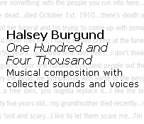
Performance of One Hundred and Four Thousand
The Forest Hills Educational Trust will be hosting a performance of Halsey Burgund’s One Hundred and Four Thousand :: WHEN: Friday, October 27th at 8PM :: WHERE: Forsyth Chapel at Forest Hills Cemetery, Jamaica Plain, MA :: $8 :: Tickets purchased at the door. More information and directions to Forest Hills.
Burgund wrote One Hundred and Four Thousand for the current art exhibit at the cemetery and this event will be the premiere performance of the piece. You can hear the studio recorded version here. The piece was created by stitching together fragments of interviews of cemetery visitors and employees - conducted on the cemetery grounds in the Spring of this year – with traditional instrumentation to yield an original piece of music intended to be heard while at the cemetery.
For the live performance, Burgund will be playing marimba and piano as well as using sampling technologies to trigger the voices. He will be joined by Peter Bailey on guitar and MIDI guitar, Javier Caballero on cello, Bennett Miller on upright and electric bass, Michael O’Connor on sax, flute and clarinet and Bekka Schellenberg on violin. They will also be using live electronic manipulations to recreate some of the desired effects as well as take it one step further by using surround sound to put the audience right in the middle of the piece. There will be a Q&A session for those interested in learning more about the piece and Halsey’s composition techniques as well as the performance of several other shorter pieces to round out the evening. [Related]
Posted by jo at 10:18 AM | Comments (0)
Ethan Zuckerman
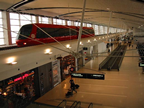
Tracking Hasan Elahi
Hasan Elahi is a conceptual artist whose life is an ongoing work about surveillance. He starts by telling us a chilling story - his detention by the INS at Detroit Airport after returning from a trip from overseas. An immigration officer scanned his passport and blanched, then led Alahi through a maze under the airport to an INS detention facility. As a US citizen, this was pretty odd - he tried to talk with the guards to figure out what was going on. But it all became clearer when the man from the FBI in the dark suit came to talk with him.
The FBI asked him about his whereabouts on September 12, 2001 - he was able to answer the questions by taking out his Blackberry and showing off his meetings. Over the course of questioning, it became clear that the reason he was being questioned was that he had a storage locker in Tampa, where he’d been teaching. Scared by 9/11, the owners of the storage area reported that “an Arab man had fled on 9/12, leaving explosives in his locker.” There were, of course, no explosives, and he hadn’t fled - just the detritus of ordinary life.
Elahi’s life for the next few months involved dozens of interviews with the FBI, finally culminating in nine back to back polygraphs, which finally “cleared” him. He explains that the power dynamic of an FBI interview leads to a very human response - the desire for survival. Elahi says that he could have questioned the legality of the experience, hiring a lawyer… but he realized that there was the possibility that any act of resistance could have gotten him sent to Guantanamo.
For the next few months, every trip Elahi took, he’d call his FBI agent and give the routing, so he didn’t get detained along the way. He realized, after a point - why just tell the FBI - why not tell everyone?
So he hacked his cellphone into a tracking bracelet which he wears on his ankle, reporting his movements on a map - log onto his site and you can see that he’s in Camden. But he’s gone further, trying to document his life in a series of photos: the airports he passes through, the meals he eats, the bathrooms he uses. The result is a photographic record of his daily life which would be very hard to falsify. We all know photos can be digitally altered… but altering as many photos as Elahi puts online would require a whole team trying to build this alternative path through the world.
Elahi also puts other apsects of his life online, including his banking records. This gives a record of his purchases, which complements the photographs. He doesn’t put the phone records online, because it would compromise the privacy of the people he talks with, and some friends have asked him to stop visiting, but he views the self-surveillance both as an art form and as his perpetual alibi for the next time the FBI questions him.
At the same time, he’s stretching the limits of surveillance systems, taking advantage of non-places. He flew to Singapore for four days and never left the airport, never clearing customs. For four days, he was noplace - he’d fallen off the map, which is precisely what the FBI and others worry about. But he documented every noodle and every toilet along the way.
One of the audience questions asks whether the FBI actually threatened Elahi with Guantanamo, or whether his “artistic temperment” might have exaggerated the seriousness of the situation. Elahi explains that it was never made concrete, but that he certainly felt the threat of indefinite detention, and that he believes the only thing that saved him was a common culture - the ability to quote the lyrics of country songs, or talk about college football, the sort of things a terrorist would find very hard to fake.
Another questioner wonders if Marianne Weems will make a show about Elahi - she mentions that an earlier piece, “Jet Lag”, tells the true story of a woman who flies from Amsterdam to NYC 167 times, again and again, until she dies of jetlag. (Still trying to find a reference to this story…) Given that Elahi’s life involves all the issues Weems is most interested in, she admits that a piece based on his experiences would be irresistable. [posted by Ethan Zuckerman on World Changing]
Posted by jo at 09:51 AM | Comments (0)
Net_Dérive
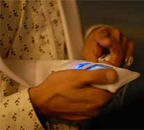
The City as Instrument
Net_Dérive, by Atau Tanaka and Petra Gemeinboeck with the collaboration of Ali Momeni, is a location sensitive mobile media art piece that calls for an exchange between participants in the gallery and participants in the streets. Deployed on advanced mobile phones, the work seeks to create a kind of musical instrument, thinking of the city-as-instrument.
Participants are given a kind of scarf with a mobile phone in each end and off they go to explore the neighborhood. One of the phones takes pictures every 20 secs and collects sounds, the other talks to the GPS (also in the scarf) and to the server inside the gallery space. On a radar they can see themselves pictured as dots but also the images they're taking. The sounds and pictures collected in the streets are sampled and mapped to a 3D city map in the gallery. As users are walking they can hear some voice instructions through a pair of headphones. Those comments suggest paths to follow or turns to make, they are generated and heard in a musical fashion. The voice instructions are inspired by the old Situationist games and theory of the Dérive - now brought into the digital and mobile spheres. As the user chooses to heed or ignore these instructions, a trace of his/her path is carved out in the city.
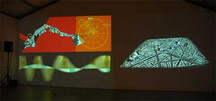
The engine then generates an audiovisual amalgam based on this information, and feeds it back as a live stream to each mobile client. The simultaneity, history, and memory of the various users’ paths and images become an abstract narrative that is summed together and projected in the gallery space. A feedback mechanism is created as users’ actions generate the collective narrative that in turn directs them.
Presented in Paris during the IntensiveScience exhibition of Sony CSL Paris, 6, 7-october 2006
Photos by Walter Kim. Images and information courtesy of Atau Tanaka.
Related: Sonic City, a wearable piece that enables people to compose music in real time by walking through the city; headphones that turn urban noise into music. Atau Tanaka's talk at Futuresonic; Pixel bondage on rice paper. [blogged by Regine on we-make-money-not-art]
Posted by jo at 08:38 AM | Comments (0)
Culture Catcher
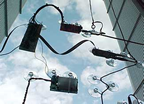
Lost in Translation
While driving through Africa, Michael Sheridan and his film crew met two men crouching in the sand and listening to handheld shortwave radios. The sounds from their radios reconnected the artist with the world after days of isolation and disorientation.
This experience inspired the sound installation Culture Catcher. Shortwave radios, digital recorders and players, motion detectors, micro computers, antennae... all the equipment required to search for and broadcast multiple shortwave radio signals is hung by suction-cups on a giant transparent wall.
The movement of visitors in the gallery triggers sounds from around the world which fill the environment. Simultaneously one might hear, for example, Persian music, Christian proselytizing and news reports in Korean, all affected by the interferences in the atmosphere. Via neural. [blogged by Regine on we-make-money-not-art]
Posted by jo at 08:28 AM | Comments (0)
From The Great Beyond
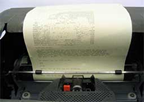
Talking with the Internet
Is the Internet becoming an entity? If the answer is positive, what are the characteristics of this being?, wonders Fang-Yu Lin. Inspired by the Turing Test, he designed From The Great Beyond, a typerwriter that has (seemingly) a life of its own.
By typing on the keyboard of the custom robotic typewriter, you are able to "chat" with the Internet while the background application searches online resources for response. There's not screen, the typewriter automatically prints out the resulting text or ASCII art on a paper roll for you to view or keep. Be it whimsical, intelligent or simply irrelevant, the typed words of the Internet reveal a fragment of truth regarding itself.
The existence of an invisible entity is suggested by the noise of the typing and flowing responses spit out from the typewriter. Video. Via exibart.
More typewriter: TTSM (Typewriter Tracklog Sewing Machine), by Alejandro Duque, uses a GPS device to track and save the data of a journey without destination; 22POP is a typewriter that sends typed letters as emails to your destinary; Life Writer turns the letters typed into artificial life creatures that appear to float on the paper of the machine. Also: The Universal Digest Machine features a web spider that crawls the net, digesting web pages, outputting a brief analysis of their contents and printing it on a receipt. [blogged by Regine on we-make-money-not-art]
Posted by jo at 08:25 AM | Comments (0)
October 18, 2006
eyeSpace
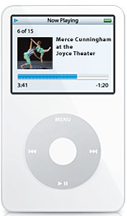
Merce + Rouse + iPod + Joyce
Last week, audience members enjoyed a unique experience in maverick choreographer Merce Cunningham’s newest piece, eyeSpace. Using iPod Shuffles, each member of the audience heard different pieces of composer Mikel Rouse’s score, International Cloud Atlas. The audience was provided with iPod shuffles, set to play the score’s tracks in a random order, giving each viewer a distinct viewing experience.
Audience members were requested to bring their own iPods, loaded with the score they downloaded from this page, to play during the performance of eyeSpace. For those who didn't have their own iPods, iPod Shuffles were available for use on loan (at no cost) at The Joyce Theater.
With your ticket purchase, audience members were also entitled to receive a free download of select tracks from Mikel Rouse’s score. [via Great Dance]
Posted by jo at 06:56 PM | Comments (0)
Coke Is It
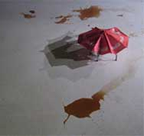
Suicidal Robot
Coke Is It, by SWAMP, is a robotic performance, a comment on the marketing strategies deployed by companies such as Coca Cola. They infuse our culture with a sense of well being and elevated self worth that contradicts the actual benefits of the consumable product.
C3 is a hex-crawler robot, outfitted with a CMUcam and sensors, enabling it with the ability to search and find puddles of Coca Cola placed on the gallery floor. When C3 finds a puddle of coke, it sucks the beverage up through an electrical pump, and then sprays it across itself. After several feedings, the acidic nature of the coke eventually eats through the robots skin. Eventually this "digestive" process finds its way to the circuitry, causing it to break down.
The performance concludes when the robot is consumed to the point where it has killed itself. Video. Suicide in media art: Kurt Cobain's Suicide letter meets google adsense; Suicide Solution, a DVD documentation collected over a year of committing suicide in over 50 first and third person shooter games; and The Lovers, two networked machines, one infected with a virus, slowly infecting the other through the interface of classic romantic poetry. [blogged by Regine on we-make-money-not-art]
Posted by jo at 11:37 AM | Comments (0)
October 17, 2006
C Theory Live
![]()
Religion, Technology & Terrorism
CTheory Live symposium: Religion, Technology & Terrorism will take place at the Pacific Centre for Technology and Culture, University of Victoria on Thursday, October 19, 2006 at 2:30pm (PST). The symposium will be streamed live. View past lectures in the video archive.
The symposium will be followed by the electronic book launch of two new CTheory Book projects: LEFT BEHIND: TECHNOLOGY, RELIGION AND FLIGHT FROM THE FLESH by Stephen Pfohl, and BORN AGAIN IDEOLOGY:RELIGION, TECHNOLOGY, AND TERRORISM by Arthur Kroker.
Symposium speakers:
Andrew Wernick is a sociologist and historian of ideas as well as a cultural theorist and jazz pianist. He is the founder and director of Trent University's Institute for the Study of Popular Culture as well as the current chair of Trent's Cultural Studies Department. His interests focus on media theory and advertising, the place of religion in postmodernity, and the notion of time in contemporary culture. He is the author of _Promotional Culture: Advertising, Ideology, and Symbolic Expression_ (Sage, 1991) and co-editor of _Shadow of Spirit: Religion and Postmodernism_ (Routledge, 1992) and _Images of Ageing_ (Routledge, 1995).
Stephen Pfohl is Professor of Sociology at Boston College where he teaches courses on social theory; postmodern culture; crime, deviance and social control; images and power; and sociology and psychoanalysis. Dr. Pfohl is the author of numerous books and articles including _Death at the Parasite Cafe_, _Images of Deviance and Social Control_, _Predicting Dangerousness_, and the forthcoming volumes _Venus in Video_ and _Magic and the Machine_. A past-President of the Society for the Study of Social Problems and a founding member of Sit-Com International, a Boston-area collective of activists and artists, he is also co-editor of the 2006 book _Culture, Power, and History: Studies in Critical Sociology_.
Arthur Kroker is Canada Research Chair in Technology, Culture and Theory and Professor of Political Science at the University of Victoria, Canada. Co-editor of CTheory and Director of the Pacific Centre for Technology and Culture (www.pactac.net), he is the author of numerous books on technology and culture, including _The Possessed Individual: Technology and the French Postmodern_, _Data Trash: The Theory of the Virtual Class_ (with M. Weinstein), and _The Will to Technology and the Culture of Nihilism: Heidegger, Nietzsche and Marx_.
Posted by michelle at 10:38 PM | Comments (0)
Dan Visel
Finishing Things
Yoko Ono's Cut Piece
One of the most interesting things about the emerging online forms of discourse is how they manage to tear open all our old assumptions. Even if new media hasn't yet managed to definitively change the rules, it has put them into contention. Here's one, presented as a rhetorical question: why do we bother to finish things?
The importance of process is something that's come up again and again over the past two years at the Institute. Process, that is, rather than the finished work. Can Wikipedia ever be finished? Can a blog be finished? They could, of course, but that's not interesting: what's fascinating about a blog is its emulation of conversation, it's back-and-forth nature. Even the unit of conversation – a post on a blog, say – may never really be finished: the author can go back and change it, so that the post you viewed at six o'clock is not the post you viewed at four o'clock. This is deeply frustrating to new readers of blogs; but in time, it becomes normal.
But before talking about new media, let's look at old media. How important is finishing things historically? If we look, there's a whole tradition of things refusing to be finished. We can go back to Tristram Shandy, of course, at the very start of the English novel: while Samuel Richardson started everything off by rigorously trapping plots in fixed arcs made of letters, Laurence Sterne's novel, ostensibly the autobiography of the narrator, gets sidetracked in cock and bull stories and disasters with windows, failing to trace his life past his first year. A Sentimental Journey through France and Italy, Sterne's other major work of fiction, takes the tendency even further: the narrative has barely made it into France, to say nothing of Italy, before it collapses in the middle of a sentence at a particularly ticklish point. [continue reading at If:Book]
Posted by jo at 05:59 PM | Comments (0)
RUEDIGER JOHN
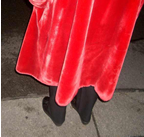
Some Remarks On Aesthetic Possibilities Of Unfinished Works of Art
/ ad utrumque paratus / Some Remarks On Aesthetic Possibilities Of Unfinished Works of Art :: RUEDIGER JOHN :: Artist Statement & Talk for NYU students and open to the public :: New York University, Languages & Literature Building, 19 University Place :: Wednesday, September, 20th 2006 - 3:30 pm.
In his statement the artist Ruediger John points out the intrinsic possibilities - or rather abilities - a work of art can have if it is still unfinished (or considered so).
"[...] Typically we rely on and value works of art that are already completed by the artist (unless there is a nice or tragic little anecdote why he or she was not able to finish it) - because we want to be sure e.g. a) it is worth the time to look at b) we can lean back to enjoy, judge and criticise c) it can be bought as it is d) and so forth. The crucial point is: We want to be secured about the character and impact of the piece of art. But what if an artist obviously does not give the audience this secured position? What if a work of art can bite you in the ass some time later - because it is developing its teeth while you already own it (as a simpler way of an interventionistic effect)? Or, more important, if a work of art uses its obviously unfinished characteristic to refer to, or rather inherit the qualities of what remains open and 'unsolved' as an additional source of 'value'?
But not to define every detail of a work can make it more dependable on influences of its surroundings (it is a problem every artwork faces - and most of all the classical form of painting does) - a contemporary artist has to incorporate this in the work during the process of creation [...]" (Ruediger John in an interview with Paul Kovac)
He also talks about what happens if he employs elements and tactics used in performance art to create installative works in an interventionistic way (e.g. outside the preoccupied perspective of audiences in gallery spaces, museums and other 'white cubes') using camouflage and irritation to guide and focus the aesthetics of an audience - to ultimately broaden its experiences (maybe).
Posted by jo at 05:45 PM | Comments (0)
IN_TENTION: Emerging Contemporary Performance Art Practices
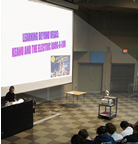
Steven Lam
IN_TENTION :: October 25-November 4, 2006 :: Tyler Gallery, Elkins Park, PA :: OPENING Thursday, October 26 2006, 7-9 pm.
This exhibition explores emerging contemporary performance art practices, and is curated by the student group Produce. The project will include work by five artists from across the country. A two-week exhibition will present ongoing performances by David Howe (GA) and Steven Lam (NY), and there will be three one-night performances by artists Quentin Davis (PA), Benjamin Kinsley (OH) and Nelson Loskamp (NY). In addition, a panel discussion will be led by philosopher, critic and artist Tom Zummer, and a workshop for students will be offered by Benjamin Kinsley from the Poke Orchestra.”
Steven Lam's project (in the Main gallery) will consist of an alternating suite of videos and a pirate radio transmission. Pulling from cybernetics/systems theory, apparatus theory, post-modern dance, and historical video art, the project is dialectical in nature; it re-uses discarded clips from an earlier library splicing them with new footage.
For the past few years, Lam has been interested in video as a medium that recodes, archives, and transmits. A new suite of videos will be introduced periodically within the duration of the exhibition. A perpetually evolving archive, the exhibition, ironic and deadpan, will be an experiment for me to toy with “distributional media.” Additionally, Lam will transmit an audio project on a local AM radio band of me reading the entirety of Friedrich Kittler’s "Gramophone, Film, Typewriter." This will be broadcasted and accessible 24 hours a day during the exhibition. The AM band will be announced shortly.
Posted by jo at 05:30 PM | Comments (0)
Gregory Green
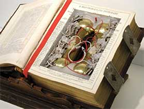
Strategies for Empowerment
Gregory Green explores the evolution of empowerment, with conceptual artworks and performances that suggest explosive devices, such as pipe bombs packed into briefcases or hollowed out books with nuclear warheads. His purpose is to stimulate creative thought about freedom and personal responsibility. Many of his artistic investigations have focused on terrorism and the possibilities for sabotage of the physical infrastructure, and the ease in which individuals, armed with readily available information, can endanger the status quo.
One work suggests how to manufacture large quantities of LSD as a form of civil disruption (an idea originally proposed by Abby Hoffman), and resulted in the 1995 brief jailing of Feigen gallery director, Lance Kinz.
Green also created guideable missiles that could be armed with conventional or nuclear devices. These pieces contain no explosives but are carefully designed to be potentially functional. Fascinatingly beautiful, the threat of these works lies in their illustration of society’s negligence in discounting the hazards presented by the outcast, the eccentric, the individual.
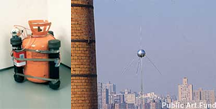
40 years to the day after the Soviet Union launched the first artificial satellite, Sputnik 1, into space, Green installed Gregnik Proto II, a prototype radio transmitter modeled after Sputnik in Brooklyn. Mounted on a rooftop, the silver orb with five antennas broadcasted unedited artist-created messages over a low frequency fm radio signal to local residents. [left: Genetron MP39 and Gregnik Proto II]
More art bombs and missiles: Criket Activated Defense System; Mel Chin's WMD Weapons of Mass Distribution; Little Japan byKazuya Kanemaru; Tom Sachs' Sony Outsider; Johann van der Schijff’s toy machines that play with the notion of military and manufacturing industry’s power; ceramic hand grenade, landmine or rocket designed as delicate presents; Postapocalyptic survival gear; Fabrice Gygi's Aesthetics of control.
And non-artistic: Titan Missile II silo. [blogged by Regine on we-make-money-not-art]
Posted by jo at 12:07 PM | Comments (0)
undersound + unspoken_series

Interactions Under the City
undersound is an interface that allows you to listen to, distribute and affect the flow of music on your mobile phone while you're travelling in the underground.
The project imagines that you will be able to add music to the system at upload points in the ticket halls, and download tracks on the platforms. Because of the architectural configuration of the stations undersound users would have to congregate at certain locations for the purpose of interacting with the system.
Each track in the system is tagged with its place of origin (the station where it was uploaded) and this information is visible as the track is being played. This may trigger musings around your personal relationship to that place.
While in the carriages of the tube, you can browse undersound music of other people in range (that idea was inspired by tunA). You can see when a track has been in the system, the number of times it has been played, the number of people who have played it, etc. You can browse through other's tracks anonymously, but if you decide to download a song from someone else an alert will be triggered on their phone letting them know that you are grabbing one of their tracks.
A project by Arianna Bassoli, Johanna Brewer and Karen Martin.
Via coin-operated.
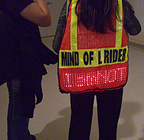
Another nice art project for the metro:
In unspoken_series, performers done a custom-made construction vest embedded with red and green LEDs to permit the display of up to 24 characters.
The artist programmes messages on the front and back of the vest, revealing facts, thoughts or ideas that the wearer would otherwise not pronounce in public. For example, the vests worn in the metro could display at once humorous and confrontational messages such as: “Took my seat...I am not happy!” or in an art gallery it could be "This is crap! ...are you happy?”
People who happen to be in the metro become the audience. The vests become the starting point of conversations about issues around the specific city the wearer is traveling to or from, about the main target audience he or she is exposed to, and general concerns in public space.
A work by Hoyun Son whose website also features a very funny parody of Speech Recognition Technology (video).
Currently on view at Sartorial Flux, a show curated by Valerie LaMontagne, at the A + D Gallery in Chicago until October 21st.
Deeper under the ground: For sale: Britain’s underground city; Tokyo's underground farm; Frame-by-frame underground ads; Cast Off stages knit-ins on the London Underground, occupying a carriage and knitting around the Circle line; Locker art show; parasite and Chiho Aoshima in the London underground. [blogged by Regine on we-make-money-not-art]
Posted by jo at 11:56 AM | Comments (0)
Second Natures
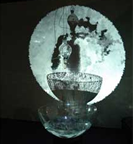
Victoria Vesna's Water Bowls
The four Water Bowls, by Victoria Vesna, use of some of the latest scientific observations to revisit common metaphorical associations of water -- such as the reflection of the moon, a drop of water, the sound of water, and oil and water. The interactivity is activated when the water is touched in the physical space (Moon and Sound) or influenced via the internet by dropping water and money remotely (Drop and Oil).
When visitors touch the water in the Moon bowl, sounds are created, picked up by an underwater microphone and amplified. An animation of water molecules cycling from a heavily polluted state to clearing and back is then projected onto the water.
Sound is equally activated by touch, which generates a disturbance of the water reflection and allows the person to feel the vibration of sounds based on underwater pollution (such as sonar frequencies, explosions and submarines) as well as whale sounds and cell vibrations.
In Drop, a drop of water released into the bowl triggers images derived from maps of waterbodies that ripple away. At the project website, visitors can remotely release this water drop from a dispenser suspended above the bowl in the exhibition space. Online visitors are asked to identify themselves with the Nile, Ganges, Danube, Atlantic Ocean, or any other water body of their choice. The interface then pulls up a topographical map of the chosen location. The location of participants is mapped by tracking the IP address of their computer and pairing it on the map with the body of water with which they identify. They can then add a water drop to the bowl. The topographical map and the visitor's position on it are also projected onto the bowl in the exhibition space.
The Oil bowl contains both water and oil, which appear as clearly separated substances. At the project website, visitors can make a wish (by typing it in) and remotely release a copper coin into the bowl from the dispenser above it. The wish is projected onto the oil and visible on the wall behind the bowl as a visualization of dissolving particles.
Video presentation; other movies.
The installation is part of Second Natures, an exhibtion curated by Christiane Paul. Second Natures runs until October 26, 2006, at Eli and Edythe Broad Art Center, UCLA, Los Angeles.
More water-based works: Water gongs; Music from the pools; Musical droplets; the Blur building; Mocean, a musical environment that invites people to touch, stir and play with water in a tank<; Touch-sensitive water lights; Drink Water exhibition by Orta; Eavesdripping, Water as physical display; The bathroom as a biotop; Herz Fassen (Take Heart); Sound Flakes; Communication through tears; Breeding Space and Erez Kikin-Gil's Water Play. [blogged by Regine on we-make-money-not-art]
Posted by jo at 11:42 AM | Comments (0)
HTMlles Festival

EXPORT 2 Belgrade | Sofia | Istanbul
HTMlles Festival: EXPORT 2 :: October 19-29, 2006 :: Belgrade | Sofia | Istanbul.
From the 19th-29th of October 2006, a program of art works and artists that participated in the 7th edition of the HTMlles festival themed Peripheries + Proximities will travel to 3 cities: Belgrade, Serbia ; Sofia, Bulgaria; and Istanbul, Turkey with the goal of fostering new dialog and collaborations. Through a series of focused encounters, interactive workshops, artists talks, performances and short exhibitions, the traveling Canadian artists and their works will encounter numerous curators, gallerists, cultural operators, local artists and local publics in each of the 3 cities. The touring works will be presented in parallel to programming produced by local partners and translated in English and in the respective local languages. All events are open to the public, including the interactive workshops.
Visit the website for info on participating artists and city schedules:
Participating Artists and Curators include: Chantal Dumas[ca], Michelle Teran[ca], Caroline Martel[ca], Joanna Berzowska[ca/po], Jennifer Willet + Shawn Bailey[ca], Emily Hermant[ca], Andreja Kuluncic[cr], Maja Ciric[sr], Miroslav Karic[sr], Basak Senova[tk], Selda Asal[tk], Anica Vucetic[sr], Zana Poliakov[sr], Natasa Teofilovic[sr], Aleksandra Jovanic[sr],Yofka[bg], Veronika Tzekova[bg], Adelina Popnedeleva[bg], Diana Popova[bg], Greta Gancheva[bg], Leda Ekimova[bg], Nina Boyanova[bg], Yana Kostova[bg], Vladia Mihailova[bg], The Upgrade! Sofia and The Upgrade! Skopje, Ceren Oykut[tk], Ozlem Sulak[tk], Hatice Guleryuz[tk], Bengu Karaduman[tk], Filmmor Women's Cooperative[tk], Ulku Songul[tk], Melek Ozman[tk] and Tuna Erdem[tk].
Events in Belgrade: held at O3one Gallery and Kontekst Gallery: October 19-21.
Events in Sofia: held at the Red House Center for Culture + Debate: October 23-26.
Events in Istanbul: held at Plat Form Garanti Gallery and The Apartment Project: October 27-29.
The HTMlles Festival is an ongoing project of StudioXX, Montreal, Canada's foremost women's digital resource centre, in operation since 1995. The HTMlles Festival, started as an annual event focused on the position of women in cyberspace, has now evolved to become an international biennial project which includes all facets of new media and web art technologies. The Montreal events now stand as a globally-known meeting place for women and feminists working in creative digital mediums and the addition of circulation projects has created an international network for Canadian new media artists.
Following the EXPORT2 tour, the next HTMlles biennial event will be held in October 2007, in Montreal. As a major international event, the HTMlles Festival seeks submissions from international artists and academics and collaborations with international curators, and cultural operators. Visit the website for further details. www.htmlles.net :: www.htmlles.net/08/call.
StudioXX and the HTMlles Festival receive support from numerous governmental and private bodies including : The Canada Council for the Arts, Le Conseil des Arts et des Lettres du Quebec, Heritage Canada, The Municipality of Montreal and The Canadian Embassy in Ankara.
Kyd Campbell, HTMlles Festival Director
contact: info[at]htmlles.net
Posted by jo at 09:28 AM | Comments (0)
October 16, 2006
Oppera Internettikka - Protection et Sécurité
![]()
FearingS
What is fear? Why should you be afraid? What, who is to fear? Where does your fear come from? Participate in creating a collective voice about "fear". Help reveal its actual tendencies.
FearingS is a part of the project Oppera Internettikka - Protection et Sécurité by Annie Abrahams & Igor Stromajer.
Oppera Internettikka - Protection et Sécurité explores the poetics of a contemporary sound form -- live opera as a sound event for the audience in the form of a live internet audio broadcasting. In that way it combines the notion of the world wide web communication protocols and classical artspace -- an opera house. Opera is a very strictly coded form of art with a lot of passion, and internet is a lonely place of solitude and intimate communication which is becoming more and more fragile, dangerous and suspicious.
The theme of the project is security and protection, which refers both to private and personal safety issues in the present post-WTC world of high and intense but questionable security measures and to the internet as a global and therefore extremely vulnerable and unstable communication tool.
Three artists with specific roles (artist Annie Abrahams as mutter courage, intimate mobile communication artist Igor Stromajer as bigbrother and professional opera singer as French secret service agent) are performing a complex structure combined of sounds, voices, noises, internet audio files and sound-manipulating machines and are using these sounds to perform/sing/reproduce a story for the audience present in the opera house, and for those following the audio part of the project live on the internet worldwide.
The libretto for the opera is composed out of three sources -- mutter courage is using the texts written and proposed in advance by the online visitors, bigbrother's only lyrics comes from a web search engine which he is manipulating in realtime, and the secret service agent is singing the HTML source code (Hypertext Markup Language - the authoring software language used on the internet's world wide web for creating world wide web pages) and Java scripts (JavaScript is a script language - a system of programming codes that can be embedded into the HTML of a web page to add functionality) from specifically selected French secret service web sites, openly available on the internet.
It is a new media project filled with abstract emotions, created in a valuable tradition of Bauhaus musical theater mixed with Dada, sound poetry and contemporary digital means of expression. Therefore the location of L'Opéra National de Montpellier has been selected to emphasize our efforts of introducing new artistic forms and production processes to the audience.
Project supported by The Ministry of Culture of the Republic of Slovenia, The Ministry of Culture of the Republic of France, The Municipality of Montpellier, The Council of the Languedoc-Roussillon region and Rhizome.org 2006-2007 Commissions. Co-produced by Intima Virtual Base (Slovenia), Panoplie.org & bram.org (France)
Posted by jo at 06:15 PM | Comments (0)
Simon Elvins

Interactive & Audible Print
Simon Elvins, a graduate from MA Communication Art & Design at the RCA, has created a number of interesting works dealing with print as an interactive interface for sound.
Notation: “This is part of an ongoing exploration into sound, print and notation, and looks at ways of linking sound to the printed page. Using a simple sounder, the project aims to directly relate tonal values of pattern and drawing, into a tonal scales of sound and music”.
FM Radio Map: “This map plots the location of FM commercial and pirate radio stations within London.The poster works in its own right as a piece of information design, but when connected to the modified radio it becomes part of the interface. Each map is made site specific by connecting only the stations that can be received in that location. This is done by drawing power lines in pencil on the back of the map, which conducts electricity from the radio to the front of the poster.Placing a metal contact onto each point enables us to listen to the sound broadcast live from that location”.
Sound Book: “Writings on the use of sound within Art and Design. Includes interactive typography and audio CD which can be played through the book when connected to a CD player”. Related post: connect..draw..remix [blogged by Chris on Pixelsumo]
Posted by jo at 12:00 PM | Comments (0)
The Tyranny of Nodes:

Towards a Critique of Social Network Theories
The Tyranny of Nodes: Towards a Critique of Social Network Theories by Ulises Ali Mejias :: Networks have become a powerful metaphor to explain the social realities of our times. Everywhere we look there are attempts to explain all kinds of social formations in terms of networks: citizen networks, corporate networks, gamer networks, terrorist networks, learning networks... and so on. Information and communication technologies—in particular the internet—and the structures they enable have greatly influenced how we imagine the social. It's similar to what happened in cognitive science when the computer was taken as the favored metaphor for explaining how the brain works, except that now we are attempting to explain how the social works.
But is there something anti-social about imagining and organizing our social realities in terms of networks?
Most critiques of the rise of the network as a model for organizing social realities focus on what it has replaced: tightly-woven, location-specific communities (a community itself can be defined as a particular kind of network, but for the moment let's stick to these conventional terms). Wellman (2002) traces how social formations have developed from densely-knit traditional communities to sparsely-knit but still location-specific “Glocalized” networks (think cities connected to other cities), to networks unbound to any specific physical space, or what he calls Networked Individualism, where "people remain connected, but as individuals rather than being rooted in the home bases of work unit and household." (p. 5)
Thus, an important characteristic of Networked Individualism is the overcoming of physical space. Today's networks connect individuals regardless of the distance between them. This has led various authors to announce—some with glee and some with regret —the Death of Distance. But more than its elimination, Networked Individualism promotes the reconfiguration of distance: it is not only our relatonship to the far that is changed, but also our relationship to the near. Of course, early on critics sensed a threat to the near in this reconfiguration, and saw in Networked Individualism the destruction of communal location-specific forms of sociality (i.e., the irrelevancy of the near). However, this has not proven to be necessarily the case, as Network Individualism can play a part in (re)connecting people to the local. The network then also becomes a model for "reapproaching nearness" (Mejias, 2005), with the added benefit that nearness now encompasses new forms of global awareness. [continue reading at I D E A N T]
Posted by jo at 11:17 AM | Comments (0)
Paul Johnson's
Networked Games
Paul Johnson's work makes use of nonlinear narratives produced by networked video game systems. I design the physical game console and game in tandem. There is usually an operational relationship between the design of the console and the content of the game. I became interested in a joint project with Sunny Kim because notions of constructed realities and dislocation, which run throughout her work, are extremely relevant to many of the issues I confront when developing a video game system. My networked game systems evolve over time. Throughout this process, some of the control of the artist is surrendered to the game system. The premise of Budaechigae is to examine historical mechanisms that inform a relationship between Sunny and myself, and between our respective countries. This relationship is manifested in the Budaechigae video game system and "played out."
Posted by jo at 11:11 AM | Comments (0)
The Futures of Entertainment Conference

At MIT November 17,18
The Comparative Media Studies Program is proud to announce an exciting forthcoming conference, The Futures of Entertainment, to be held at MIT on Nov. 17 and 18. The event is designed to bring together leading thinkers from across the entertainment industry to speak about core issues around media convergence, transmedia storytelling, user-generated content, and participatory culture.
Speakers confirmed so far include The Long Tail's Chris Anderson, Flickr's Caterina Fake, DC Comic's Paul Levitz, Warner Brother's Diane Nelson, Big Spaceship's Michael Lebowitz, social networking researcher danah boyd, television scholar Jason Mittell, and many others, including representatives from MTV, Cartoon Network, Bioware, and other leading companies in this space. The event is free and open to the public but we ask that you preregister since seating will be limited. The event is being hosted by the Convergence Culture Consortium.
This program is a draft and may still change before the conference.
All events take place in the Bartos Theater in the MIT Media Lab (building E15).
Friday, Nov. 17
9-9.30am: Intro and Welcome: Henry Jenkins
9.30am - 12.30pm: Television Futures: Chris Anderson, Andy Hunter, speaker to be confirmed
12.30-1.30pm: Lunch
1.30-4.30pm: User-Generated Content: Caterina Fake, Ji Lee, Rob Tercek, Kevin Barrett
4.30-7.30pm: Transmedia Properties: Paul Levitz, Michael Lebowitz, Alex Chisholm
Saturday, Nov. 18
9-9.30am: Intro and Welcome: Jason Mittell
9.30am - 12.30pm: Fan Cultures: Diane Nelson, danah boyd, speaker to be confirmed
12.30-1.30pm: Lunch
1.30-4.30pm: Not the Real World Anymore: John Lester, Ron Meiners, speaker to be confirmed
Television Futures
New distribution methods, new revenue strategies and changing modes of audience engagement are transforming how television works. Off- and post-broadcast markets make 'old' television valuable as a continuing source of income and suggest new ways to reach viewers. Digital video recorders threaten the 30-second commercial but offer the possibility of more detailed information about audience members. Some television producers may reach out to consumers directly rather than going through the networks and networks are using online distribution to generate buzz about new shows before they reach the air. Creative responses to these challenges are re-writing how we understand what was once just the box in the corner.
User-Generated Content
Media culture is becoming more participatory, rewriting the relations between media producers and consumers. New tools and distribution platforms, a changing cultural ethos, and innovative corporate approaches to user-generated content are turning viewers into active participants. Innovation may occur at the grassroots level yet influence decisions made within corporate media. Yet, are media companies ready for the grassroots creativity they are unleashing? What challenges does greater user-participation pose to both producers and audiences? What corporate policies enable or retard the growth of user-generated content?
Transmedia Properties
The cultural logic of convergence lends itself to a flow of narratives, characters, and worlds across media platforms. Moving beyond older models based on liscensed ancillary products, transmedia extensions are now seen as expanding the opportunities for storytelling, enabling new kinds of entertainment experiences, building up secondary characters or backstory. Transmedia extension may also create alternative openings for different market segments and enable more extensive contact with brands. The great potential of transmediation is to deepen audience engagement, but this requires greater awareness of the specific benefits of working within different platforms. How are media companies organizing the development of transmedia properties? How are storytellers taking advantage of the "expanded canvas" such an approach offers? How do transmedia strategies impact the new integration between brands and entertainment properties? What new expectations do transmedia properties place on consumers?
Fan Cultures
Once seen as marginal or niche consumers, Fan communities look more 'mainstream' than ever before. Some have argued that the practices of web 2.0 are really those of fan culture without the stigma. Courted, encouraged, engaged and acknowledged, fans are more and more frequently being recognized as trendsetters, viral marketers, and grassroots intermediaries. Fan affinity is being seized as a form of grassroots marketing, representing the bleeding edge of brand and property commitment. The sophistication of fan-created products rivals the professional products they honor, sometimes keeping defunct properties alive long after their shelf life might otherwise have expired. How is the increasing importance of fan behavior re-writing the media landscape? What kinds of accountability should media companies have to their most committed consumers? What kinds of value do fans create through their activities? What are the sources of tension that still exist between media producers, advertisers, and fans?
Not the Real World Anymore
Virtual spaces are more than sites for emulating the real world. They are becoming platforms for thought experiments -- some of which involve fantasies we would not like to enact in the real world, others involve possibilities that we may want to test market before putting into practice. Much more than simulacra of Real Life or a 3D version of text-based Internet communities, online worlds represent new sites for considering questions of community and connectivity. Marked by user- creativity, online worlds balance, sometimes precariously, the rights of users with the rights of sponsoring organizations. As we move closer to the cyberpunk vision of a wholly parallel 'metaverse', questions of power, community, and property are coming to the fore.
Posted by newradio at 10:35 AM | Comments (0)
Interview with Burak Arikan
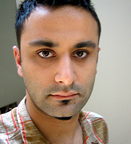
Pinkie and Open I/O ...
Since John Maeda's group at the MIT Media Lab has been renamed from Aesthetics + Computation Group (out of which Processing emerged) to Physical Language Workshop, also the focus of interest there slightly shifted. Physical hints less at physical computing than on a general interest in the mechanisms in which the world of networked systems interacts with the various worlds around it, for example with the world of art and that of economy.
We will have a closer look at the current main project Openstudio next week and start off with an interview of PLW's most recent graduate, Burak Arikan. In his work, he is indeed taking the interaction to a physical level by designing tools for "exploring electronic compositions through social means" in his projects Pinkie and Open I/O:
Burak, could you please tell us a bit about your background?
I grew up in Istanbul. It is a very complex place to live. Many social classes, lots of immigrants, beautiful geography, various religions, east west and in between, layers of culture, etc. etc. As a kid I played both on the streets and at home with computers.
I started designing and developing web sites with my friends during my civil engineering studies at Yildiz Technical University. I did some some personal projects and commercial work. After finishing the engineering degree, I went to graduate school and studied Visual Communication Design at Istanbul Bilgi University. While studying communication design, I also worked as a visual designer and information architect with several teams and Internet companies in Istanbul. I moved to Baltimore in 2003 and built commercial projects including community web sites, telecom / web products, shopping sites, and social networking services. I ceased all the commercial activity in the summer of 2004 to attend graduate school at MIT. [continue reading at we-make-money-not-art]
Posted by jo at 10:35 AM | Comments (0)
Futherfield.org

Become a Reviewer
Furtherfield receives regular submissions from artists and groups from all over the world, inviting us to feature and review their projects. We have an excellent team of reviewers working with us at the moment. Yet, because we are receiving more innovative and high quality media artworks from different cultural contexts, than we ever have before, we are finding it hard to keep up. So, now we need even more reviewers.
In November 06, Furtherfield will have a brand new design with new features that enable reviewers to have more control over their own text, images and different formats when reviews are submitted. We welcome contributions from all kinds of writers - but would especially value bi-lingual reviewers who are able to introduce work created by artists in non-English-speaking cultures.
We are also interested in people who understand and know net art, software art, social networks, live net art, live Internet tv, open source, tactical media, art blogs, net films, media art connected- self institutions, psychogeography, activist games, media art related exhibitions online and in spaces, and related conferences.
As a reviewer you will be asked to select from these works and contribute to the context of what is being created and write about why it is relevant. You will also have the option of seeking out and writing about other works that you personally think should be seen on Furtherfield.
If you possess knowledge and enthusiasm for any of these subjects, are able to write and communicate clearly;-) and are interested in being part of a explorative group, that is growing daily as an adventurous community in its own right. And like us, are passionately and critically engaged in investigating the constant shifts and reinvention of the creative, digitally related vista as we know it; we welcome you aboard...
contact - marc garrett:
marc.garrett[at]furtherfield.org
http://www.furtherfield.org
Other projects related to Furtherfield:
http://www.http.uk.net
http://www.visitorsstudio.org
http://blog.game-play.org.uk
http://www.nodel.org
http://netartfilm.furtherfield.org
http://www.netbehaviour.org
http://www.furthernoise.org
Posted by jo at 10:26 AM | Comments (0)
EAR APPEAL
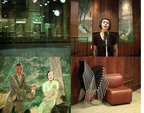
Control and the Production of Space
EAR APPEAL :: 19.10.2006 – 18.11.2006 :: Artists: Rashad Becker (DE), Justin Bennett (GB/NL), Benjamin Bergmann (DE), Elisabeth Grübl (A), Arthur Köpcke (DE/DK), Genesis P-Orridge (USA), Ultra-red (USA), Ruszka Roskalnikowa (PL), Paula Roush/msdm (PT/GB), Mika Taanila (FIN), Annette Weisser (D) :: Curator: Doreen Mende :: Kunsthalle Exnergasse, Währingerstraße 59, 2nd staircase, 1st floor, A 1090 Vienna.
"Listening to music is listening to noise, realizing that its appropriation and control is a reflection of power, that is essentially political." – Jacques Attali
Our sonic environment has a far more direct impact on daily actions than just suggestive image production. Soundscapes define economic, social, and cultural territories. In response to the question “How does sound influence our society?”, eleven artists deal in site-specific works with two issues: control and the production of space.
Ear Appeal is not a sound-art exhibition: instead, it approaches sound as conceptual and analytic material, examining the ways sound defines space and exerts control.
Every day, we are surrounded by sound waves in the city, functional music in shopping malls, elevator music, telephone please-hold-the-line loops, and the comforting tinkles in hotel lobbies, restaurants, and doctors’ waiting rooms. Audio-branding confronts us through radio and television, but also in the slam of a car door or the crunch of a cookie. We perceive noises not only with our ears: sound waves are also absorbed by the skin, nose, mouth, and bones. In the sixties, a standard slogan of Muzak Inc. was “Boring work is made less boring by boring music.” The intentional sound of muzak, a concept developed in the 1920s to describe functional tape music designed for specific target groups, is one of the best examples of how music and silence are used in the control and surveillance of consumer behavior in supermarkets, but also in factories, parks, clinics, and swimming pools. Here, the Foucauldian internalization of discipline and power is perfected on the level of hearin g.
As John Cage stated, there is no absolute silence. Sound defines space and space allows sound to be perceived. A key approach of several works in the show, some of them new, is the mapping and unraveling of sound phenomena in the political and social fabric of urban Vienna. These methods develop a direct relationship with the city, functioning as an inventory and acoustic field guide. An exhibition on the theme of sound in public and social space cannot take place solely indoors. Research, radio transmissions and on-site institutional cooperations will expand the exhibition space of the Kunsthalle Exnergasse out over the city, the source of the material being explored.
In her new work, produced in the venerable broadcast hall at Austrian Radio (ORF), Annette Weisser questions definitions of cultural identity. Based on a series of interviews in Berlin, Paris, and Vienna, Rashad Becker’s installation creates an audio feature on people’s understandings of work. The contribution of Fluxus artist Arthur Köpcke takes a BBC radio program to absurd lengths. In a text piece, Genesis P-Orridge focuses on how we can use information and strategies to fight a guerilla war against muzak. Artist and filmmaker Mika Taanila documents the phenomena of functional music. Ruszka Roskalnikowa translates familiar strategies of video surveillance to sound. Sound cannot always be escaped in the same way images can, as visitors experience in sculptural installations by Benjamin Bergmann and Elisabeth Grübl which push the relationship between sound waves, the body, and the space to extremes. As part of his ongoi ng cities project, Justin Bennett contributes a cartographic audio recording of Vienna. Urban space is analyzed by Paula Roush/msdm in terms of protest culture: including a workshop, her piece is the latest installment in her Protest Academy project. The installation by Ultra-red is the setting for a gathering where political activism and artistic praxis are discussed via the concrete question of how the concept of ‘poverty’ in Vienna can be differentiated and defined in acoustic terms.
Wednesday, October 18, 19:00 - Exhibition opening
Saturday, October 21, 12:30 - Encuentro fascilitated by Ultra-red/Manuela Bojadzijev (Berlin) and Dont Rhine (Los Angeles)
Saturday, November 11, 14:00 - Protest Academy Workshop with Paula Roush/msdm
Sunday evenings (October 29, November 5 + 12, all starting 23:05): “Ear Appeal” on Ö1 Kunstradio.
A cooperation with Ö1 Kunstradio.
Kunsthalle Exnergasse
Tuesday – Friday: 14:00 – 19:00
Saturday: 10:00 – 13:00
Contact: Christina Nägele
christina.naegele[at]wuk.at
Tel +43.1.40121-41
Währingerstraße 59
2nd staircase, 1st floor
A 1090 Vienna
Posted by jo at 09:57 AM | Comments (0)
OPTRONICA

Call for Submissions
A hybrid of music/film festival :: OPTRONICA: visual music on the big screen :; March 2007, London at the BFI Southbank (NFT) & BFI IMAX.
Playstation teams up with the BFI and leading audiovisual artists/producers Addictive TV with new-media curators Cinefeel to present Optronica, a hybrid of music festival and film festival taking place over 5 days in March 2007. Optronica explores the fusion of music and visuals, and features live audiovisual performances, screenings, talks, workshops and related special events. The festival will be held at the BFI IMAX and the newly renovated National Film Theatre, which will re-open as BFI Southbank on 1 February.
:: CALL FOR SUBMISSIONS :: visual music animations / music videos / video installations :: For our cinema screenings, we're looking for innovative and unconventional music videos, ambient and experimental work, animations, audio/video remixes and video cut-ups that express or explore the close relation of music and image. We're open to all styles of music and all styles of images, be they created on celluloid or in the digital domain.
We are also looking for video installations that utilise this close relation of music and image; these can be interactive and preferably for a single screen exhibit. These installations will be hosted in one of the new BFI Southbank spaces over the five days of the event as part of the Optronica Lounge.
DEADLINE: Friday 1st December.
Please download a submission form and details from here www.optronica.org.
The cinema programmes are curated by Cinefeel who, for over a decade, has been promoting new media culture and music videos as an artform in their own right. Cinefeel has programmed for major international festivals and organised countless music/video events.
Posted by newradio at 09:45 AM | Comments (0)
October 15, 2006
Turbulence Commission:
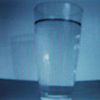
"Nothing Happens - a performance in three acts"
Turbulence Commission: Nothing Happens by Nurit Bar-Shai, Zachary Lieberman and Rich Miller :: Nothing Happens is a networked online performance in which the viewers work together to make a series of objects tip over. The performance consists of three acts, which are centered on staged environments – a high shelf, a cluttered tabletop, and a deserted corner. Each scene contains a central protagonist, respectively: a cardboard box, a clear pint glass full of water, and a wooden chair. In all three acts, web-enabled physical devices controlled by the viewer’s clicks will make these objects tip over.
The three acts will be presented on October 15th, 22nd and 29th at 3rd Ward gallery Brooklyn. Please join the artists for an opening reception Sunday, October 15, 2006 6-8 p.m.
"Nothing Happens" is a 2005 commission of New Radio and Performing Arts, Inc., (aka Ether-Ore) for its Turbulence web site. It was made possible with funding from The Greenwall Foundation. Additional support from 3rd Ward Gallery.
BIOGRAPHIES
NURIT BAR-SHAI'S main interest lies in exploring tensions between the mundane and the uncanny in everyday life. Emanating from her creative roots in fine arts, Bar-Shai employs video and new technologies to explore fundamental questions of presentation and representation, to reframe the familiar and turn audiences into foreigners in their own ontological domains.
ZACHARY LIEBERMAN'S work uses technology in a playful and enigmatic way to explore the nature of communication and the delicate boundary between the visible and the invisible. He creates performances, installations, and on-line works that investigate gestural input, augmentation of the body, and kinetic response.
RICH MILLER is a sculptor and a recent graduate of the Interactive Telecommunications Program at NYU. His creative energies are focused on making electro-mechanical pieces that humor him, as well as designing and fabricating innovative and dynamic children’s museum interactives and furniture. He lives and works in Astoria, NY.
Posted by jo at 02:15 PM | Comments (0)
Enter_ and Norwich International Animation Festival
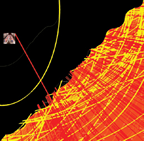
ART ON AUTOPILOT
Enter_ and Norwich International Animation Festival invite you to ART ON AUTOPILOT :: 19th October 2006, 6.30-8.00pm :: The Puppet Theatre Studio, Norwich :: FREE :: Please join us for drinks afterwards. Places are limited! RSVP by 18/10/06 to sarah[at]junction.co.uk.
An evening of generative systems, intelligent algorithms, ideas as code and drawing machines, with: Marius Watz [D] visual hedonist and generative art pioneer / Dave Miller [UK] on experiments with digital interactive stories / Paul Brown [UK/F] on the future of muzac: generative music / Geoff Cox [UK] artist, teacher and project organizer between software and generative art.
Enter_ is a creative network that brings together artist, researchers and businesses that work at the intersection of art and new technology in the East of
England.
Posted by jo at 11:26 AM | Comments (0)
October 14, 2006
Antony and the Johnsons with Charles Atlas
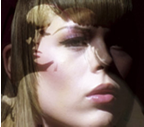
European tour of Turning
Antony and the Johnsons with Charles Atlas – European tour of Turning :: 31 Oct – 10 Nov 06.
Turning combines the haunting and dramatic music of Antony and the Johnsons with a vivid visual backdrop provided by award-winning film director and video artist Charles Atlas. The live performance features a simple yet moving orchestration from an ensemble of eight musicians alongside Antony, as well as video footage of fourteen NYC Beauties, whose intimate and hypnotic portraits whilst slowly turning onstage are captured, processed and projected by Atlas.
By combining Atlas’ innovative live video processing with Antony’s vocal stylings, which have been compared to the likes of Nina Simone and Lotte Lenya, Turning explores issues of innocence, metamorphosis, and transcendence in a visually dramatic and highly compelling format. Turning was first performed at the Whitney Biennial at the Whitney Museum of American Art in New York, 2004.
:: 31 Oct & 1 Nov, Auditorium Parco della Musica, Romaeuropa 2006, Rome IT
:: 4 & 5 Nov, Barbican Hall, London, UK
:: 7 Nov, Olympia Hall, Paris, FR
:: 8 Nov, Palacio Municipal de Congresos, Madrid, ES
:: 10 Nov, Theatro Circo de Braga, Braga, PT
For full tour details visit http://www.forma.org.uk
Antony graduated from NYU’s experimental theatre programme before going on to receive an N.Y.F.A. fellowship for performance art and emergent forms. After a series of solo cabaret performances at the East Village’s Pyramid Club, he assembled the Johnsons and the band recorded its debut album in 1997. His harrowing voice, which Laurie Anderson called “the most exquisite thing that you will hear in your life,” has continued to gain the group acclaim, with the album I am a Bird Now (2004) winning the Mercury Music Prize, 2005. Over the past year the group has toured extensively across Europe, The States and Australia. Antony has toured with Lou Reed and appeared on his albums The Raven and Animal Serenade. He has also made various film appearances with directors such as Steve Buscemi and Sebastian Lifshitz.
Charles Atlas, an award-winning filmmaker, video artist, and pioneer of the medium of media-dance, has created work for film, theatre, television and such prestigious museums as the Whitney, NY and the Musée d'Art Moderne de la Ville de Paris. Best known for his acclaimed collaborations with choreographers, dancers and performers such as Michael Clark, Leigh Bowery, Diamanda Galas and John Kelly, Atlas spent ten years as film-maker in residence for the Merce Cunningham Dance Company; his feature-length film Merce Cunningham: A Lifetime of Dance won the Best Documentary Award at Dance Screen 2000 in Monaco. Recent dance-related pieces are Rainer Variations (2002), a video portrait of Yvonne Rainer, and two collaborations with Merce Cunningham: Views on Camera (2005) and Views on Video (2005).
Further projects featuring the work of Charles Atlas, November 2006, London:
• Hail The New Puritan, a survey of Charles Atlas's work in film and video, Tate Modern Starr Auditorium, 16 -20 Nov 2006, details at http://www.tate.org.uk.
• Instant Fame, an interactive video installation at the Vilma Gold Gallery, London, from 23 Nov– 3 Dec 2006, details at http://www.vilmagold.com.
Turning is produced by Forma and International Music srl and is co-commissioned by The Barbican & Fondazione Musica per Roma & Romaeuropa 2006
The first presentation of Turning in New York was co-produced by Arts at Saint Ann's, True Love Productions, UCLA Live! and Pomegranate Arts
Forma Arts and Media Producers is one of Europe's leading contemporary arts agencies specializing in the production of cross-artform projects. Pioneering new hybrid forms of music, visual art, film, new media, dance, theatre and live art, Forma’s international touring programme for 2006/2007 includes projects with alva noto [carsten nicolai]; Antony and the Johnsons; Charles Atlas; Gina Czarnecki; Ryoji Ikeda; Ryuichi Sakamoto and Lynette Wallworth.
For further information visit http://www.forma.org.uk
Posted by jo at 01:30 PM | Comments (0)
Thomas Beard
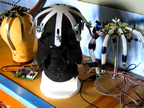
Interviews Eddo Stern
Interview by Eddo Stern, by Thomas Beard :; Commissioned by Rhizome.org.
Last month at Cinematexas, Eddo Stern unveiled Darkgame (prototype), a videogame installation in which two participants, playing against each other maneuver avatars around a two-dimensional plane, their movements projected against the gallery wall. What's unusual about this scenario is that the experience for both parties involves elements of sensory deprivation. One person is completely "blind," unable to view the main interface and responding only to nonvisual cues: the vibrations of a headset Stern designed to correspond with the location of the opposing player, and related audio signals. And while the other character is able to see the action play out in real time, the field of play becomes obscured when he or she is hit and small patches of gray begin to expand. Sure to open up new avenues for gaming, it's an education of the senses and a truly heady mod.
Well known for his work on such projects as Tekken Torture Tournament, where gamers endured electric shocks relative to the injuries of their onscreen fighters, and Waco Resurrection, in which players assume the role of David Koresh as government authorities advance on the Branch Davidian compound, Stern's art challenges and expands not only our relationships with videogames, but also the social and political histories from which they spring. In this interview, Thomas Beard speaks with Stern about his latest work, as well as MIDIs, memes, and the act of straddling the worlds of art, industry, and internet culture.
Thomas Beard: Let's begin with Darkgame. How did the piece evolve and when did you become interested in this idea of sensory deprivation in gaming?
Eddo Stern: Well, it's an old idea that I've been sitting on for a few years now. Before Waco I wanted to make a game where you can't see but it got sidelined. Eventually it evolved into this new gaming concept that I'm trying to work with, a kind of empirical role-play. In researching my article "A Touch of Medieval," I was getting to this place where role play breaks down: the idea of the "real"-non-roleplaying player, the real character action, how dexterous their fingers are, or how social they are or how aggressive, the idea of real physical and mental abilities versus the idea of role playing, how those aspects of the person eventually come through into a game and what it would be like to build games around these aspects.
Where it happened for me was in Everquest—because I have a really bad sense of direction—and in the early days of that game they made it hard for you to get around. There were no maps, so basically your memory and your sense of direction were all you had. Eventually they developed the Ranger class, and they had this ability called tracking. As a Ranger you would have an extra interface, like a radar you could use to navigate, and for me this was the decisive reason to "roll" that character class, a class that artificially compensated for a physical/mental weakness that I had. I was kind of like a bionic character; suddenly you're experiencing the opposite of what happens in real life—being the guy with the super sense of direction who people ask for directions
Two other big inspirations for Darkgame are certain Paul Bowles short stories—one is called "The Tender Prey," which has to do with torture and exoticism—and JG Ballard's "Manhole 69," which is about a sleep deprivation experiment.
TB: Do you see this particular project moving in new directions?
ES: I'm interested in making it a game that blind people and seeing people, for instance, could play together, a game where the abilities of the blind person would become a benefit in the game, a boon to them, kind of what I was talking about before, the relationships of different types of talents that people have and different types of disabilities that the computer processes into different character types. The game is going to evolve into a 3D game using Torque, which is the same engine we used in Waco, and I'm also going to play around with having the players fluctuate between deprivation and full sensory overload, bombarded by too much information. So for example having them process mental puzzles or challenges or quizzes while performing with hand-eye coordination. That's a part of the game that I'm pretty excited about.
You know Open Mind? It's a research project started at MIT, creating a database of common sense knowledge for an artificial intelligence by feeding it true/false statements, and last I checked they were up to three quarters of a million. Curiously, while I was researching this in the beginning of this year I found another project online called Mindpixel which is basically the same exact project except it's a corporate venture, not attached to a research institute. Something about this idea really hooked into me, and at the time I was using the data from the projects to make up elements of the overstimulation aspect of the game. So while you're playing, for instance, you come up to these big robots or creatures and they start bombarding the players with questions verifying truths from the database. As you're playing the game you need to respond yes-true, false-true and the questions move from being very scientific truths to historical truths to religious truths to truths where you really kind of stop in your tracks.
It also becomes kind of a language poem, this constant staccato of questions, anywhere from: "The universe is expanding. True or false?" to "White is a color. True or false?" So there's this idea of certain sensory deprivation where you will lose your vision as part of the gameplay and you'll lose your hearing and you'll gain this haptic feedback, which is the part that I demoed so far, but you'll also be dealing with this poetic-cerebral layer. Seems very simple at first but before you know it it's a really high computational order, your brain shuts down. I'm interested in stressing the brain, in this case logically, but also on a moral ethical belief level as well with more arbitrary questions about truth and what we know to be true.
TB: Along the lines of sensory deprivation and stress, considering past work like Tekken Torture Tournament and Cockfight Arena, you have a longstanding interest in transforming the experience of gameplay into a decidedly physical one. What do you find significant about those more corporeal aspects of your work?
ES: I think one of the quests for game designers is to enhance the gaming experience beyond these familiar experiences, categories. The idea of action is one that they've always done, the pleasure of action, that's sort of the main genre really. But game designers have gradually expanded the play arena to humor, games that make you laugh, to competition, to social games like The Sims, to nurturing games where you're building things. But for example horror poses a problem where cinematic devices used in horror movies simply don't work in games. I always find that horror games are really not that scary. The idea of genre that's inherited from film in the game design thinking process presents a lot of challenges, like drama or true suspense and horror. And I wanted to see if there's a way to design games that move into psychological realms of horror and suspense, beyond the boundaries of irony and cinematic clichés.
For me one place to reclaim a wider range of experience was to incorporate the body. In a way the body allows for an undeniability of certain emotions, fear is one that I've worked with, as well as surprise, anxiety and embarrassment. Tekken was trying to create an experience that can be quite scary for some people and that really heightens the gameplay. The idea of anxiety and stress in the face of physical harm, and the process of overcoming that, allowed a much more compelling experience for a lot of players. Cockfight was a more casual piece, there's a social element there of course, the physicality of the game allowed for players to really perform beyond the confines of something predefined and preprogrammed.
TB: I was also hoping we could talk about music. In a video like Vietnam Romance, for instance, there seems quite a bit invested in the pop mythologies of the songs you make use of and the powerful sway that the nostalgia they evoke holds over us. What kind of role do you see these soundtracks playing in your pieces, both individually and as a whole?
I use sound in two ways primarily, often simultaneously. I use music ironically and sometimes very unironically, employing their emotional force. Sheik Attack is a piece where the music is central to creating a rift between the more neutral, more mechanized visual footage that you see for most of the video, so most of the footage that's very lo-res is accompanied by very rich, baroque music that has a historical and political significance. At that time it was the most powerful tool I found I could use to metaphorically recreate this relationship between the emotional weight of utopian Zionism and growing up under its powerful ideology, and the reality of manifested Zionism which is much more rough and harsh and harder to come to terms with. The richness and warmth of the music and the cold tinniness of the visuals mirror this relationship and constantly temper each other.
Then in Vietnam Romance it's quite a different relationship because I used MIDI tracks. When you have a very emotional song and then strip out all the lyrics, all the human voice, but leave the melody, your preserve the emotional gush but also introduce a feeling of alienation. Somehow I feel this is the emotion of Nostalgia. Regarding the use of MIDIs, I once saw Alexei Shulgin use them in his show and that really inspired me, his use of a hollowed out emotion, a hollowed out Russian nostalgia for America.
And in the new piece I'm kind of going in a different place with the music. I was at the MacDowell Colony earlier this year and I heard a great musician who was there at the time, Elizabeth Brown. She played a beautiful piece that was Theremin and flute, pure sci-fi emotion, but not in the way that cheesy Theremin music can be. I was overcome by it, and in Darkgame, I am going for a science fictiony, yet politically referenced world. This whole recent history of post 9-11 events feels like science fiction to me. There was something about the way 9/11 happened that was so over the top, so fantastical, as I am sure many people feel, and images from Iraq and Afghanistan are still resonating on that layer, like a giant statue of Sadam being felled is so linked for me to JG Ballard's story "The Drowned Giant."
TB: Exactly, as though the past five years has just been one long alternate history story.
ES: Or the high-tech marine with the laser counter and F16s flying over him riding on a horse in Afghanistan. That was just crazy. The whole conflation is the visual inspiration for me towards the feel of the world that I want to recreate in Darkgame. Elizabeth Brown's music for me is that, a strange connection of science fiction and history—the sort of reality we're experiencing now.
TB: From film festivals to commercial galleries to conferences and seminars of various stripes, you've exhibited in a number of very different forums. Have you been struck by any interesting differences or similarities in how your work has been received or experienced from venue to venue?
ES: Yeah, it's interesting. The art world I think is somewhat aware of gaming art but is really fighting to process it on its own terms—of genre or its historical lineage as fitting it into a movement—and I think pop art is where it ultimately will fall. On the same hand, that fascination with pop exists in a parallel non art-world world, internet meme culture, which to me is really interesting. Recycling icons and mutating them through flash animations and Photoshop and what they now call mashups—All your base are belong to us, Punch a Spice Girl—is totally alive and well on the internet as digital folk art. Tekken was targeted in some ways for that audience, so once we did it we put up a little QuickTime movie and it had gotten picked up by Memepool and Metafilter and Fark and other Slashdot-like sites. It's funny that something like Tekken can work on both worlds at the same time, net meme culture and within a history of body art and performance as well.
Showing Waco at E3 was exciting, having the industry take a look. I think with games there's potentially a more complex relationship than we're used to with, say, products that you buy as gadgets versus fine art objects. The idea of a game busting into a gamer community, a game that's very different from what they're used to but that still adheres to some rules and standards of game design and gameplay technology, that's where I am most happy to be now. I can see game projects like Tekken and Waco and hopefully the new game project feeding back into a much larger awareness of what can be done both with gaming and art.
Thomas Beard is a writer and curator of film and electronic art. From 2005-2006 he was Program Director of Ocularis, a non-profit media arts organization based in Brooklyn. Prior to that he served as a programmer at Cinematexas, and has organized screenings and exhibitions at such venues as Aurora Picture Show, Chicago Filmmakers, MassArt Film Society, Pacific Film Archive, and the Museum of Modern Art, New York.
Posted by jo at 01:17 PM | Comments (0)
INCIDENT.NET / SERIES: THE DETAIL

Last Call for Participation
INCIDENT.NET / SERIES: THE DETAIL: DEADLINE: OCTOBER 31, 2006.
Important: Thank you to send us your netart/videoart project, a short description and your biography by email (incident[at]incident.net). Only the works using technologies (interactivity, generativity, network, etc.) will be selected. Thanks.
Between the subject and the object, between the perceiver and the perceived. As we shift from the detail to the entirety, the change in scale is ascertained through comparison. Can a detail exist all by itself? Would it still be a detail? Do we have to stop once we arrive at the detail? Can't we just keep going until the detail breaks up into endless fragments of further details?
We go from a human being to the body to the hand to the skin, the material of the skin, to pigments, eventually are we even looking at matter at all? The detail is a voyage of perception. What does perception see in a detail? Does it reflect? Is one detail ever alone? Once we reach the detail through this tortuous path of perception, don't we actually find ourselves in an infinite multiplicity? If our perception is shifting, doesn't this imply heterogeneity? How do we decide what is revealed by the visible, and what we see, and how relevant it is to us?
Today's technologies of memory also propose new ways of navigating, travelling through memory, radicalizing the question of the detail and of the other to which it necessarily refers. A detail is never alone, and when it is, it is testament to its isolation, because it is missing something. What is a detail on the Internet? How do we define a hierarchy by which we can go from the detail to the whole or vice versa? If it is hopeless to attempt to find anything which could be called 'the final detail' which would complete our whole, how can we even begin to speak of details?
Yet, we get the sense of never seeing anything more than fragmentary details. The whole is a default, as is reason. As we go from one detail, one perception to the next, we can stop, we may pause, but there is never a good reason to. The world is disconnected.
The detail concerns aesthetics as much as it does thinking. The word itself implies a hierarchy: a detail is something particular, an ornament, nothing of importance, something which may even be on the edge of nothingness. But it is also precision, sophistication, if not subtlety. It is still part of something, a piece, a remnant. The detail is not a concept.
Walter Benjamin described "a thought of detail": Let's remember this garden, this grass, these blades of grass, each blade is unique and has as much to do with the next blade as with anything else. It is through the irremediable vulgarity of thinking that we perceive anything that could be described as 'grass' forgetting the singularity of each detail.
How do interactive cross-referencing, database stratification, and the capacity for unceasing movement of today's technology account for this implied 'other' which is the aesthetic of details? Is it possible to elaborate a perception of details which does not refer back, through the sign of missing something, to an initial totality? A detail, but without nostalgia.
Gregory Chatonsky
Posted by jo at 01:07 PM | Comments (0)
Riot Gear for Rollartista
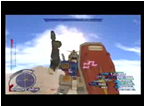
An Action Dedicated to African/Muslim Immigrants
Riot Gear for Rollartista: a blog and mobile gaming performance project by Anne-Marie Schleiner and Talice Lee. This blog is for posting information about a performance action we are doing in Castellon Spain on Saturday October 21, 2006 as part of an exhibition at EACC Espai d'Art Contemporani de Castell from October-January 2007. It will involve three short Machinima (stories told with video game footage) videos that will be beamed from an ultra-light projector stapped to one of our head helmets. (The videos are now linked from the blog to YouTube.) We sampled the two Playstation games Narc and MechWarrior. It sort of evolved into a violent (break) dance musical and each video is dedicated to an African or Muslim immigrant who was seriously abused by police in Spain or France. We, two American women in padded anime/riot gear/something else inspired moda, will be holding Playstation controllers and rollerskating at the same time, (and sometimes dancing), while we coast around projecting onto surfaces of the city.
After the performance/action we will also post documentation videos and photos on the blog.
Posted by jo at 01:01 PM | Comments (0)
October 13, 2006
Laurie Anderson with neuroscientist Antonio Damasio
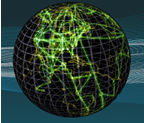
Live Webcast
Live Webcast of conversation with artist Laurie Anderson and neuroscientist Antonio Damasio, moderated by Professor Anne Balsamo, following a lecture by Anderson :; Saturday, October 21st, 8 p.m. (PDT) at USC's Norris Theater and simulcast FREE at HASTAC website.
Laurie Anderson: Recent Works :: Saturday, October 21st :: University of Southern California's Norris Theater :: 7 p.m. (PDT) :: Free and open to the public!
Laurie Anderson will present a special audio-visual lecture exploring the intersections of art, science and creativity. One of the permier perfromance artists in the world, Ms. Anderson has consistently intrigued, entertained and challenged audiences with her multimedia persentations. Anderson's artistic career has cast her in roles as various as visual artist, composer, poet, photographer, filmmaker, ventriloquist, electronics whiz, vocalist and instrumentalist. Following her presentation, Ms. Anderson will be joined in conversation by neuroscientist Antonio Damasio, director of the USC Brain and Creativity Institute and a leading researcher of cognition, emotions, and neural
systems.
This special presentation is part of the HASTAC In|Formation Year, devoted to twelve months of public programming from a number of universities meant to promote the human and humane dimenstions of technology and to encourage conversation and exchange between humanists, artists, technologists, and scientists.
Recognized worldwide as a leader in the groundbreaking use of technology in the arts, Ms. Anderson has collaborated with Interval Research Corporation, a research and development laboratory founded by Paul Allen and David Liddle, in the exploration of new creative tools, including the Talking Stick. Anderson has produced numerous albums and touring shows and has worked with artists and performers as diverse as William Burroughs, Arto Lindsay, Andy Kaufman, Ian Ritchie, Peter Gabriel, Perry Hoberman, David Sylvian, Jean Michel Jarre, Brian Eno, Nona Hendryx, Bobby McFerrin, Dave Stewart, Hector Zazou, and Lou Reed. She wrote the entry about New York for Encyclopedia Britannica, hosted the PBS special Art 21, and received the 2001 Tenco Prize for Songwriting in San Remo, Italy and the 2001 Deutsche Schallplatten Prize for Life on a String. Currently, Ms. Anderson is touring a new solo work begun during her tenure as the first artist-in-residence of NASA in 2003-2004. Other recent projects included a new commission for the World Expo 2005 in Japan and benefit performances on behalf of Hurricane Katrina victims.
Professor Damasio is a leading neuroscientist. His research interests are directed at the neural basis of cognition and behavior at large-scale systems level. The work is based on MR lesion method, PET/fMRI, and histological mapping of neuropathological tissue. Major contributions include:
(1) the elucidation of cortical and subcortical contributions to face and object recognition;
(2) the identification of specific neural sites involved in emotion processing;
(3) the demonstration that emotion is covertly implicated in decision-making; and
(4) the identification of limbic and brainstem sites of pathology in Alzheimer's disease.
Until earlier 2005, Antonio Damasio was at the University of Iowa as Van Allen Distinguished Professor and Head of the Department of Neurology. Damasio's books, Descartes' Error (1994), The Feeling of What Happens (1999), and Looking for Spinoza (2003), are translated in numerous languages and taught in universities worldwide. He is also the recipient of numerous awards (including, most recently, the 2005 Asturias Prize in Science and Technology; and the 2004 Signoret Prize, which he shared with his wife, Hanna Damasio). Damasio is a member of the Institute of Medicine of the National Academy of Sciences and a fellow of the American Academy of Arts and Sciences, the Bavarian Academy of Sciences, and the European Academy of Sciences and Arts. He has been named "Highly Cited Researcher" by the Institute for Scientific Information.
Professor Anne Balsamo is the Director of the Institute for Multimedia Literacy at the University of Southern California. She previously served as the Associate Director of the Stanford Humanities Lab and is a founding partner of Onomy Labs, a Silicon Valley-based technology design firm. She has faculty affiliations with Stanford University's Center for Design Research and its Feminist Studies Program. Until 2001, she was a principal scientist and a member of RED (Research on Experimental Documents) at Xerox PARC, where she did collaborative research on experimental documents and new media genres. She served as project manager and new media designer for the development of RED's touring museum exhibit, "XFR: Experiments in the Future of Reading." Her first book, Technologies of the Gendered Body: Reading Cyborg Women (Duke, 1996) investigated the social and cultural implications of emergent bio-technologies. She is currently working on a new book entitled Designing Culture: A Work of the Technological Imagination, which examines the relationship between cultural theory and the design of new media. She is a founding member of HASTAC.
This event is made possible by the USC School of Cinema-Television, the Institute for Multimedia Literacy, the USC Arts and Humanities Initiative, MOCA, and the Annenberg Center for Communication, among others. For more information, see http://www-cntv.usc.edu/resources/events/events.cfm
Posted by jo at 01:44 PM | Comments (0)
Upgrade! Vancouver

Matt Rogalsky
Next up for Upgrade! Vancouver is a talk by Matt Rogalsky on Wednesday, October 18 at 8pm.
Matt Rogalsky's work as a media artist often focuses on exploration of abject, invisible/inaudible, or ignored streams of information. Since 1985 his performances and installations have been seen and heard across North America and Europe. Most recently he presented the installation When he was in high school in Texas, Eric Ryan Mims used a similar arrangement to detect underground nuclear tests in Nevada, in a solo show at the Agnes Etherington Art Center in Kingston Ontario, and a new multi-channel sound work Memory Like Water, in a solo show on Hornby Island BC, presented by the GroundWater Foundation. A double CD documenting the past ten years of live performances, also entitled Memory Like Water, was released in July 2006 on XI Records.
At Upgrade, Rogalsky will discuss his installation Ellipsis (2001), on view at the Western Front, in which software "listens" to a single talk radio input. In the exhibition space we hear only the gaps between the words-the "silences"-as they occur in realtime, but amplified to a louder than normal listening level. A time counter projected on the wall shows the hours, minutes, seconds and hundredths of seconds of accumulated "silence", inexorably advancing with each fragment. This piece is one of several exploring aspects of "silence" in the media and in musical performance. It has previously been shown at Diapason (New York City, USA), Sleeper (Edinburgh, Scotland), the Slade Gallery (London, England), SoundPlay Festival 2004(Toronto), as part of the Digital Poetics and Politics symposium at Queen's University in 2004 (Kingston, Canada) and in the exhibition Disquiet curated by Christof Migone in 2005 for Modern Fuel Gallery (Kingston, Canada).
Upgrade! Vancouver (http://www.katearmstrong.com/upgrade/vancouver/) is curated by Kate Armstrong. It is one of 22 nodes currently active in Upgrade! International (http://theupgrade.net), an emerging network of autonomous nodes united by art, technology, and a commitment to bridging cultural divides. If you would like to present your work or get involved, please email kate[at]katearmstrong.com.
When: Wednesday, October 18 at 8pm
Where: Western Front, 303 East 8th Avenue, Vancouver, Canada
FREE! Everyone welcome.
URL: http://www.katearmstrong.com/upgrade/vancouver/
On NowPublic.
Posted by jo at 01:31 PM | Comments (0)
Ombea
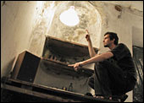
A Paradoxical Physical Interaction
'These people so scared by silence' Chuck Palaniuk writes in Lullaby, 'these sound-oholics are my neighbors'. To resist the siege of noise, some students from FAMU (Film Academy of Prague) has created OMBEA, an interactive installation, placed in a world populated by quiet-phobic people. The work reacts to visitor's movement according to a paradoxical equation. Four speakers, four light sources and two cameras are places within a space that is isolated from outdoor light and sound. Outside the interactive space there's the computer that controls Ombea reactions. These are: spectator physical movement equals darkness and noise, while his calm and immobility equals light and silence. The visitor is not provided with any instruction before entering the installation and he is forced to spend there eight minutes, the span of time necessary to perceive the space and the sensation of each movement. The lesson is similar to what people learn when they grope while they are fear drowning: quiet is necessary in order to float. Everything becomes clearer after all, when you think quietly. And this is the level of consciousness that the authors want visitors to reach through this controlled mediation that manifests the physical presence in a paradoxical style." -- Valentina Culatti, NEURAL.
Posted by jo at 10:37 AM | Comments (0)
GameScenes
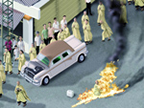
Art in the Age of Videogames
Video and computer game technologies have opened up new possibilities for artistic creation, distribution, and appreciation. In addition to projects that might conventionally be described as Internet Art, Digital Art or New Media Art, there is now a wide spectrum of work by practitioners that crosses the boundaries between various disciplines and practices. The common denominator is that all these practitioners use digital games as their tools or source of inspiration to make art. They are called Game Artists.
GameScenes explores the rapidly expanding world of Game Art in the works of over 30 international artists. Included are several milestones in this field, as well as some lesser known works. In addition to the editors' critical texts, the book contains contributions from a variety of international scholars that illustrate, explain, and contextualize the various artifacts.
ARTISTS: AES+F, Cory Arcangel, Aram Bartholl, Dave Beck, Tobias Bernstrup, Nick Bertke, John Paul Bichard, Marco Cadioli, Mauro Ceolin, Brody Condon, Joseph DeLappe, Delire (Julian Oliver), Todd Deutsch, Micah Ganske, Beate Geissler − Oliver Sann, Brent Gustafson, Jon Haddock, Margarete Jahrmann − Max Moswitzer, JODI, Joan Leandre, Miltos Manetas, Alison Mealey, Mark McCarthy, Shusha Niederberger, Nullpointer (Tom Betts), Nullsleep (Jeremiah Johnson), Totto Renna, RSG (feat. Alexander Galloway), Anne-Marie Schleiner, Eddo Stern, Palle Torsson, UBERMORGEN.COM.
AUTHORS: Matteo Bittanti, Rebecca Cannon, Pierluigi Casolari, Maia
Engeli, Henry Lowood, Sally O'Reilly, Domenico Quaranta, Philippa Stalker, Valentina Tanni.
Text in English and Italian.
Downloadable texts:
Matteo Bittanti: Game Art (Intro): www.gamescenes.org/images/GameArt_eng.pdf
Domenico Quaranta: Game Aesthetics (Outro):
www.gamescenes.org/images/Game_aesthetics_eng.pdf
Valentina Tanni: Geissler – Sann: Shooter:
www.gamescenes.org/images/Tanni_shooter_eng.pdf
More information:
Gamescenes.org: http://www.gamescenes.org/
Videoludica.game culture: http://www.videoludica.com/news.php?category=9
GAMESCAPES: THE SHOW
The release of GameScenes coincides with the launch of GameScapes. Videogame Landscapes and Cities in the Works of Five International Artists, a group show featuring works by some of the most celebrated artists working with digital games: Cory Arcangel, Mauro Ceolin, Jon Haddock, Eddo Stern, and Carlo Zanni.
Monza, September 16, 2006 — The Civic Gallery in Monza is pleased to present GameScapes. Videogame Landscapes and Cities in the Works of Five International Artists. Curated by Rosanna Pavoni with the collaboration of Matteo Bittanti and Domenico Quaranta, GameScapes investigates the notion of digital games, spaces, and urban environments in in our hyper-mediated age. Comprised of paintings, installations, and projections, the exhibition space will be transformed into a real-life gamespace.
Included in the exhibition are a video installation by Cory Arcangel, Super Mario Movie (2004), a series of paintings by Mauro Ceolin from the SolidLandscapes (2004-2006) series, Carlo Zanni’s interactive installation Average Shoveller (2004), Eddo Stern’s recent urban machinima Landlord Vigilante (2006) and the entire series of Jon Haddock’s seminal Screenshots (1999). Most of these artworks have never been presented in Italy before.
Johan & Levi is publishing the GameScapes catalog which features new commentary texts by Rosanna Pavoni, Matteo Bittanti, and Domenico Quaranta.
More information:
Gamescenes.org: http://www.gamescenes.org/
Videoludica.game culture: http://www.videoludica.com/news.php?category=9
Downloadable texts:
Press Release (italian only) -
http://www.clarart.com/mostre/civica/game.doc
Introduction by Rosanna Pavoni -
http://www.domenicoquaranta.net/GameScapes/Pavoni_eng.pdf
City of Bits by Domenico Quaranta (catalogue text) -
http://www.domenicoquaranta.net/GameScapes/Quaranta_cityofbits_eng.pdf
Art Gamers by Domenico Quaranta (panel) -
http://www.domenicoquaranta.net/GameScapes/Quaranta_ArtGamers_eng.pdf
Videogames as a mean of transport by Matteo Bittanti (catalogue text) -
http://www.domenicoquaranta.net/GameScapes/Bittanti_eng.pdf
GameScapes. Videogame Landscapes and Cities in the Works of Five
International Artists
curated by Rosanna Pavoni
Monza Civic Gallery
Monza, via Camperio 1
October 13 – 29, 2006. Free Entrance
From Tuesday to Sunday, 10.00 – 13.00 and 15.00 – 19.00.
Opening: Thursday October 12 from 6:30 PM
email: salecomunali[at]comune.monza.mi.it
Posted by jo at 09:25 AM | Comments (0)
October 12, 2006
Control + Shift.

Public and Private Usages of the Russian Internet
Dear All,
I am happy to announce the publication of the book of research on the russian internet. it's a great opportunity for those of you who don't speak russian to get acquainted with the digital cultures of the runet. The volume coves various issues, from aesthetics, diaspora, cultural identity, communities, and intelligenzia to gender, public sphere, polit technology, propaganda, pornography, and many more.
I myself contributed to this volume with the analysis of a new literary trend that I call "mate lit" (or male literature) - a bizarre mixture of brutality, protest and patriarchic mainstream - developed entirely through an online platform and becoming influencial in the offline domains.
"Control + Shift. Public and Private Usages of the Russian Internet". Eds. Henrike Schmidt, Katy Teubener, Natalja Konradova; Norderstedt: Books on Demand, 2006; ISBN 3-8334-4988-8; Price: 24,90 EUR. The volume is entirely available for download
enjoy your reading,
olga goriunova
Posted by jo at 02:12 PM | Comments (0)
V2_Test_Lab:
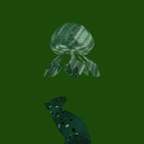
Immersive Mixed Reality Environments
Saturday 21 October 2006, Erasmus Medical Center, Rotterdam :: 11.00 – 12.30: Bioinformatics dept., Faculty building, 15th floor 12.30 – 18.00: Sophia Children’s Hospital, Cinema 3rd floor.
Test_Lab:/ Immersive Mixed Reality Environments/ is the product of a unique collaboration between the Erasmus Medical Centre and V2_, Institute for the Unstable Media with the aim of opening the dialogue between scientists and artists that apply Virtual Reality in their research and art practice. The event consists of demonstrations by Virtual Reality artists and scientists providing hands-on experiences with Immersive Mixed Reality Environments, and presentations by renowned international speakers presenting the latest in Virtual Reality in science and art. See below for the program details, a description of the projects that will be demonstrated, and the invited speakers that will present their work in the seminar.
Test_Lab is a bi-monthly public event hosted by V2_ that provides an informal setting to demonstrate, test, present, and/or discuss artistic research and development (aRt&D).
The event is free of charge, but registration is required before the 19th of October. For further information and registration please contact Remco Beeskow at press@v2.nl (tel: +31 (0)10 206 72 72) or Fred Balvert at f.balvert[at]erasmusmc.nl (tel: +31(0)6 41431721). Also visit www.v2.nl and www.erasmusmc.nl.
*Program*
(Saturday, 21-10-2006)
11.00h - 12.30h: Demonstrations:
- Sonia Cillari (/GATC/Life/)
- Anton Koning (Clinical and research demonstrations)
- Artem Baguinski (/Deep Limb Sensation/ by Pierre Proske)
12.30h - 12.50h: Reception
12.50h – 13.00h: Opening by Anne Nigten (Manager, V2_Lab)
13.00h - 13.45h: Peter van der Spek (Erasmus MC)
13.45h – 14.30h: Derek Hales (University of Huddersfield)
14.30h - 15.00h: Coffee break
15.00h – 15.45h: Yike Guo (Imperial College London / CEO InforSense
Limited)
15.45h – 16.30h: Maurice Benayon (Création Interactive
Transdisciplinaire Universitaire)
16.30h – 17.15h: Discussion
17.15h – 18.00h: Drinks
*Demonstrations*
(Saturday, 21-10-2006, 11.00h-12.30h,
Erasmus MC Bio-informatics dept., Faculty building 15^th floor)
- *GATC/Life*
Artist Sonia Cillari will demonstrate a project called /GATC / life/, which she realised as an artist-in-residence at V2_ and in collaboration with Erasmus Medical Centre’s Bio-informatics department.
/GATC / life/ is an immersive experience inside unities of life. The liquid multi-colored breathing membrane (the 'inside') contains flocks of cells and smallest particles/molecules having disordered human-like noisy behaviours. Our presence and actions can influence their configurations and growth within the space and around/near us. This work explores our perception in a condition of extended body dimensions and lack of control.
- *Biomedical research*
Anton Koning will demonstrate applications for clinical and fundamental
research.
- *Deep Limb Sensation*
Developer Artem Baguinski will demonstrate an art project by artist Pierre Proske called /Deep Limb Sensation/. The project is the result of an artist-in-residence period at V2_ funded by the Pauwhof Fonds and developed in collaboration with Erasmus Medical Centre’s Bio-informatics department.
In augmented- and virtual-reality environments one is often represented by avatars or virtual bodies/limbs. Deep Limb Sensation exploits this disconnection between our physical bodies and our bodies as we conceive them by having a person use their real arm to activate a "phantom" limb in a virtual world. The context in which this game-play takes place is a deep sea immersive underwater environment, in which a limb is controlled with the aim of touching another creature to accomplish a gentle act of virtual invertebrate love-making.
*Presentations*
(21-10-2006, 12.30h-18.00h,
Sophia Children’s Hospital, Cinema 3rd floor)
*Peter van der Spek *is professor at Erasmus MC University Medical Center Rotterdam and head of the Department of Bioinformatics. In a world awash with data there is an increasing need for effective methods of gaining insight into associated and underlying information. We need methods for visualizing information to support rapid learning and accurate decision making. The talk will emphasize on various aspects of information visualization using real world examples besides lifesciences and medical applications of computer generated interactive information visualization methods. Information visualization deals with the representation and presentation of concepts and data in a meaningful way. Depending on the medium used, information can be visualized in either traditional static form or more recent and powerful interactive and dynamic using virtual reality technology.
*Derek Hales *is Research Leader for the Department of Creative Technologies at the University of Huddersfield School of Art & Design, where he also leads the Multimedia subject area. He is a chartered Architect and a regional councillor of the Royal Institute of British Architects, chairing their Digital Futures Group. In the /Immersive Mixed Reality Environments/ seminar, Derek Hales will present his current research on exploring virtual environments and the impact of such environments on contemporary practice.**
*Yike Guo *is professor at Imperial College, University of London and head of the Data Mining Group at Imperial College. He is a world leading expert in large scale data mining and Grid computing. He will introduce DiscoveryNet, an e-science pilot project, aiming to provide a uniform framework for enabling a global collaboration for scientists in their data-driven scientific research. This project achieved its goal and has been successfully commercialized by InforSense limited, an Imperial College spin-out company. One key impact of the DiscoveryNet technology is that it establishes a new model for scientific collaboration as well as knowledge dissemination.
*Maurice Benayoun* is a media artist whose work explores the potentiality of various media from video to virtual reality, Web and wireless art, public space large scale art installations and interactive exhibitions. Benayoun's work has been widely exhibited all over the world and received numerous international awards and prizes. For the /Immersive Mixed Reality Environments/ seminar he will focus on the concept of ‘situation’ applied to art. Based on his 15 years experience in creating VR-based works, Maurice Benayoun will address topics such as: Experiencing representation through VR in metaphorical environments (Does this introduce the metaphysics of games or the mechanics of human dialogue?), semantic spaces as information to live in, the bible of the VR World: something to read by visiting, virtual architecture as being-prints, the foot prints of our experience in the symbolic world, and much more.
*Anne Nigten *is the manager of V2_Lab, the aRt&D department of V2_, Institute for the Unstable Media in Rotterdam, the Netherlands. She lectures on research and development in interdisciplinary fields from an art perspective and is advisor for several media art and science initiatives in Europe. Anne will moderate the /Immersive Mixed Reality Environments/ seminar and will use her experience in interdisciplinary debates to provoke a dialogue between the presenting scientists and artists, and the audience.
For more information please contact Remco Beeskow, V2_Communications press[at]v2.nl. Phone: +31(0)10-206 72 72. Website:
www.v2.nl
Posted by jo at 02:01 PM | Comments (0)
October 11, 2006
Interfering with the Magic
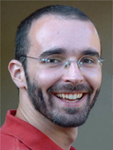
A talk on Ubiquitous Computing Systems
Interference in Deployed Ubiquitous Computing Systems
Abstract: Future ubiquitous computing environments are likely to consist of numerous interacting components, many of which will have been developed in isolation from each other. Unless appropriate measures are taken, interference (where a component’s behaviour in a deployed system differs from its behaviour when in isolation) is likely to be commonplace.
In this talk I will discuss the problem of interference in future ubiquitous computing systems and how it can affect many levels of a ubicomp system and be a concern for all ubicomp developers - ranging from those working on hardware and system support to those developing interfaces for user interaction and models of user understanding. I will also present two contributions that provide support for researchers addressing issues of interference in their systems. The first is a conceptual framework that includes a model of interference and generic solutions for preventing interference; the second is a simulation-based toolkit for helping researchers test their applications for interference prior to deployment. Finally, I will show the results of a formative evaluation that we conducted for informing the design of future user studies on conceptual interference frameworks.
Ricardo Morla, a PhD from Lancaster University is now a post-doc researcher at UC Irvine). His talk was given on Friday, October 6, 2006 at the Laboratory for Ubiquitous Computing and Interaction, IC Irvine.
Posted by newradio at 12:07 PM | Comments (0)
Mordechai Omer and Avi Rosen

The Ultimate Cathedral
"Abstract: This article examines the development throughout history of the means that man has used to locate himself at the center of the Universe. It surveys cathedrals throughout history, from the prehistoric era from the Pyramids to the Tabernacle, to the Gothic cathedral, the Sistine Chapel, the Panopticon, the Eiffel Tower, the radio and television station, up to the cyberspace era. In parallel there is an analysis of the human icon as expressed in art, through the beliefs in the various periods. The icons and structures reflect the scientific knowledge, technology, and philosophy of their respective periods that seek to create aesthetic effect through compressing space and time. The conclusion of the article is that we are part of the ultimate cathedral developing in the Universe, whose building blocks are the communication networks, like cyberspace that link diverse subjects and objects in a closed space in the manner of Georg Riemann's geometry. Existence in the ultimate cathedral is the continuous artistic act of a hyper-subject." From The Ultimate Cathedral by Mordechai Omer and Avi Rosen, September 2006.
Posted by jo at 10:28 AM | Comments (0)
NEW NETWORK THEORY International Conference
![]()
Call for Papers and Participants
NEW NETWORK THEORY :: 2007 ASCA International Conference :: Location: Amsterdam Dates: 28-30 June 2007 :: Organized by the Amsterdam School for Cultural Analysis (ASCA), the Institute of Network Cultures (Amsterdam Polytechnic) and Media Studies at the University of Amsterdam, has issued its first call for papers. The conference, to be held on Thursday, 28 June to Saturday, 30 June, 2007, also includes a public program with renowned speakers.
Deadline for Submission of Paper Abstract (500 words) and Biography (100 words): 10 January 2007 :: Submit to: networktheory[at]networkcultures.org :: Acceptance Notification: 1 March 2007 :: Further inquiries to: Dr. Eloe Kingma, Managing Director, Amsterdam School of Cultural Analysis, Oude Turfmarkt 147, Oude Turfmarkt 147, 1012 GC, Amsterdam, tel: +31 20 525 3874, asca-fgw[at]uva.nl.
The object of study has shifted from the virtual community and the space of flows to the smart mob. When the object of study changes, so may the distinctions that dominate, particularly the schism between place-based space and place-less space, both organised and given life by networks. We would like to exploit the potential of writing contemporary network theory that suits and reflects the changes to the objects of study that come to define our understandings of network culture – a post-Castellsian network theory, if you will, that takes technical media seriously.
It is time to look for elements that can make up a network theory outside of post-modern cultural studies (which marvelled at the place-less place) and ethnographic social sciences (which reminded us of the ground). What network culture studies needs is a ‘language of new media,’ perhaps even signage, to speak in terms of Lev Manovich; what it currently has is a science-centered ‘unified network theory,’ to paraphrase the language of Albert-László Barabási.
Whilst it may come as no surprise to critical Internet scholars, the notion that networks are not random but have underlying structures remains the key insight for network scientists. Instead of posing new questions, the work that follows from that insight often seeks to confirm that structure and its accompanying patterns, across more and more network-like objects. The question remains which specific contribution critical Internet scholars and practitioners can make to opening up network thought. Such is the purpose of the network theory conference. How must we rethink network culture with a renewed emphasis on technical media and social software?
Suggested Topics:
Networking and Social Life
Social Software and Insider Networks
Network Policy
Network Governance / Organised Networks
Actor-Network Theory and the Assemblage
Network Knowledge Production
Networks and Disengagement
Media Networks
The Link
Locative Media and Networks
Mapping Quests
Other topics may be suggested.
Prospective Themes and Panels:
Networking and Social Life
‘Networking,’ colloquially speaking, continues to be encouraged in our professional lives, but no one seems to have thought through how life would be guided if we apply network theory to professional ‘networking’ rather literally.
As network scientists’ terms and ideas spread, it is of interest to speculate about one’s social life governed by the power law, preferential attachment, hubs, self-organization, swarming and cascading effects. To network in a colloquial sense, essentially is to connect oneself with a hub. As the hub receives more connections (or becomes ‘preferentially attached’), the hub may become a superconnector, handling a disproportionately large number of connections relative to those of the other hubs in the overall network. As the network continues to grow through self-organisation, general knowledge of the existence of the superconnector may cause swarming behaviour.
A superconnector, network science reports, has the greatest vulnerabilities, however. If the superconnector cannot handle the traffic, the network breaks down. If there's breakdown, with or without cascading effects, which determines the extent of the damage, you’re on your own again. One implication is that one should continue to seek fresh hubs (as long as they last), and keep them from becoming overheated superconnectors. Hub-seeking behaviour, along with
superconnector-care, come to guide social life.
Social Software and Insider Networks
What if the social software model, which performs networking in private and public spheres simultaneously, came to dominate our social life? One could argue that we would witness the spread of insider influence. Would networking be the means by which we discuss and effect social change, above all else?
Having registered with social software, your friends may write to you, asking you to associate yourself with them and their acquaintances in an online environment. You cannot see your friends’ networks unless you join, too, making it something of a secretive realm at first. Invitations sent by the software are becoming more explicit about why you are invited, and the purpose of social software:
"Since you are a person I trust, I wanted to invite you to join my network on LinkedIn. I'm using it to discover inside connections I didn't know I had. It's interesting to see the level of access you can have with only a few people in your network."
It may be unreasonable to concern oneself with the prospect of everyone creating and building insider networks. The democratisation of insider influence (social software for all), however, seems contrary to (or perhaps helps to explain) the current infatuation with governance and transparency.
Network Policy
Moving to the level of social policy, we can ask about the effects of network-centric thought put into practice institutionally. We are used to the phrase, “it’s company policy,” as a justification for a particular decision that has been taken for you. “It’s network policy” is a phrase not yet in circulation. What if it were to change our ideas about what is ‘social’?
Perhaps it was the accessibility of Barabási’s Linked (2002) that prompted networks to be given to great expectations, ones they may not be able to meet and ones that may change our ideas about what is ‘social.’ In Linked, the special case studies and stories that connected the small community of social network researchers for so long grew beyond the realm of familiarity, dependability and implication. Network research was no longer in the business of studying social influence only, and usually after the fact.
Before, they asked: how did the Medici family increase its power base in Renaissance Florence (strategic marriage); which mid-western doctor should be approached by a pharmaceutical company to serve as the broker for spreading the word about a new product? With Linked, networks moved on to account for many other phenomena, including the spread of disease (HIV-AIDS). Since then network thought could very well lead to prospective planning; controversial action could be undertaken by employing a kind of ‘network policy’ that would supplant social policy.
Historically, waiting lists in hospitals, for example, were determined on the basis of first come, first served, where an extreme emergency would call for the queue to be jumped. With a network policy the hubs should be served first, as they have a greater chance to spread disease than the isolates. They are better networked.
Networked Multitude
Whereas networks hardly played a role in Hardt and Negri’s popular book Empire (2000), in Multitude (2004) the network form of organisation reached centre stage. According to Hardt and Negri, “the multitude must be conceived as a network, an open and expansive network in which all differences can be expressed freely and equally, a network that provides the means of encounter so that we can work and live freely in common”. Beyond good or evil Hardt and Negri, like the scientists, now see networks everywhere we look – “military organizations, social movements, business formations, migrations patterns, communication systems, physiological structures, linguistic relations, neural transmitters, and even personal relationships.” The multitude authors present distributed networks as a general condition. Hardt and Negri: “It is not that networks were not around before or that the structure of the brain has changed. It is that network has become a common form that tends to define our ways of understanding the world and acting in it.”
After September 11, 2001 the enemy is not a unitary sovereign state, but rather a network, Arquilla and Ronfeldt wrote in Networks and Netwars (2001). Networks move in to failed states, taking them over, allegedly, but without re-establishing the borders. The enemy, in other words, has a new, sprawling form. But that particular military insight reverberates to the technical media, too. According to planners of the war against terrorism the Internet is not well equipped to face up to the networked enemy, at least not with its currently protocol. Is the end-to-end principle on which the Internet is based increasingly viewed as quaint architecture?
Dawn of the Organized Networks
At first glance the concept of ‘organised networks’ appears oxymoronic. In technical terms, all networks are organised. There are founders, administrators, moderators and active members who all take up roles. Think back to the early work on cybernetics and the ‘second order’ cybernetics of Bateson and others. Networks consist of mobile relations whose arrangement at any particular time is shaped by the ‘constitutive outside’ of feedback or noise. The order of networks is made up of a continuum of relations governed by interests, passions, effects and pragmatic necessities of different actors. The network of relations is never static, yet is not to be mistaken for some kind of perpetual fluidity. Ephemerality is not a condition to celebrate for those wishing to function as political agents. The theory of organised networks is to be read as a proposal, a draft, a concept in the process of becoming that needs active steering through disagreement and collective elaboration. (See the Fibreculture mailing list, discussion on organized networks in November/December 2004 and Ned Rossiter's upcoming book Organized Net).
Needless to say, organised networks have existed for centuries. Their history can and will be written, but where would that bring us? The networks we are talking about here are specific in that they are situated within technical media. They can be characterised by their advanced irrelevance and invisibility for old media and p-in-p (people in power). General network theory might be useful for enlightenment purposes, but that doesn’t answer the issues that new media-based social networks face. Does it satisfy to know that molecules and DNA
patterns also network?
Truism today: there are no networks outside of society. Like all human-techno entities, they are infected by power. Networks are ideal Foucauldian machines: they undermine power as they produce it. Their diagram of power may operate on a range of scales, traversing intra-local networks and overlapping with trans-national insurgencies. No matter how harmless they seem, networks bring on differences. Foucault’s dictum: power produces. Translate this to organised networks and you get the force of invention. Indeed, translation is the condition of invention.
Mediology, as defined by Régis Debray (1996), is the practice of invention within the socio-technical system of networks. As a collaborative method of immanent critique, mediology assembles a multitude of components upon a network of relations as they coalesce around situated problems and unleashed passions. In this sense, the network constantly escapes attempts of command and control. Such is the entropic variability of networks. Network users do not see their circle of peers as a sect. Ties are loose, up to the point of breaking up. Some would say the user is just a consumer: silent and satisfied, until hell breaks loose. The user is the identity of control by other means. In this respect, the ‘user’ is the empty vessel awaiting the spectral allure of digital commodity cultures and their promise of ‘mobility’ and ‘openness’.
Networking and Disengagement
Networks are everywhere. The challenge for the foreseeable future is to create new openings, new possibilities, new temporalities and spaces within which life may assert its insistence on an ethical and aesthetical existence. Organised networks should be read as a proposal, aimed to replace the problematic term ‘virtual community’. It should put the internal power relations within networks on the agenda and break with the invisible workings that made out the consensus era. Organised networks are ‘clouds’ of social relationships in which disengagement is pushed to the limit. Community is an idealistic construct and suggests bonding and harmony, which often is simply not there.
The same could be said of the post-9/11 call for ‘trust’. Networks thrive on diversity and conflict (the notworking), not on unity, and this is what community theorists were unable to reflect upon. For them disagreement equals a disruption of the ‘constructive’ flow of dialogue. It takes an effort to reflect on distrust as a productive principle. Indifference between networks is a main reason not to get organised, so this aspect has to be taken seriously. Interaction and involvement are idealistic constructs.
Passivity rules. Browsing, watching, reading, waiting, thinking, deleting, chatting, skipping and surfing are the default condition of online life. Total involvement implies madness to the highest degree. What characterizes networks is a shared sense of a potentiality that does not have to be realized. Millions of replies from all to all would cause every network, no matter what architecture, to implode. Within every network there is a long time of interpassivity, interrupted by outbursts of interactivity. Networks foster, and reproduce, loose relationships – and it’s better to face this fact straight into the eye. They are hedonistic machines of promiscuous contacts. Networked multitudes create temporary and voluntary forms of collaboration that transcend, but not necessary disrupt the Age of Disengagement. The concept of organised networks is useful to enlist for strategic purposes.
Media Networks
After a decade of ‘tactical media’, the time has come to scale up the operations of radical media practices. We should all well and truly have emerged from the retro-fantasy of the benevolent welfare state. Networks will never be rewarded and ‘embedded’ in well-funded structures. Just as the modernist avant-garde saw itself punctuating the fringes of society, so too have tactical media taken comfort in the idea of targeted micro-interventions. Tactical media too often assume to reproduce the curious spatio-temporal dynamic and structural logic of the modern state and industrial capital: difference and renewal from the peripheries. But there’s a paradox at work here. Disruptive as their actions may often be, tactical media corroborate the temporal mode of post-Fordist capital: short-termism. It is retro-garde that tactical media in a post-Fordist era continue to operate in terms of ephemerality and the logic of ‘tactics’. Since the punctuated attack model is the dominant condition, tactical media have an affinity with that which they seek to oppose. This is why tactical media are treated with a kind of benign tolerance. There is a neurotic tendency to disappear. Anything that solidifies is lost in the system. The ideal is to be little more than a temporary glitch, a brief instance of noise or interference. Tactical media set themselves up for exploitation in the same manner that ‘modders’ do in the game industry: they both dispense with their knowledge of loopholes in the system for free. They point out the problem, and then take off. Capital is delighted, and thanks the tactical media outfit or nerd-modder for the home improvement.
The Link
What constitutes linking, and how could we describe its mirror phantom, or rather, its shadow? The link as a reference to another informational object only comes into being as a conscious act. There is no automated process of putting links. And there is no unconscious or subliminal linking either. These could all be worthy scientific propositions but as of yet they do not exist. Linking is tedious work. It’s an effort and should be considered ‘extra work’. There is no routine in linking. It’s a precise job that needs constant control. But the opposite of the conscious link is not the broken but the absent link. What is the
lifespan of links and networks?
Locative Media and Networks
The Internet has long been considered as the next step in the process of abolition of space and time constraints through media. Wireless and mobile media seem to have brought this process further along: people and places can be accessed anywhere any time. Paradoxically, the mobility of mobile phones, PDA's, portable game consoles, MP3 players and other devices have also re-introduced questions of space and place. 'Where are you?' is probably the most frequently used opening sentence of a mobile phone conversation. Activists, 'flash mobs' and soccer hooligans use mobile technologies to coordinate surprise actions at specific places and specific times. Mobile technologies have moved computer games from the desk-top screen into the streets (e.g., Pack Manhattan). Geographical Positioning Systems (GPS) and Geographical Information Systems (GIS) have given the term 'navigation' back its old meaning: from 'surfing in cyberspace' (remember Netscape Navigator) it has re-acquired the meaning 'finding one's way through geographical and physical space'. Streets, buildings, objects, animals and people can be 'tagged' in order to provide location-based and contextual information about their whereabouts, preferences, medical needs, bank accounts, sites, businesses, institutions, histories, and sales and discounts.
Cyberspace and the so-called 'real world' converge into what Lev Manovich has called 'augmented reality,' and in this 'augmented reality' it does matter where you are. Locative media allow people to map and share their own cartographies (which implies the dazzling theoretical possibility that there are as many maps as there are map-makers), but they also allow authorities to keep track of everybody and everything. Locative media (in combination with biometric technologies) might also give rise to two extreme forms of claustrophobia: on the one hand one might ask whether it will be possible to ever break out of one's own maps (a new variety of the Cartesian question), and on the other hand one might ask whether it will be possible to keep out of sight.
Conference organizers:
Geert Lovink (Institute of Network Cultures/University of Amsterdam) Sabine Niederer (Institute of Network Cultures) Richard Rogers (University of Amsterdam) Jan Simons (University of Amsterdam)
Locations: Pakhuis de Zwijger Media Warehouse (28 June), University of Amsterdam (29-30 June)
Posted by jo at 10:10 AM | Comments (0)
DOCS ONLINE
![]()
Film Festival Amsterdam
IDFA / CUT-n-PASTE presents the DOCS ONLINE programme :: 23 November and 3 December, 2006 Film Festival Amsterdam (IDFA).
In 2000, the International Documentary Film Festival Amsterdam (IDFA) started a special programme focusing on new practices and changes within the media landscape as set out by documentary filmmakers and their audience. This year, the Festival will reanimate this 'DOCS ONLINE' programme and provide a platform for the actual 'state of the art' in this field.
What can we say after five years? Interaction designers and filmmakers DO work together. Audiences ARE multi-channel users in getting their information and entertainment. The development of new media platforms and the availability of new devices used by large audiences require a different approach from the documentary field. While devices become cheaper and lighter new ideas can lead to new ways of storytelling.
During the coming Festival which takes place between 23 November and 3 December, 2006, DOCS ONLINE will focus on this theme. We plan to invite various (film)makers, artists and documentary storytellers who are inspired by new means and work in different ways. We would like to give the floor to these authors who use other channels and platforms and who interact with their audiences in new manners.
IDFA would like to make an appeal to filmmakers and artists to present their work in DOCS ONLINE. We, the editors (Cut-n-Paste), are urgently looking for interesting documentary projects.
DOCS ONLINE focuses on the actual 'state of the art,' and so we ARE interested in inspiring concepts which communicate strong content in a logical and effective way. Therefore, we are NOT looking for ideas to exchange material or collaborate in research and financing.
There MUST be a project we haven't heard about in the documentary world that you might have seen and we want to present to a bigger audience.
So, TELL us soon!
SEND your information to Cut-n-Paste: info@cut-n-paste.nl or to IDFA (adriek@idfa.nl)
Research and editors: Carolien Euser and Nathalie Faber (Cut-n-Paste)
Posted by newradio at 10:06 AM | Comments (0)
nonetheless l'm still here

a stop motion telematic performance
nonetheless l'm still here, by Nurit Bar-shai, is an online performance in which participants control telematically a simple scene consisting of a curtain flowing in space. The work consists of an installation in the real world, the people who participate, and the website which bridges the two, providing both a live video feed and an interface for users to interact remotely with the scene. Every time a user clicks the curtain moves in small steps. Each change is recorded as a snapshot, creating not only an archive of the work but a collective, creative result: a stop motion animation sequence.
The curtain which this work features is akin to a marionette, and is controlled by a system of small motors. It moves in steps according to users clicks. These mechanical motions only change the scene slightly, but over time, they combine to move the curtain in a way which conveys the natural sway of real fabric. In this manner, the work examines the tension between the organic and the inorganic, as well as the controllable and the spontaneous.
My goal in this project is to examine how real time, telematic performance, in which objects are controlled collaboratively, can be used to explore the poetics of the common and everyday. While the interaction described here is simple -- a user clicks and a small physical change occurs -- in presenting this simple metaphor of a curtain, filtered through multiple screens, the work suggests a compelling image for people to project on.
Posted by jo at 08:16 AM | Comments (0)
Cruel 2 B Kind

benevolent assassination
Cruel 2 B Kind is a game of benevolent assassination.
Because it's essential for players not to know who the other players are when the game begins, we do NOT meet up at a common location. Instead, you choose to show up anywhere within the game boundaries. You use your cell phone to send our game system an email with only "hello" in the body, and we know you're on-site and ready to play. See the Assassin's Guide handy pocket reference.
At the beginning of the game, you and a partner-in-crime are assigned a secret weapon. To onlookers, it will seem like a random act of kindness. But to a select group of other players, the seemingly benevolent gesture is a deadly maneuver that will bring them to their knees.
Some players will be slain by a serenade. Others will be killed by a compliment. You and your partner might be taken down by an innocent group cheer.
You will be given no information about your targets. No name, no photo, nothing but the guarantee that they will remain within the outdoor game boundaries during the designated playing time. Anyone you encounter could be your target. The only way to find out is to attack them with your secret weapon.
Watch out: The hunter is also the hunted. At the beginning of the game, you and your partner will also be assigned your own secret weakness. Other pairs of players have been given your secret weakness as their secret weapon, and they're coming to get you. Anything out of the ordinary you do to assassinate YOUR targets may reveal your own secret identity to the other players who want you dead.
As targets are successfully assassinated, the dead players join forces with their killers to continue stalking the surviving players. The teams grow bigger and bigger until two final mobs of benevolent assassins descend upon each other for a spectacular, climactic kill.
Will innocents be caught in the cross-fire? Oh, yes. But when your secret weapon is a random act of kindness, it’s only cruel to be kind to other players...
Not sure you're cruel enough to play as an assassin? Don't worry - you can still experience killer kindness. Just show up to any game site at the right time. You can hang out, watch the game, and play along as an "innocent bystander"!
Posted by michelle at 04:56 AM | Comments (0)
October 10, 2006
mikroPaliskunta

Seeking Identity on the Road
mikroPaliskunta is an art project that travelled through Finland from the northest Nuorgam to the southest Hanko studying contemporary image of Finland 21.8. – 4.9.2006. Who is Finnish? What are the symbols of Finland? How has the image of Finland changed? And who defines it? The expedition travelled by a biodiesel car that was packed with five artists and protagonist of the project; a stuffed reindeer Paavo that was searching for new members to its herd.
There was a camera attached to the Paavo's horn that took pictures in one minute intervals trough the whole trip for image line seen above. Paavo also collected stories about rendevous, phenomenon and national scenerys. There are also alternative postcards that have become very popular. You can browse trough the material via the image line or the drop-down menus on the left of the page.
There were happenings during the travel in Tornio 25.8. (Aine Art Museum), in Koli 29.8. (Art Center Kolin Ryynänen) and in Imatra 31.8. (Imatra Main Library). There was material from the travel presented in these happenings and also local artists shared their perspective to the theme. You can view documentations of the happening under the theme Happenings.
Posted by michelle at 01:21 PM | Comments (0)
Turbulence Fundraiser
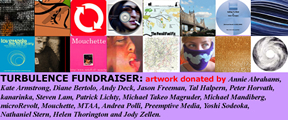
We Need Your Support
Dear Friends,
New Radio and Performing Arts, Inc. (NRPA) is 25 years old. Turbulence is celebrating its first DECADE, the only program to consistently commission net art for ten consecutive years. Despite the expansion of our projects, the acceleration of our support for net artists, and the valuable resources we provide in our networked_performance blog and New American Radio archive, NRPA has seen a decline in its operating support. As a result, much of our hard work forgoes compensation. Please help us support emerging artists and technologies, and preserve our valuable archives.
Our deepest thanks to Annie Abrahams, Kate Armstrong, Diane Bertolo, Andy Deck, Onomé Ekeh, Jason Freeman, Tal Halpern, Peter Horvath, David Jhave Johnston, kanarinka, Steven Lam, Patrick Lichty, Michael Takeo Magruder, Michael Mandiberg, microRevolt, Mouchette, MTAA, Andrea Polli, Preemptive Media, Yoshi Sodeoka, Nathaniel Stern, Helen Thorington, and Jody Zellen for contributing books, DVDs, CDs, archival prints, T-Shirts and more.
Please indicate which piece you would like when making your contribution. If the piece you want is no longer available, please consider making a donation anyway. Use a credit card to donate via PayPal or, if you'd prefer to send us a check, please email us at turbulence at turbulence dot org for details: type "Donation" in the subject line.
Allow us until January 2007 to ship your art work; if you'd like it earlier, please let us know and we'll do our best to get it to you.
With Gratitude,
Helen Thorington and Jo-Anne Green
Co-Directors
Posted by jo at 12:55 PM | Comments (0)
A Day in the Life: Streaming performance event
![]()
Call for Participants
A Day in the Life :: Streaming performance event :: @ Upgrade! International :: November 30, 3-5pm (Oklahoma City time) :: We are developing A DAY IN THE LIFE as a platform for simultaneous global performances and as a base for international collaborations. Urban spaces in Munich, Oklahoma City, Boston and Istanbul will be connected with each other via a streaming video server for the duration of the event.
At each location, local activity in and around the space is formally framed and streamed to all other locations. Thus the audience in each location sees the activities in four international cities at one time, and the full performance is only complete when viewing all four locations simultaneously.
The simple act of framing causes the viewer to impart the activities of daily life with meaning, following Marcel Duchamp’s dictum: "It is the viewers who make the pictures.” The construction of meaning is however aided by focusing on specific themes. This is done through targeted media interventions and activities that take place at all four locations simultaneously, and that at pre-arranged times react to a common theme. Daily life becomes a performance of itself.
Local activities will be framed by the lens of the video camera, but additionally, if the interior space has a view into the exterior space, for instance through a storefront window, the physical frame of the window can also define the exterior space as a stage for the activities.
Activities will ideally dynamically engage each local interior space with its respective exterior space, whether engaging passers-by in street performances or luring them inside as participants.
The full performance, viewed over all four locations at once, becomes a synergistic confrontation of chance occurrences at each location with the prepared interventions, plus the inevitable cultural differences between the four locations that become apparent as reactions to the common theme.
A DAY IN THE LIFE locates the global in the local. The peculiarities and characteristics of the location at which a given viewer happens to be are contrasted with the typical and untypical aspects of another location, another city, another country, coalescing into a poetic fusion.
A DAY IN THE LIFE creates connections, discovering the familiar in the foreign and the foreign in the familiar. It transforms your local streetcorner into part of a Do-It-Yourself global stage.
Concept:: Horst Konietzny & Tamiko Thiel
MoreMX.com / InterLake GmbH of Munich (Germany) and Jacksonville, Florida (USA) will be providing technical support and the streaming video server.
INDIVIDUAL PERFORMANCE CONCEPTS:
Realtime subtitles
Concept: Horst Konietzny
Text: Marlena Corcoran, et. al.
An author in each location writes a literary text in realtime, commenting on the local events and activities. This running commentary appears as subtitles at the bottom of the streamed image.
NEEDED: 1 writer who can produce a running commentary in English in realtime (if there's more of you, just switch off between yourselves.)
Realworld supertitles
Concept: Aram Bartholl
In many online worlds, players are represented by avatars, computer graphic figures, whose names float as text over the avatar’s head. Following Aram Bartholl’s instructions, people construct real “supertitles” for themselves which can be made to float mysteriously over their heads as they walk around the city.
NEEDED: whoever wants to participate!
Realtime networked music performance
Concepts: Christoph Reiserer
Concept #1) Musicians in each location improvise on the basis of phrases
played by musicians in all other locations. Concept #2) Beginning with a common, well-known musical score, the streamed images of musicians in each location are linked in a chain such that movements of musician in location A modifies in realtime the score seen by the musician in location B, etc.
NEEDED: 1 or more musician(s) who can either 1) improvise freely or 2) sight read well (or both)
Realtime video processing
Concept: Wolfgang Diller
The video from each location (ideally realtime stream from the local street scene) is altered and remixed by local VJs.
NEEDED: 1 VJ with own VJing setup
Realtime trading of upgrade node shares
Concept: Burak Arikan
Participating Upgrade nodes become traded companies on the Upgrade Stock Market. Each node gains or loses fair value depending on the number of people in its local room. People can buy and sell shares from a web based interface. Speculation on the values and the dynamic fair value of the nodes together affect the total valuation. Overall market activity is projected on a large screen in each node location.
NEEDED: whoever enters the room adds to Oklahoma City's share value -
and whoever buys or sells on the website trading interface affects the
overall market activity!
Contact Tamiko Thiel: tamiko at alum.mit.edu
Posted by jo at 12:45 PM | Comments (0)
ICEBOX 02 Audio/Visual Art Festival
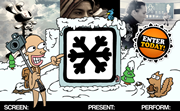
Call for Entries & Proposals
Tags: electronic music, sound art, digital film, animation, photography, video art, graphic design, interactive and generative media, Net art, video game art, electronics :: Deadline: 24 November 2006 :: Contact: Hein Bekker, hein[at]liquidfridge.co.za or +27 (0)82 508 2922
ICEBOX 02 Audio/Visual Art Festival, February/March 2007 :: ICEBOX is a collaborative festival of contemporary creativity in audio/visual art. With the focus on the electronic, open and South African, the festival combines music, film, video and interactive media through a programme of screenings, multimedia performances, club nights, workshops and an online exhibition.
ICEBOX enables the exchange of techniques and concepts between artists, media creators, technologists, academics and enthusiasts, and provides a space for participants to expand their creative vision and express their ideas through the innovative use of technology and artistic mediums.
Liquid Fridge, partnered by MTKidu and rustpunk, presents ICEBOX 02 in February/March 2007 in Cape Town, Durban and Johannesburg, South Africa. The festival is calling for the participation of established and emerging South African and international artists and professionals working in a broad range of disciplines including electronic music, sound art, digital film, animation, photography, video art, graphic design, interactive and generative media, Net art, video game art, electronics and open source advocacy.
Web: www.liquidfridge.co.za/icebox
Screenings and Online Exhibition
ICEBOX is open for submissions of short-form narratives, documentaries, music videos, experimental motion graphics and recorded visual performances for its screening programme.
Interactive media, generative art, Net art and other forms using Director(r), Flash(r) or Java(tm) software, as well as digital photography, illustration and graphic design work, may be entered for the online exhibition and a live presentation at ICEBOX.
Innovation is the main criterion, whether through creative use of technology or a storyline with a twist. Preference will be given to work relevant to South Africa and the continent. No commercials or showreels.
Selected entries will appear in South African creative magazines B(r)AND and Enjin, and in partnership with the "bring & burn" project Freedom Toaster, entries and source material under Creative Commons licence or in the Public Domain will be available for free in various locations around South Africa after the festival.
Enter: Send submissions with completed entry forms by Friday, 24 November 2006. Entry is free. Visit www.liquidfridge.co.za/?p=icebox_02_screen and www.liquidfridge.co.za/?p=icebox_02_web for details and entry forms for the screenings and the online exhibition respectively.
Club Nights
The ICEBOX sound system promises a selection of DJ'd and live retro-tech-future-funk rather difficult to define. Overlay a hearty serving of videoboxing and performing pixels, and you have an eclectic evening where the notions of "underground" and "overground" are irrelevant.
Provisional dates:
* Cape Town - 2 March 2007
* Durban - February/March 2007
* Johannesburg - February/March 2007
Format: Sets should be 30-60 minutes long, though this is open to interpretation. These may include DJ sets, band and electroacoustic performances, VJ/video performances, and various styles in between.
Enter: E-mail info[at]liquidfridge.co.za by Friday, 24 November 2006 with a short summary of the set, a supporting web link (if any), a list of required equipment, an estimated budget, and a biography. Do not e-mail any media - further materials will be requested if necessary.
Final dates for the club nights will be announced on the website, or you can ask to be informed by e-mail. Please note that, as with other Liquid Fridge public benefit activities, all parties donate their services to keep entry fees and costs down, which allows us to invest any proceeds in future projects. We are not able to pay normal artist fees, though nominal compensation might be in order.
Workshops
To facilitate exchange between the traditional creative practices and electronic subcultures, ICEBOX invites presentations, performances, demonstrations, discussion panels and hands-on experiments in all disciplines.
The main areas of interest include:
* Production and Performance - composition, animation, non-linear and interactive narratives, electroacoustic performance, cutting-edge DJing, video performance, live coding, improvisation and audiovisual synaesthesia
* Network, Mobility and Public Space - networked performance, field recording, locative media, ephemeral installations and guerrilla interventions
* Computation - generative processes, information visualisation, sensors and interfaces
* Re-creativity - mash-ups, circuit bending, reverse engineering and machinima
* Society - interdisciplinary collaboration, peer production, cultural identity in the age of global media, activism, demoscene and community-based arts organisations
* Rights and Distribution - open licensing, IP protection and delivery platforms
* Documentation and Preservation - emulators, digital archives and archiving tools
Speakers not able to attend the festival in person may present by prior recording or live videoconference, depending on the venue. Travel and accommodation can only be provided in special cases.
Technology demonstrations by vendors can be arranged in exchange for sponsorship.
Provisional dates:
* Cape Town - 28 February, 1 and 3 March 2007
* Durban - February/March 2007
* Johannesburg - February/March 2007
Format: Sessions should be 15-45 minutes long and will be followed by informal Q&A. Presentations should be comprehensive yet accessible to a non-technical audience. Audio and/or visual aids are recommended. Audience participation is welcomed.
Enter: E-mail info[at]liquidfridge.co.za by Friday, 24 November 2006 with a summary of the session, a supporting web link (if any), a list of required equipment, an estimated budget, and a biography. Do not e-mail any media - further materials will be requested if necessary.
Final dates for the workshops will be announced on the website, or you can ask to be informed by e-mail. Pre-recorded presentations should be submitted by January 2007.
Sponsorship
As ICEBOX is a non-profit initiative, contributions from private and corporate donors and sponsors in the creative and technology industries will be greatly appreciated. These include hiring of audiovisual equipment and venues, videography, photography, audio recording, printing and courier services, media exposure, and prizes. Please contact us if you are interested in supporting this project: Hein Bekker at hein[at]liquidfridge.co.za or +27 (0)82 508 2922. Formal proposals can be presented.
Liquid Fridge is a non-profit organisation devoted to advancing contemporary South African creativity by encouraging interaction between those who explore the creative uses of technology, and debating the issues of art, media, culture and society.
Started in 2002, Liquid Fridge aims to forge a sense of community and common purpose amongst these individuals and groups through workshops, club nights, screenings, online discussion and arts coverage.
On a path of shared creative consciousness, MTKidu is a beat construct and visual manipulation team formed in pursuit of an audiovisual language that is both experimental and dark.
As art galleries and clubs stagnate into white and grey cube commercialism, we will not forget the original purpose and potential of these spaces for invention and exploration. The time has come to break the conventional moulds.
rustpunk started out of a need for a unique party night with a diverse mix of music, steering clear of the single-genre format that everyone else seems to be hell-bent on dishing out.
Our performances include the screening and live VJing of video and motion graphic work, serving as a platform for South African artists. rustpunk is committed to challenging and enhancing the local scene, and promoting all things interesting being done with electricity.
About Creative Commons South Africa
The vision of Creative Commons South Africa is of a thriving African Internet community using Creative Commons licences to educate our people, grow our markets, share our knowledge, and celebrate Africa's culture and heritage with people around the world.
Creative Commons licences provide a flexible range of protections and freedoms for authors, artists and educators that build upon the "all rights reserved" concept of traditional copyright to offer a voluntary "some rights reserved" approach.
Freedom Toasters are self-contained, "bring & burn" facilities dispensing free and open source software and digital content. The kiosks provide a way for computer users in economically disadvantaged regions and areas with limited or no Internet access to get software, legally. By providing this service, the people behind the Freedom Toaster project hope to address the issue of the digital divide.
Partners
Logistics:
MTKidu - www.mtkidu.com
rustpunk - www.rustpunk.co.za
Suppliers:
Mike Scott - Illustration and Animation - www.bruandboegie.com
netbek - Design and Media - www.netbek.co.za
NetKeepers - Web Hosting - www.netkeepers.ca
Media:
B(r)AND Magazine - www.brandmagazine.co.za
Enjin Magazine - www.enjin.co.za
Interest Groups:
Creative Commons South Africa - http://za.creativecommons.org
Freedom Toaster - www.freedomtoaster.org
Venues:
CAPE Africa Platform - www.capeafrica.org
WSOA Digital Arts - www.wits.ac.za/artworks
Contact
Hein Bekker (Liquid Fridge)
Coordinator and Media Liaison
hein[at]liquidfridge.co.za
+27 (0)82 508 2922
Yalena Razis (Liquid Fridge/Big Love)
Coordinator, Cape Town
yalena[at]gmail.com
+27 (0)83 611 6622
Brad Roodt (rustpunk)
Coordinator, Durban
brad[at]rustpunk.co.za
+27 (0)76 508 7617
Dean Henning (rustpunk)
Coordinator, Durban
dean[at]rustpunk.co.za
Nicholas Nesbitt (MTKidu)
Coordinator, Johannesburg
mtkidu[at]gmail.com
+27 (0)72 213 7401
Postal Address (Cape Town)
Liquid Fridge
PO Box 780
Sanlamhof
7532
South Africa
Posted by jo at 10:34 AM | Comments (0)
October 09, 2006
Turbulence Commission:

"Self-Portrait" by Ethan Ham
Self-Portrait is a software search for the artist's face among the millions contained in the photos uploaded to www.flickr.com. The project's site displays three photos: 1) an ever-changing photo that depicts what is currently being evaluated by "Self-Portrait's" facial recognition software; 2) the most recent photo that was identified as containing a face. (The software often misses seeing faces and occasionally misidentifies an inanimate object as a face.); and 3) the most recent photo that has a high probability of depicting Ethan Ham (the artist). Clicking on this photo allows viewing earlier photos that were found to contain Ethan.
"Self-Portrait" is a 2006 commission of New Radio and Performing Arts, Inc., (aka Ether-Ore) for its Turbulence web site. It was made possible with funding from the Jerome Foundation.
Ethan Ham is a kinetic and new media artist who has recently moved to New York from Portland, Oregon. His projects often involve art generated by viewer participation, seemingly random events, and/or automated means. He is Assistant Professor of New Media at City College of New York, CUNY.
Posted by jo at 06:54 PM | Comments (0)
Event: Live Chat

New Media Poetics and Poetry
Leonardo Electronic Almanac begins a live chat discussion and moderated list to accompany the electornic issue themes.
Current speakers on New Media Poetry and Poetics include:
:: John Cayley - 9 Oct 2006 @ 1400hrs EST
:: Loss Glazier - 10 Octo 2006 @ 1900hrs EST
:: Stephanie Strickland - 20 Oct 2006 @ 1300hrs EST
:: MEZ – 17 Oct 2006 @ 0300hrs EST
:: Jason Nelson – 24 Oct 2006 @ 1300hrs EST
Live chats will use jabber, an open, secure, service. The New Media Poetics chatroom is on the jabber.org public server under the name "leanmp" and the password "leoalmanac.
Posted by michelle at 05:49 PM | Comments (0)
9 Evenings Lecture
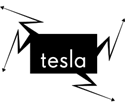
Berlin October 20
TESLA Berlin, Thursday 12 October, 20.30 h; (in English, free admission) The 9 Evenings performance series (1966) were a very important event in the history of performings arts and new media. The French art historian Clarisse Bardiot talks about this seminal moment for the interdisciplinary relationship between art and engineering.
http://www.tesla-berlin.de/_page.php?aktion=SHOW_PAGE&Page_ID=257.
Posted by newradio at 03:12 PM | Comments (0)
ARCHITECTURE AND SITUATED TECHNOLOGIES
[Locative] Reminder
The Center for Virtual Architecture at the University at Buffalo, the
Institute for Distributed Creativity, and The Architectural League of
New York present:
ARCHITECTURE AND SITUATED TECHNOLOGIES
October 19-21, 2006
@ The Urban Center & Eyebeam
New York City
http://www.situatedtechnologies.net
A 3-day symposium bringing together researchers and practitioners from
art, architecture, technology and sociology to explore new sites of
practice, research vectors, and working methods for the confluence of
Architecture and Situated Technologies.
Organized by Omar Khan, Trebor Scholz, and Mark Shepard, the symposium is a co-production of the Center for Virtual Architecture, The Institute for Distributed Creativity, and the Architectural League of New York, as part of the League's celebration of the 125th anniversary of its founding.
Participants: Jonah Brucker-Cohen, Richard Coyne, Michael Fox, Anne
Galloway, Charlie Gere, Usman Haque, Natalie Jeremijenko, Sheila
Kennedy, Eric Paulos, Karmen Franinovic, Kazys Varnelis
NOTE: Space is limited. Reservations/advance ticket purchase required.
Contact: Jessica Blaustein - blaustein@archleague.org or call
212.753.1722x13
Posted by newradio at 02:53 PM | Comments (0)
Jason Van Anden
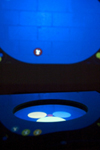
Compiled!
Friday, October 13, 2006
7:30 and 10:00pm*
MonkeyTown
Williamsburg, Brooklyn
Brooklyn new media artist Jason Van Anden is unleashing his new interactive sound composition software IntelligentDesigner (I.D.), through an audience participation event at Williamsburg's A/V mecca MonkeyTown. I.D. allows the user to manipulate the visual composition of an array of colorful bubbles, each with an assigned sound. It's elegant minimalist videogame interface enables a new kind of colloboration between artist and audience. As the user alters the visual field, they alter the order in which the sounds are initiated, creating a living song of their own creation.
At the MonkeyTown event four interactive kiosks will allow the audience to manipulate touch-screen versions of I.D. While participating artists will give the audience the sound palette, it will be up to the audience to construct these fragments into structures. As the four kiosks will be wired to enormous independent video screens, the audience will be submerged in the visual equivalent of the form they've chosen the compositions to live in.
An impressive slew of eleven local and international sound artists were invited to take this exciting new software for a test spin thanks to the excellent ears of musician Nat Hawks of Little Fury Things. Contributing artists include:
Leafcutter John (UK-renowned sound artist turned folk troubadour)
Datach'I (NYC-coveted post-jungle annihilist)
Nullsleep (NYC-world's favorite gameboy protégé)
Nonhorse (NYC-abstract tape collagist from the Vanishing Voice)
Lucky Dragons (Providence-tie died laptops of progressive flute cut-ups)
Jason Forrest (Berlin-propulsive prog math-up prince)
CloudlandCanyon (Germany-psychedelic casios bleed through digital fog)
Lullatone (Japan-heartbreaking tiny sounds)
Christian Science Minotaur (NYC-pastoral electro-acoustic)
Our Brother The Native (Michigan-fuzzy, blissful howling now on FatCat)
Flying (NYC- fun folk frenzied with pots and pans)
Local participating artists will be on hand at the event.
Compiled is curated by Nat Hawks for LittleFuryThings records.
MonkeyTown
58 N. 3rd (btw. Wythe and Kent) L to Bedford
http://MonkeyTownhq.com/compiled.html
Williamsburg, Brooklyn
TIME: (2 identical sets) 7:30pm and 10pm
PRICE: $10 **
*reservations strongly suggested (can be made easily through venue website)
** admission includes a data CD containing the IntelligentDesigner software and interactive compositions from participating artists.
Posted by newradio at 02:19 PM | Comments (0)
October 07, 2006
STRP Festival
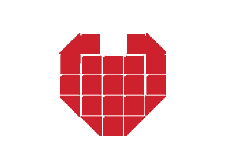
A Reminder
STRP - ART & TECHNOLOGY FESTIVAL EINDHOVEN, NETHERLANDS
CALL FOR PROJECTS - Deadline 20 Oct. 2006
After a successful first edition, the STRP festival, which took place
in Eindhoven, Netherlands at the end of March 2006, is launching a
call for projects for its next edition, which will be taking in late
April of 2007.
The focus of the festival is the common ground created at the
intersection between art, popular culture and technology. The first
edition which welcomed over 10 000 visitors, and received very
positive attention from the press, made use of performances,
installations, lectures, films, etcetera in order to convey this
crossroads.
STRP takes place on Strijp-S, the 'holy' ground of the forbidden city
of Philips, where in the 20th century numerous technological
innovations were made which changed the world. A place where Einstein
once worked, the first complete electronic music album was created and
the collaboration between le Courboisier and Varese resulted in one of
the most interesting amalgamations between art and technology, Le
Poeme Electronique for the World Expo in Brussels (1958).
FOR THE 2007 EDITION
STRP is looking for projects, installations, or proposals that concern
themselves with interactive art, robotics and/or Live Cinema (in the
live cinema category we are looking for projects that rely on both
performance and technology in order to become an audio-visual whole).
All of the above in a context in which the artistic side is furthered
by technology. This year we will also be paying special attention to
projects, which involve light in their concept, composition, and/or
execution.
The application forms are available in
PDF format - http://downloads.strp.nl/strp-call06.pdf
RTF format ? http://downloads.strp.nl/strp-call06.rtf
To find out more about the 2006 edition of the festival, including a
full line-up, press-releases and photographs please take a look at:
http://www.strp.nl
If you have further questions please contact us at projects@strp.nl
URL:
http://www.netbehaviour.org/pipermail/netbehaviour/attachments/20061006/067f
eacb/attachment-0001.html
------------------------------
Posted by newradio at 04:29 PM | Comments (0)
Game/Play at HTTP
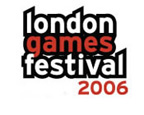
London Games Festival
HTTP were asked to be part of the London Games Festival, to introduce an alternative perspective of contemporary game culture from a grass roots level, in contrast to the traditional corporate elements that usually dominate these large and popular events. This is a major step forward for the London Games Festival group, and hopefully this will be the first of many 'Fringe' orientated opportunties, that serve in offering experimental and up and coming game artists/groups to have their work seen andc experienced by a diverse audience.
[giantJoystick] by Mary Flanagan was commissioned by the HTTP Gallery/Furtherfield.org and other independent video games selected by Corrado Morgana, are featured in the World Series of Video Games at the London Trocadero as part of the London Games Festival.
London Trocadero.
Friday 6th - Sunday 8th October
Open Fri- Saturday 10am-10pm, Sunday 10-5pm
7 - 14 Coventry Street,
London W1D 7DH
10am - 10pm
Information about London Games Festival
http://www.londongamesfestival.co.uk/Custom/EventDetail.aspx?ID=66
Information about the Game/Play (touring) Exhibition.
http://blog.game-play.org.uk
Information about HTTP Gallery.
http://www.http.uk.net/
Posted by luis at 11:17 AM | Comments (0)
Unofficial Off-Site Rhizome 10 Year Group Show and Idiosyncratic Link Party
"In the sprit of net art that once was and could be again, I’d like to again anouce the “Unofficial Off-Site Rhizome 10 Year Group Show and Idiosyncratic Link Party”. How can you get in on this historic event? 1.) Make some Net Art this year. 2.) Post the URL on Rhizome or just email it to me. 3.) If I like it, I’m posting it at http://del.icio.us/m.river . 4.) At the end of the year, I’ll make a homepage for the show. 5.) If you don’t like what I’m selecting, you can make your own “Unofficial Off-Site Rhizome 10 Year Group Show and Idiosyncratic Link Party.” Hell, if you make a better site, I’ll give you credit for the idea. Pirate an anniversary show. It’s easy. It’s fun. It’s totally net art."
M. River
Posted by luis at 11:07 AM | Comments (0)
GAMESCENES / GAMESCAPES
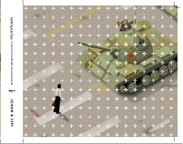
Art in the Age of Videogames
GAMESCENES: THE BOOK
M. Bittanti, D. Quaranta (editors), GameScenes. Art in the Age of Videogames, Milan, Johan & Levi 2006. Hardcover, 454 pages, 25 x 25 cm, 200+ hi-res illustrations, available from October 2006.
GameScenes. Art in the Age of Videogames is the first volume entirely dedicated to Game Art. Edited by Matteo Bittanti and Domenico Quaranta, GameScenes provides a detailed overview of the emerging field of Game Art, examining the complex interaction and intersection of art and videogames.
Video and computer game technologies have opened up new possibilities for artistic creation, distribution, and appreciation. In addition to projects that might conventionally be described as Internet Art, Digital Art or New Media Art, there is now a wide spectrum of work by practitioners that crosses the boundaries between various disciplines and practices. The common denominator is that all these practitioners use digital games as their tools or source of inspiration to make art. They are called Game Artists.
GameScenes explores the rapidly expanding world of Game Art in the works of over 30 international artists. Included are several milestones in this field, as well as some lesser known works. In addition to the editors' critical texts, the book contains contributions from a variety of international scholars that illustrate, explain, and contextualize the various artifacts.
ARTISTS: AES+F, Cory Arcangel, Aram Bartholl, Dave Beck, Tobias Bernstrup, Nick Bertke, John Paul Bichard, Marco Cadioli, Mauro Ceolin, Brody Condon, Joseph DeLappe, Delire (Julian Oliver), Todd Deutsch, Micah Ganske, Beate Geissler − Oliver Sann, Brent Gustafson, Jon Haddock, Margarete Jahrmann − Max Moswitzer, JODI, Joan Leandre, Miltos Manetas, Alison Mealey, Mark McCarthy, Shusha Niederberger, Nullpointer (Tom Betts), Nullsleep (Jeremiah Johnson), Totto Renna, RSG (feat. Alexander Galloway), Anne-Marie Schleiner, Eddo Stern, Palle Torsson, UBERMORGEN.COM.
AUTHORS: Matteo Bittanti, Rebecca Cannon, Pierluigi Casolari, Maia Engeli, Henry Lowood, Sally O'Reilly, Domenico Quaranta, Philippa Stalker, Valentina Tanni.
GAMESCAPES: THE SHOW
GameScapes. Videogame Landscapes and Cities in the Works of Five International Artists
curated by Rosanna Pavoni
Monza Civic Gallery
Monza, via Camperio 1
October 13 – 29, 2006. Free Entrance
From Tuesday to Sunday, 10.00 – 13.00 and 15.00 – 19.00.
Opening: Thursday October 12 from 6:30 PM
email: salecomunali@comune.monza.mi.it
The release of GameScenes coincides with the launch of GameScapes. Videogame Landscapes and Cities in the Works of Five International Artists, a group show featuring works by some of the most celebrated artists working with digital games: Cory Arcangel, Mauro Ceolin, Jon Haddock, Eddo Stern, and Carlo Zanni.
Monza, September 16, 2006 — The Civic Gallery in Monza is pleased to present GameScapes. Videogame Landscapes and Cities in the Works of Five International Artists. Curated by Rosanna Pavoni with the collaboration of Matteo Bittanti and Domenico Quaranta, GameScapes investigates the notion of digital games, spaces, and urban environments in in our hyper-mediated age. Comprised of paintings, installations, and projections, the exhibition space will be transformed into a real-life gamespace.
Included in the exhibition are a video installation by Cory Arcangel, Super Mario Movie (2004), a series of paintings by Mauro Ceolin from the SolidLandscapes (2004-2006) series, Carlo Zanni’s interactive installation Average Shoeveler (2004), Eddo Stern’s recent urban machinima Landlord Vigilante (2006) and the entire series of Jon Haddock’s seminal Screenshots (1999). Most of these artworks have never been presented in Italy before.
Johan & Levi is publishing the GameScapes catalog which features new commentary texts by Rosanna Pavoni, Matteo Bittanti, and Domenico Quaranta.
More information:
Gamescenes.org
Videoludica.game culture
Posted by luis at 10:07 AM | Comments (0)
Interconnect @ between attention and immersion
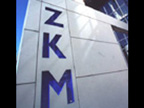
Media Art from Brazil
ZKM | Media Museum invites the public to a large-scale survey of contemporary Brazilian media art, with selected works from this year's Sérgio Motta Prize competition.
New spaces of experience. With an eye schooled in the artistic trends of Europe and North America, the new generation of Brazilian artists treads various paths. The broad spectrum of their media art ranges from the digital manipulation of structures and textures, through the creative-playful appropriation of new technical possibilities, to the radical criticism of media and society. In the selected works, experiences from everyday life, personal and public spaces merge into a far-reaching reflection on the meaning and status of self-images in society. At the focus of this coming to grips with the new media of film and television, video, computer and their interlocking, is not the most virtuoso possible application of new technologies, but rather the now considered, now nervous, driven and never-ceasing search for identity and determination of position which rapid social change constantly demands of the individual. This is all the more urgent as new interface technologies and immersive installations are constantly expanding the spaces of our experience.
Media art in Brazil. The »Prêmio Sérgio Motta de Arte et Technologia« was first awarded in 2000. Its goal is to foster artistic and theoretical work in the area of the arts and new media in Brazil. Today the prize is one of the most important initiatives outside the academic context for the promotion of contemporary culture in combination with the new dimensions of Brazilian digital culture. Conceived as a response to the waxing acceleration of the dialogue between the arts and sciences, it has been adjusted every year to current development and formats. Today it fosters works in the categories of the fine arts, music, literature, dance, performance, interactive art and the interdisciplinary theoretical discussion of these.
The exhibition shows works by Lucas Bambozzi, Giselle Beiguelman, Caetano Dias, Luiz Duva, Raquel Kogan, Daniela Kutschat & Rejane Cantoni, Kátia Maciel, Gisela Motta & Leandro Lima, Alice Miceli, Simone Michellin, André Parente, Grupo Poéticas Digitais.
Curators: Vitoria Daniela Bousso, Peter Weibel
Project director: Bernhard Serexhe.
Further information: http://www.premiosergiomotta.org.br
The exhibition is supported by the cultural programme of the Brazilian Ministry of Culture.
Posted by luis at 09:49 AM | Comments (0)
Imagined Landscapes Symposium

New media landscaping
Imagined Landscapes is a two day symposium (26-27 October) presented by Cumbria Institute of the Arts’ Centre for Landscape and Environmental Arts Research (CLEAR) in association with the Brera Academy, Milan. The symposium considers the work of leading international practitioners working between and across art forms and with new media technologies to create and explore imagined landscapes.
Aims:
The broad aim of the symposium is to examine the ways in which the artists
explore the notion of the imaginary through their work and to critically reflect on how such works can help us to understand our relationship with landscape and the environment, opening up a site for critical exchange and creating opportunities for future practical exploration and theoretical engagement.
Programme:
Thursday 26th October
1.15 – 1.45 Registration
1.45 – 2.00 Welcome from Charles Mitchell, Vice Principal (academic),
Cumbria Institute
2.00 – 2.15 Introduction from Antonio Cioffi, Brera Academy, Milan
2.15 – 3.00 Key Note: Charlotte Davies, visual artist, Canada/ San
Francisco
3.00 – 3.45 Anouk de Clercq, video artist, Brussels
3.45 – 4.45 Discussion with Charlotte Davies, Anouk de Clercq and David
Uzzell, Environmental psychologist, University of Bath
4.45 – 5.15 Break
5.15 – 6.00 Julian Oliver, free software developer, lecturer and media-
theorist, Berlin
6.00 – 6.45 Jorn Ebner, visual artist, Newcastle upon Tyne
6.45 – 7.45 Discussion with Julian Oliver, Jorn Ebner and Ian Thompson,
lecturer, Landscape Architecture, University of Newcastle upon Tyne
7.45 – 8.45 Buffet and launch of Imagined Landscapes website
8.45 - Drinks, viewing of Summerbranch by Igloo and the work of
symposium delegates
Friday 27th October
9.45 – 10.00 Introduction to the day from Antonio Cioffi
10.00 – 10.30 Studio Azzuro, artist collective, Milan
10.30 – 11.15 Igloo, artist collective, London
11.15 – 12.00 Jen Southern, new media artist, Huddersfield
12.00 – 12.30 Break
12.30 – 13.30 Discussion with Studio Azzuro, Igloo, Jen Southern and John
Urry, Professor of Sociology, Lancaster University
13.30 – 14.00 Lunch
14.00 – 14.45 Johannes Birringer, Choreographer and media artist
14.45 – 15.30 Trevor Wishart, Composer, Durham
15.30 – 16.15 Discussion with Johannes Birringer, Trevor Wishart, Carl
Lavery: Lecturer, Theatre Studies, Lancaster University and Larry Sider:
Director, School of Sound/ Lecturer, National Film and Television School.
16.15 – 16.45 Closing Comments
Intended audience
The symposium will be of interest to artists, designers, new media art
critics, curators and those interested in the sociology and philosophy of
landscape.
Price:
Places are available for £75 full price and £45 for concessions and
include all presentations, discussions, meals and daytime refreshments.
Promoting Work
We recognise the important networking opportunity offered by the event and
are therefore happy to showcase digital works by delegates on the theme of
imagined landscapes, where possible. Delegates interested in having their
work available at the symposium should contact the event organiser.
Further information on contributors, event location and how to book can be
found on the Centre for Landscape and Environmental Arts Research website:
www.clear.cumbria.ac.uk
For all enquiries, please contact Charlotte Stuart, Research Assistant,
Cumbria Institute of the Arts, Brampton Road, Carlisle, CA3 9AY,
charlotte.stuart@btinternet.com, 01228 400318/ 07985 193 219
Posted by luis at 09:36 AM | Comments (0)
Live Media Art

First Play Berlin
TRAMPOLINE presents: FIRST PLAY BERLIN – a programme of live media art.
1. Day Of The Figurines NOW LIVE! – read Game Rumours for the gossip
2. FIRST PLAY BERLIN – launched Thursday 12th Oct.
FIRST PLAY BERLIN is funded by the German Federal Cultural Foundation,
British Council, Hebbel am Ufer and Radiator Festival for New Technology
Art. For more information about FIRST PLAY BERLIN and Trampoline – the
international platform for new media art - go to www.trampoline-berlin.de.
1. Day Of The Figurines – Blast Theory
Since September 28th, the population of the fictional town represented in Day Of The Figurines has been growing. Inundated by an increasing number of game characters, the laser cut steel city at the heart of Hau 2 provides the stamping ground for an equal number of miniature figurines, each one representing a player enjoying the game. If you aren’t a player yet and live in Berlin, come and join in the experience every day from 16h – 20h at HAU2.
Day Of The Figurines: Game Rumours
9.02 am at the RATResearch institute. HASSAN, who has a muscular chest, is frustrated from trying to throw his SICK DOGS over the gates. The brawny liberator has a clutch of the animals with him after creeping out of the institute with the sound of alarm bells in his ears. Now, stuck inside the perimeter fence, HASSAN meets SUPERGIRL, who kick starts a little fun by hitting him with her BRANCH.
JOHN, on the other side of the gates, says nothing.
Meanwhile in KATH's Cafe, rumours have started that HASSAN was in bed with SHINGLES, thus blowing his chances of success at the RATResearch institute. However, dreamy MARGHERITA, still angling for a way to run away with HASSAN, pointed out that SHINGLES left town the day before.
By 9.35am FRÄULEIN AGATHE, a stewardess cool as ice, is standing outside the institute gates. She has followed HASSAN from the PRODuct Barn. HASSAN apologizes for not being able to give her a bunk up, explaining that he can't quite get the hang of his STEPLADDER. JOE AND BILLY appear and offer some advice on the use of tools and they all head off to KATH's for some TEA. They are feeling poorly.
Back at KATH's Cafe, MARGHERITA is trying to get HASSAN's attention by feigning illness. BARNEY enters wearing a colourful WRISTBAND. "That's a lovely wristband Barney. Where did you get it from?" hopes HASSAN and dwells on the subject until BARNEY, an eight year old boy, DROPs it. Seeing her chance, MARGHERITA suggests to HASSAN that they go get themselves a SAUNA but it's shut until 2.00pm, as BARNEY found out. It's still only 10.40am. HASSAN, MARGHERITA and BARNEY all leave to the INTErnet Cafe together.
CINDY looks on across the steamy cafe but says nothing.
Day Of The Figurines is the world’s first MUD (Multi User Domain) for mobile phones and was developed as part of the European research project IPerG (Integrated Project on Pervasive Gaming) and in collaboration with Mixed Reality Lab, University of Nottingham. Following FIRST PLAY BERLIN, Day Of The Figurines will visit the National Museum of Singapore in December 2006 and tour the UK in 2007.
For more information go to
www.dayofthefigurines.co.uk
www.blasttheory.co.uk
www.trampoline-berlin.de
2. FIRST PLAY BERLIN – big opening Thur 12th Oct with a TRAMPOLINE Event Be the first to experience FIRST PLAY BERLIN. A virtual tree. A handheld world evolving with every beat of your heart. Memories of a childhood home and an English garden brought to life by new technology. A CCTV city tour. FIRST PLAY BERLIN fuses the player and the game, the handheld and the
heartfelt, the cerebral and the technical – short-circuiting the limits of
play.
Blast Theory, Active Ingredient, Michelle Teran, Daniel Belasco Rogers, Simon Heijdens and Frank Abbott converge on Hebbel am Ufer for FIRST PLAY BERLIN. The result is a weekend of trend-setting, cutting-edge international live media art projects that combine technology, performance, interaction and installation.
The opening is taking place at Hebbel am Ufer, HAU2 on Thursday 12th October from 8pm in form of a TRAMPOLINE Event. For one night only, TRAMPOLINE showcases a unique blend of eclectic and emergent new technology art from around the world. With live performances, installations, screenings and presentations, the evening will culminate in a live concert of Heidi Mortenson.
It's a packed programme. Don’t miss it.
Posted by luis at 09:15 AM | Comments (0)
October 06, 2006
Autostart
![]()
A Festival of Digital Literature
Philadelphia, PA
AUTOSTART
:
. October 26 & 27 at Kelly Writers House
: Celebrating the Electronic Literature Collection, volume 1
: MACHINE series # Electronic Literature Organization
: http://writing.upenn.edu/wh/autostart.html
:
:=:#=:.#=::==.=....:...> Charles Bernstein
.#.=..=:#.=::===...:.:.> Jim Carpenter
::.=.==...::==:.=#:...#> Mary Flanagan
:#.:...:.:=#..=.=.=:==:> N. Katherine Hayles
:.=#:.===.:.:::.=..#..=> Daniel C. Howe
:=#:::=:.#:=.=.=....=..> Aya Karpinska
..:.==#==::#==:......:.> Aaron Levy
:#=.=..:..=.::=::#..==.> Marjorie Luesebrink
::=:=:...:=..#.==#.=.:.> Nick Montfort
.....:==::.=.#:.=.==#.:> Stuart Moulthrop
:=...=#:...:::=#===..:.> Jason Nelson
:#..=.==..:=.=..:#.=:::> Jena Osman
:..=.=.=.=#:=:#.:...=::> Bob Perelman
:....:.:.===#=.:=:#=..:> Scott Rettberg
.==:.=...:..#.::=:.=.=#> Ron Silliman
.=...:=#.=:..=:..#.==::> Brian Kim Stefans
:#.::...=:.:.==.==:..#=> Stephanie Strickland
...=..=#=::=.=..:.:=:.#> Noah Wardrip-Fruin
All events except the tour of Slought take place at the
: Kelly Writers House, 3805 Locust Walk, University of Pennsylvania,
. Philadelphia, PA
: THURSDAY Oct 26
:
: 1:00-2:30 pm Discussion (Arts Cafe)
. A conversation about writing and literature in the digital
. age, featuring four prominent poets:
: > Charles Bernstein - University of Pennsylvania
: > Jena Osman - Temple University
: > Bob Perelman - University of Pennsylvania
: > Ron Silliman - Silliman’s Blog
:
: 2:30-5:30 pm The Open Machine Open House
: Electronic literature available for reading and discussion
: throughout the downstairs area, with guided tours at
. 3:30 pm & 4:30 pm by two Electronic Literature Collection,
: volume 1 editors:
: > Stephanie Strickland - New York City
: > Nick Montfort - University of Pennsylvania
:
: 4:00-5:30 pm Wet Digits Workshop
: An introductory workshop for those new to HTML and digital
: writing, led by the editors of The New Media Reader:
. > Noah Wardrip-Fruin - University of California, San Diego
: > Nick Montfort - University of Pennsylvania
: [[[ RSVP REQUIRED: contact wh@writing.upenn.edu ]]]
:
: 5:30-7:30 pm Reading (Arts Cafe)
: Presentations of electronic literature by Electronic
: Literature Collection, volume 1 contributors:
: > Mary Flanagan - Hunter College
: > Aya Karpinska - Brown University
: > Stuart Moulthrop - University of Baltimore
. > Noah Wardrip-Fruin - University of California, San Diego
.
: FRIDAY Oct 27
:
: 10:30-11:30 am Tour of Slought Foundation (4017 Walnut St)
. Slought Foundation broadly encourages new futures for
: contemporary life through public programs featuring
: international artists and theorists.
: > Aaron Levy - Slought Foundation Executive Director
:
. 1:00-4:00 pm Electronic Writing Jam (Room 202)
: A time to write collaboratively and to discuss forms,
: techniques, and technologies, hosted by:
: > Jim Carpenter - University of Pennsylvania
: Participants include readers and editors from AUTOSTART’s
: Thursday program as well as:
: > Daniel C. Howe - Brown University
: > Brian Kim Stefans - Richard Stockton College of New Jersey
: Participants by videoconference include two editors of
: the Electronic Literature Collection, volume 1:
. > N. Katherine Hayles - University of California, Los Angeles
: > Scott Rettberg - University of Bergen, Norway
: An editor of volume 2 and volume 1 contributor:
: > Marjorie Luesebrink - Irvine Valley College
: And volume 1 contributor:
. > Jason Nelson - Griffith University, Australia
: [[[ RSVP REQUIRED: contact wh@writing.upenn.edu ]]]
:
:::::::.:::::.::::…::::::::.:::::.::::.:::::::.:::::::.:.::::::::::::
:
: The Electronic Literature Collection, volume 1 is edited by
: N. Katherine Hayes # Nick Montfort
: Scott Rettberg # Stephanie Strickland
: This volume features 60 digital selections by
: Jim Andrews # Ingrid Ankerson # babel # Giselle Beiguelman
: Philippe Bootz # Patrick-Henri Burgaud # J.R. Carpenter
: John Cayley # M.D. Coverley (Marjorie Luesebrink) # Martha Deed
. David Durand # escha # Damien Everett # Sharif Ezzat
: Edward Falco # Mary Flanagan # Marcel Fr’emiot
: Elaine Froehlich # geniwate # Loss Peque~no Glazier
: Kenneth Goldmith # Tim Guthrie # Richard Holeton
: Daniel C. Howe # Jon Ingold # Shelley Jackson # Michael Joyce
: Aya Karpinska # Robert Kendall # Deena Larsen
: Kerry Lawrynovicz # Donna Leishman # Bill Marsh # Talan Memmott
: Maria Mencia # Judd Morrissey # Brion Moss # Stuart Moulthrop
. Jason Nelson # Marko Niemi # Millie Niss # Lance Olsen
: Jason Pimble # William Poundstone # Kate Pullinger
: Melinda Rackham # Aaron A. Reed # Shawn Rider # Jim Rosenberg
: Megan Sapnar # Dan Shiovitz # Emily Short # Alan Sondheim
: Brian Kim Stefans # Reiner Strasser # Dan Waber
: Noah Wardrip-Fruin # Rob Wittig # Nanette Wylde
: The Collection will be available on the web and on CD-ROM under a
: Creative Commons license - see http://eliterature.org
:
:.=.=##.##=:.#.##:#=.##:.#.:..=.::.##.:=:.=#=:.#…..#=#.:.#…:##….=:
Posted by newradio at 05:19 PM | Comments (0)
October 05, 2006
it was a PICNIC '06

PICNIC '06 cross media week was last week, september 27-29, in Westergasfabriek, Amsterdam. It showcased gaming and music content delivered via TV, Internet, mobile phones, virtual reality. Conference sessions explored online and mobile games, interactive TV show formats, multi-format brands, and consumer-generated content. See video stream.
Posted by michelle at 08:59 PM | Comments (0)
Greenwich Emotion Map
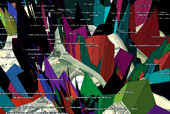
Bio Mapping
Developed by Artist Christian Nold, the BioMapping project is set up as a series of participatory workshops that invite people to borrow a Bio Mapping device and go for a walk. The device measures the wearer's Galvanic Skin Response (GSR), which is an indicator of emotional arousal in conjunction with their geographical location. The resulting maps encourage personal reflection on the complex relationship between us, our environment and our fellow citizens. By sharing this information we can construct maps that visualise where we as a community feel stressed and excited.
Posted by michelle at 08:31 PM | Comments (0)
New Media Poetics
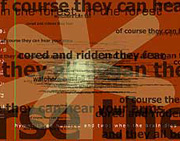
Leonardo Electronic Almanac
The category "New Media Poetry and Poetics" includes multimedia digital works (image/text/sound) as examined through the lens of "writing," specifically any of those concerns central to poetry rather than narrative or prose:
1. reader as active participant in the "ergodic" sense,
2. the use of stochastic methods and chance procedures,
3. the complex relations between the author, reader, and computer-as-writer/reader which evolve from that interaction,
4. modes of work that foreground the digital medium (such as "codework")
5. emphasis on "poetics" of new media writing, where aesthetics intersect with politics to create dynamic attempts at social change.
Posted by michelle at 07:36 PM | Comments (0)
telly-stylee
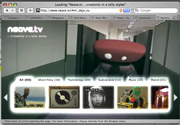
neave.tv
Artist Robert Neave presents neave.tv which pulls full screen, crisp video from blip.tv, google video and YouTube. You can view a random play or select from thematic interface.
Posted by michelle at 07:29 PM | Comments (0)
Media for Invisible Cities

cargo media space, belgium
Forum, online mixilogy - open project Invisible Cities.
Self Published, Weak Media traces and marks of a search for new ways of using media. Here we keep asking the question how we can make the most recent media work for us. How can we benefit from them in terms of our own development? Which capacities do we need for that? At what cost and at what expense? And what do we get in return? Can media account for applications outside their own field? Within the given technological and overtly company-dependent infrastructure, is there any possibility of criticism, experiment or creation? Or does the digital domain confiscate everything within its reach? Do media indeed bring us closer to a clearer understanding of everyday life or do they offer us a horizon by catching us in a web of age-old, endless desires?"
Posted by michelle at 06:27 PM | Comments (0)
at Empyre list in October
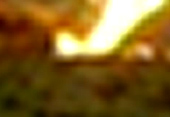
Amateur, Craft & DIY
This month on -empyre- the focus will be on a dialogue between Ryan Griffis and De Geuzen, that will provide an opportunity to explore themes underlying their participation in the Chicago chapter of Under Fire project based on Jordan Crandall's work . Also by Griffis, you and new genics and temporary travel office serving to identify sub rational connections between mobility and technology.
Posted by michelle at 05:53 PM | Comments (0)
Global Anxiety Monitor
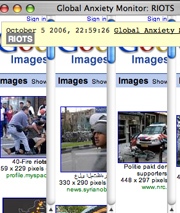
a foundation for multi-visual research
Global Anxiety Monitor and "Historiographic Tracer" represent an instance of research (in the general sense of collecting/analyzing data) and symbolic framing. They are "tactical media" by assuming the role of a "tool" for engaging/ studying a given situation as well as consciously politicizing the data and its means of collection (the tool itself).
These projects and much, if not all, of deGeuzen's work also builds on the practices and theories of people like Martha Rosler and Alan Sekula who practice a "critical documentary" in which the potential for affect provided by photography is neither abandoned nor surrendered to, but engaged to find instances where desires to change reality can be made politically reflexive. viaiDC list
Posted by michelle at 05:04 PM | Comments (0)
DorkbotSF

doing strange things with electricity
DorkbotSF meets next week at the BOCA Bar or Bar of Contemporary Art at 7:30pm Wednesday, 11 October 2006, 414 Jessie Street (off 5th @ Mission), San Francisco, CA.
Speakers:
Tim Hunkin - Reinventing the Amusement Space
Mike Kuniavsky - The Coming Age of Magic
Posted by michelle at 04:39 PM | Comments (0)
Nanotechnology
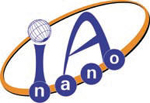
International Congress 2006
San Francisco, CA
This premier international nanotechnology event will be held on October 30-November 2, 2006 in San Francisco at the San Francisco Atrport Marriott Hotel
More than 150 speakers and presenters from 35 countries will cover a complete spectrum of the emerging field of Nanotechnology: from the latest research and development in nanomaterials, nanoelectronics, nanophotonics, nanobiotechnology, nanomedicine, nanoethics, workforce education and training, environmental, societal and health and safety implications, to nanotech venture capital investment.
Early-bird registration will end on October 7, 2006. Please register now and save: http://www.nanotechcongress.com/registration.htm
Please visit our web site: http://www.icnt.org
Highlight of some distinguished speakers:
Dr. Juan Antonio Carballo
Venture Capital Partner
IBM
Menlo Park, CA 94025 USA
Prof. Bernard Cathala
Directeur de recherche
INRA, Nantes, BP 71627 F-44316, FRANCE
David J. Dykeman, Esq.
Greenberg Traurig LLP
One International Place, Boston, MA 02110, USA
Prof. Lieve Goorden
Katholieke Universiteit Leuven
Centrum voor Wetenschap, Techniek en Ethiek
Heverlee, BELGIUM
Dr. E.I.Givargizov
Institute of Crystallography RAS, Moscow, RUSSIA
Dr. Robert Irving
Scientific Director
Nanotechnology Victoria Ltd
Clayton, VIC 3800, AUSTRALIA
Prof. Sungho Jeong
Department of Mechatronics, Gwangju Institute of Science and Technology (GIST),
Oryong-dong, Buk-gu, Gwangju 500-712, KOREA
Prof. David Jishiashvili,
Georgian Technical University
Republican Center for Structure Researches
Tbilisi, GEORGIA
Dr. Amit Kumar
President and CEO
Combimatrix, Inc.
Mukilteo, WA 98275 USA
Dr. Lenka Martinova
Technical University of Liberec, Faculty of Textile Engineering, Department of Nonwovens,
CZECH REPUBLIC
Prof. Michel Meunier,
Laser Processing Laboratory, Department of Engineering Physics, Ecole Polytechnique de Montréal, Case Postale 6079, succ. Centre-ville, Montréal (Québec), CANADA, H3C 3A7
Dr. Falk Mikosch
Head of Department
Project Management Agency Forschungszentrum Karlsruhe
Production and Manufacturing Technologies Division
Forschungszentrum Karlsruhe GmbH
Leopoldshafen, GERMANY
Dr. Hideyuki Nakano,
Toyota Central R&D Labs., Inc.
Nagakute, Aichi, 480-1192, JAPAN
Dr. N. Pradeep
National Institute of Standards and Technology, Gaithersburg, MD 20899 USA
Prof. N. M. Butt,
Pakistan Science Foundation & National Commission on Nano-Science and Technology(NCNST) Islamabad, PAKISTAN
Dr. K. Ramakrishnan
Nanomix,Inc.
Emeryville, CA 94608 USA
Dr. Michael Schen
Director, Information Technology and Electronics Office
NIST Advanced Technology Program
Gaithersburg, MD 20878 USA
Dr. P. Tavolaro
ITM/CNR
Dept. Chemical Eng. Mater.
Rende, ITALY 87030
Dr. Justin G. Teeguarden
Pacific Northwest National Laboratory
Richland, WA 99352, USA
Prof. L. Znamirowski
Polish Academy of Science, Institute of Theoretical and Applied Informatics
Gliwice, POLAND
and more than 100 speakers from around the world. Abstract can be submitted online: http://www.nanotechcongress.com/abstract-online.htm
Speaking opportunity: http://www.ianano.org/speaking.htm
Registration online: http://www.nanotechcongress.com/registration.htm
Abstract Submission
deadline for poster presentation deadline has been extended to October 7, 2006
Early bird registration will end on October 7.
Register now and save
TOPIC
Nanomaterials
Nanodevices
Nanoelectronics
Nanobiotechnology
Nanomedicine
Commercialization
Nano-Delivery Systems
Nomenclature
Standards
Nano Tools
Molecular Engineering
Nano Manufacturing
Nanotoxicology
Societal
Environmental Impacts
Heath & Safety
Intellectual Property
Technology Transfer
Workforce Training
Nanotech Initiatives
Capital Funding
Investment
International Association of Nanotechnology
2386 Fair Oaks Blvd, Sacramento, CA 95825 USA
Email: info@ianano.org Web site: http://www.ianano.org
Posted by newradio at 01:46 PM | Comments (0)
Christian Kerrigan

Growing a Hidden Architecture
CFhristian Kerrigan's project, Growing a Ship in a Yew Forest "explores the possibilities of a symbiotic relationship between two different systems of organization, technology and nature… to theoretically alter newly planted trees in the last remaining Yew forest."(Kingley Vale)
Architect & Editor of 'The Space Between'magazine, Christian Kerrigan investigates in his recent work, how man’s ability to control his surroundings is intimately linked with his advancing capabilities of using technology. Christian says "We have reached a point in our evolution where we are now capable of creating design criteria to manipulate natural growth and development."
By controlling the manipulation of refined armatures, calibrating devices and designed corsets; the system is capable of controlling the growth of a ship inside the forest. The ship will grow over a period of two hundred years and will exist as a hidden architecture inside the trees.
Posted by newradio at 10:06 AM | Comments (0)
Fred Guttfield
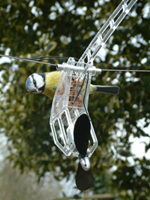
The Bird Table
Fred Guttfield ´s work explores the contested territory between technology and nature. He designs 'Natural Amplifiers' which highlight the necessity and beauty found in nature and natural behaviours. The Bird Table is his latest project. Fred explains: “The current garden bird feeder is a typical example of design in spite of nature. The bird feeder exhibits few natural characteristics but as a result of regular interaction with local birds begins to condition the birds to Pavlovian levels.' Using a combination of observation and parametric design methods the 'Bird Table' went through a number of iterations to behave not just in response to the birds that interacted with it but also to human and wider environmental factors. In this way the table has developed its own behaviours, moods and rhythms in tandem with the ecology in which it is sited.”
Posted by newradio at 09:55 AM | Comments (0)
October 04, 2006
PIXILERATIONS [v.3]
![]()
Exhibition Providence, RI
191 Westminster St.
http://firstworksprov.org/
PIXILERATIONS [v.3] is a digital arts showcase taking place within the FirstWorksProv Festival. It features works in digital media and interactive performance.
Pixilerations [v.3] will be open Thursdays, Fridays, and Saturdays through October 14. The exhibition is open: Thursdays 11-1pm, Fridays 2-6 pm, Saturdays 2-6pm
Featuring:
INSTALLATIONS: Liz Phillips, Rachelle Beaudoin, Betsy Connors, Edrex Fontanilla & R. Goldschmidt, Daniel Howe, Bokyung Jun, Naomi Kaly, Brian Knoth, Alex Kotch, Lisa Lee, Carmen Montoya, Magaly Ponce, Christopher Robbins, Hans Spinnerman, Jon Shumway.
SINGLE CHANNEL VIDEOS: Maria Dyer & Louise Despont, Lucky Leone, Joe Milutis, Ben Russell & Sabine Gruffat, Brian Kim Stefans.
CONCERTS: Damon Baker, Robert Griffin Byron, Lyn Goehringer, GRAY CODE, Brian Knoth, Peter McCulloch, mem1, Jim Moses, Kevin Patton, Greg Souza, Arvid Tomayko-Peters, Alice Vogler & Maxwell Dulaney, Matthew Warne & Jamie Jewett, Chapman Welch, MEME Ensemble, cyberbillies.
Closing Performances: Friday October 13 at 10:00pm
Posted by newradio at 01:36 PM | Comments (0)
The Dirk Pereres Archive
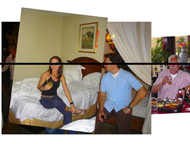
Online file gathering
Downloading and sharing music, films, software and other data is usually done by means of peer-to-peer (p2p) networks. p2p software like Limewire and Acquisition offer the possibility to share specified documents on computers with other users, who have access to the data through an Internet connection.
Many users do not use the right settings in these exchange programmes, causing far more data to be accessible than originally planned. In this way, a lot of ‘sensitive’ information is being unconsciously offered.
Dirk Pereres spent a year gathering keywords, application letters, bank information, scanned passports, photo and video material, and so on. This resulted in the so-called Dirk Pereres Archive. The ‘found footage’-material was used to design amongst others posters and films.
Pereres states: “It’s an interesting collection that should be seen by everyone. Because: You’re telling Dirk! It was immediately clear to me that a high level of discretion was needed… Therefore, my design always strives to create or restore anonimity”.
The Dirk Pereres Archive will be presented at <>TAG The Hague from October 7th till October 28th. Check out: http://www.tag004.nl for more information about the presentation of The Dirk Pereres Project and http://www.dirkpereres.org for details on the project.
Posted by luis at 12:56 PM | Comments (0)
An ordinary building
![]()
UNUSUAL SIGN APPEARED OVERNIGHT CAUSES CONTROVERSY
On the night of September the 20th 2006 a sign appeared on a building in the center of Viterbo, an ancient city in central Italy, not far from Rome. Apparently put by the City Council it has already caused quite a stir. The sign is in fact an art piece by controversial artist duo Eva and Franco Mattes (aka 0100101110101101.ORG). Looking as official as any other street sign, it reads:
An Ordinary Building: This building was designed by an unknown architect in an irrelevant epoch and never belonged to an important person. The complex does not show any original architectural solutions, nor does it conserve any important works of art within. No memory is kept of any significant historical events occurring on this site. No known personality was born, lived or died here, nor is any excellent artist or sublime poet still working here.
Hundreds of unaware passersby have been staring at the sign: "It's brilliant!" comments an elderly woman "But I have no idea how to interpret it". While an outraged citizen living nearby comments "This is just unacceptable, look around, there are buildings much worse than this one, especially in the suburbs".
When asked to give an explanation of the sign, Franco Mattes, currently in New York, declared "It means what it says".
Italian curator Claudio Zecchi, who commissioned the work, comments: "This piece has a strong provocative nature like all their previous ones. The ideal stage for their art is not the official places where artworks get recognition and celebration like galleries and museums, but the city itself. It is only there that they can obtain the most genuine reaction".
The artists plan to leave the sign on the building until mid October, but whether or not the City Council and citizens will allow this, is an open question.
"History is not given" adds Eva Mattes "it has to be constructed, it's pure fiction, like in a novel".
The Mattes are not new to this kind of interventions. Over the last decade they drawn worldwide acclaim - and contempt - for producing some of the most paradoxical artworks ever, including staging a hoax involving a completely made-up artist, challenging and defeating Nike Corporation in a legal battle for a fake advertisement campaign and inventing ‘United We Stand', a non-existent Hollywood-style blockbuster.
Info and contacts:
http://www.0100101110101101.org
Downloadable images:
http://www.0100101110101101.ORG/download/ordinary.html
Posted by luis at 12:35 PM | Comments (0)
Upgrade! Seattle in October

Rebecca Cummins
Come join us for the October Upgrade! Seattle meeting featuring Rebecca Cummins on Thursday October 12 at 7pm at 911 Media Arts Center.
Upgrade! Seattle is a once a month magnet group for new media artists working in the Seattle area that aims to gather, promote, critically discuss, and present Seattle new media work hosted by the 911 artists2artists group at 911 Media Arts Center. If you are interested in presenting your work, please contact Carrie Bodle (cbodle@alum.mit.edu).
Rebecca Cummins explores the sculptural, experiential and sometimes humorous possibilities of light and natural phenomena, often referencing the history of optics. She frequently incorporates obsolete technologies such as camera obscuras, phantasmagoria and periscopes, often in combination with newer media, such as video, computers, photography and digital imaging.
Installations have incorporated a rainbow machine, camera obscura / fibre-optic journey through the center of the earth, paranoid dinner-table devices ('Liquid Scrutiny' referenced a 17th century Czech camera obscura goblet), an interactive computer/video rifle ('To Fall Standing' updated French physiologist E.J.Marey’s photographic rifle of 1882), portable camera obscuras and a periscope birdbath.
Recent photographic and sculptural projects record the movement of shadows (in daylight and moonlight) over regular intervals of time, including large scale sundials (“Aperture Skylight Sundial” opened recently at the new Montlake Public Library).
She received her doctorate at the University of Technology, Sydney, Australia, in 2003 and is an associate professor at the University of Washington.
Recent exhibitions include the Shanghai Biennale, China; Toronto Images Festival, Canada; Alan Klotz Gallery, New York City; KIASMA Museum of Contemporary Art, Helsinki, Finland; the South Australia Biennale of Australian Art, Adelaide; Performance Space, Sydney; I Space, Chicago; and the Exploratorium, San Francisco.
Posted by luis at 12:23 PM | Comments (0)
E-poetry 2007
![]()
Call for articles and projects
Every two years, the E-Poetry series of Digital Poetry Festivals constitutes the most important digital literary gathering in the field. Authors and researchers worldwide meet and present their ideas and works. E-Poetry plays an essential role in the emergence of this new literary field, and provides a forum for the circulation of the ideas and the debates that animate it.
The festival has two facets: a university symposium and numerous artistic presentations. The symposium will take place at the Université Paris VIII. It will permit researchers to present their latest research and for artists to premier their newest works. Symposium papers will be published by Hermès Science Publications.
Artistic events will take place at key Parisian venues, providing notable authors the opportunity to present their works to a public curious about new literary and artistic trends employing technology and communication.
You are invited to submit a publishable article for the symposium. Maximum length should be 12 pages (Times New Roman 12). The article can be academic or can present an artistic work. Accepted languages are French and English. Criteria will be posted on Monday, October 2, 2006.
Articles must arrive in Word format via email to philippe.bootz@univ-paris8.fr in their final form by December 10, 2006, at the latest. Works must arrive at the latest April 15, 2006..
Details about criteria for artistic works will be posted on Monday, October 2, 2006. Interactive and/or generative works employing at least some programming are preferred. Works can be in art forms other than computer media, as long as they satisfy the criteria given below.
E-poetry 2007 is organized by:
The Electronic Poetry Center (EPC - SUNY Buffalo)
Le Laboratoire Paragraphe (Université de Paris VIII )
Mots-Voir
Opening Sunday, May 20. 2007.
Symposium and evening events: from Monday, May 21 to Wednesday, May 23, 2007.
The symposium will take place at the Université de Paris VIII (Saint-Denis), artistic works at le Cube and at Point Ephémère.
Organizers: Loss Pequeño Glazier, Philippe Bootz, Patrick-Henri Burgaud, Jean Clément, Alexandre Gherban
Information regarding the Symposium
philippe.bootz@univ-paris8.fr
Information regarding Works
pburgaud@laposte.net
Posted by luis at 12:06 PM | Comments (0)
Body, Space & Technology Journal

Call for Submissions
Editor Sue Broadhurst at Body, Space & Technology Journal is calling for submissions for a November 01, 2006 deadline.
Posted by michelle at 10:50 AM | Comments (0)
Pervasive 2007

Call for Participation
Pervasive 2007
The Fifth International Conference
on Pervasive Computing
Toronto, Ontario, Canada
May 13-15, 2007
http://pervasive07.org/
Call for Participation
Call for Papers & Workshop Proposals
Pervasive 2007, the Fifth International Conference on Pervasive Computing, will be held May 13-16, 2007 in Toronto, Ontario, Canada. The annual conference provides a premier forum in which to present research results in all areas related to the design, implementation, application and evaluation of pervasive computing as it integrates into our lives. Building on the success of previous conferences in this series held in Zurich (August 2002), in Linz/Vienna (April 2004), in Munich (May 2005) and in Dublin (May 2006), Pervasive 2007 will include a highly selective single-track program for technical papers, accompanied by posters, videos, demonstrations, workshops, a doctoral colloquium, invited tutorials, and an invited plenary speaker.
Papers due October 13th
For more info: http://www.dgp.toronto.edu/conferences/pervasive2007/index.phtml
Posted by newradio at 10:38 AM | Comments (0)
It's Magic
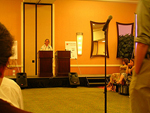
Ubicomp 2006
Bruce Sterling and Brenda Laurel gave the opening and closing keynote speeches at Ubicomp 2006. It made for an interesting comparison as they both spoke about magic but took absolutely opposite positions. Bruce Sterling claimed that magic does not exist, that believing in magic (by which I understood him to mean superstition, religion and animism) might make us feel better but does nothing to help us understand and develop our culture and environment. On the other hand, Brenda Laurel embraced animism and encouraged wonderment at the world around us to inspire and inform design of technologies. For her, magic is natural magic, the patterns, forms and processes of nature that we barely understand yet which drive our world. She urged designers to design for pleasure and spoke of the fairies in her garden, the wind fairy who would whisper to her when there was wind on the way and the lavendar fairy who would tell the bee fairy when the lavendar was flowering. These technological fairies are, of course, examples of animism which Bruce Sterling disapproved of so strongly.
In 2005 I worked as a research assistant to Stephen Gage who was writing a paper exploring the relationship between interactive architecture and magic. He now uses these principles in his teaching at the Bartlett. In the course of this he drew out three different types of magic, superstitious magic, natural magic and stage managed magic or the suspension of disbelief. This third form of magic is inherent in most designed, interactive experiences - including Brenda Laurel’s technological fairies. Most interactive systems create an illusion - commonly called an interface - which is presented to the people using or experiencing the object or situation. The role of this interface is to hide away the processes that are going on behind-the-scenes so that the participant is more easily able to fulfil their role in the playing out of the experience. This paper by Bruce Tognazzini has a good description of this.
You could say that in creating this illusion designers are trying to fool the participants, to dumb-down and simplify the technology, to put it in a black box and cover it with a smiley face (or a skull and crossbones, the emotion is irrelevent. I am talking about intention here) or, you can see the interface as being only the first step in a process of engagement with the technology. In this case the system should be open-ended enough for the participant’s engagement to deepen over time as the underlying technology and processes are exposed little bit by little bit.
The Processing language is a good example of this. It has an easy-to-use interface and simple commands that can be built into reasonably complex scripts making it very accessible to novice programmers. But it also lets programmers integrate Java code into their scripts alongside the Processing code. This means you do not have to move all at once to the complexities of Java programming, instead the process is driven by your programming skill and needs. Of course, the illusion of what is happening behind the scenes is never completely revealed but some insight into how it is constructed is there if you choose to look.
From:Mr. Watson In 2005 I worked as a research assistant to Stephen Gage who was writing a paper exploring the relationship between interactive architecture and magic. He now uses these principles in his teaching at the Bartlett. In the course of this he drew out three different types of magic, superstitious magic, natural magic and stage managed magic or the suspension of disbelief. This third form of magic is inherent in most designed, interactive experiences - including Brenda Laurel’s technological fairies. Most interactive systems create an illusion - commonly called an interface - which is presented to the people using or experiencing the object or situation. The role of this interface is to hide away the processes that are going on behind-the-scenes so that the participant is more easily able to fulfil their role in the playing out of the experience. This paper by Bruce Tognazzini has a good description of this.
You could say that in creating this illusion designers are trying to fool the participants, to dumb-down and simplify the technology, to put it in a black box and cover it with a smiley face (or a skull and crossbones, the emotion is irrelevent. I am talking about intention here) or, you can see the interface as being only the first step in a process of engagement with the technology. In this case the system should be open-ended enough for the participant’s engagement to deepen over time as the underlying technology and processes are exposed little bit by little bit.
The Processing language is a good example of this. It has an easy-to-use interface and simple commands that can be built into reasonably complex scripts making it very accessible to novice programmers. But it also lets programmers integrate Java code into their scripts alongside the Processing code. This means you do not have to move all at once to the complexities of Java programming, instead the process is driven by your programming skill and needs. Of course, the illusion of what is happening behind the scenes is never completely revealed but some insight into how it is constructed is there if you choose to look.
From: Mr. Watson, September 24, 2006. http://www.prusikloop.org/mrwatson/?m=200609n See also: http://www.prusikloop.org/mrwatson/?m=200609 for more on architecture and magic
Posted by newradio at 09:51 AM | Comments (0)
Sonic Moons

Nuit Blanche 2006 7 October, Paris
10 hours of live non stop performance in the Goutte d’Or, 7pm -5am, free.
Place: Wasteland at the corner of rue Ordener and rue Emile Duployé (Paris
18ème).
[DES MONTS DE LA LUNE / SONIC MOONS – A MU/Conteners coproduction] is an exploration of parallel sonic worlds inspired by our vision of how the cities of the 21st Century are perceived. Based on a map drawn up in the Middle Ages by the arab geographer Al- Idrisi and using field recordings made in various urban contexts and GPS technology, M.U will fabricate an imaginary audio map that will link Montreal, Paris and Zurich.
For more info : sonicmoons.mu-asso.org
Thanks to Edith Paname and Juliette Pollet
Posted by newradio at 09:37 AM | Comments (0)
October 03, 2006
at MetaMute: xxxxx electromysticism
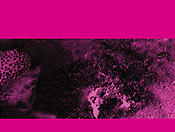
substance and software
xxxxx proposes a radical, new space for artistic exploration, with essential contributions from a diverse range of artists, theorists, and scientists. Combining intense background material, code listings, screenshots, new translation, [the] xxxxx [reader] functions as both guide and manifesto for a thought movement which is radically opposed to entropic contemporary economies. xxxxx traces a clear line across eccentric and wide ranging texts under the rubric of life coding which can well be contrasted with the death drive of cynical economy with roots in rationalism and enlightenment thought. Such philosophy, world as machine, informs its own deadly flipside embedded within language and technology. xxxxx totally unpicks this Hiroshimic engraving, offering a dandyish alternative by way of the deep examination of software and substance.
Life coding is primarily active, subsuming deprecated psychogeography in favour of acute wonderland technology, wary of any assumed transparency. Texts such as Endonomadology, a transcript from celebrated biochemist and chaos theory pioneer Otto E. Roessler who features heavily throughout this intense volume, make plain the sadistic nature and active legacy of rationalist thought. At the same time, through the science of endophysics, a physics from the inside rigorously examined here, a delicate theory of the world as interface is proposed.
xxxxx is very much concerned with the joyful elaboration of a new real; software-led propositions which are active and constructive in eviscerating contemporary culture. xxxxx embeds Perl Routines to Manipulate London, by way of software artist and Mongrel Graham Harwood, a Universal Dovetailer in the Lisp programming language from AI researcher Bruno Marchal rewriting the universe as code, and self explanatory Pornographic Coding from plagiarist and author Stewart Home and code art guru Florian Cramer. Software is treated as magical, electromystical, contrasting with the tedious GUI desktop applications and user-led drudgery expressed within a vast ghost-authored literature which merely serves to repeat over and again the demands of industry and economy. Key texts, which well explain the magic and sheer art of programming for the absolute beginner are published here.
Software subjugation is made plain within the very title of media theorist Friedrich Kittler's essay Protected Mode, published in this volume. Media, technology and destruction are further elaborated across the work in texts such as War.pl, Media and Drugs in Pynchon's Second World War, again from Kittler, and Simon Ford's elegant take on J.G Ballard's crashed cars exhibition of 1970, A Psychopathic Hymn.
Software and its expansion stand in obvious relation to language. Attacking transparency means examining the prison cell or virus of language; life coding as William S. Burrough's style cutup or riot playback (Stewart Home). And perhaps the most substantial and thorough-going examination is put forward by daring Vienna actionist Oswald Wiener in his Notes on the Concept of the Bio-adapter which has been thankfully unearthed here. Equally, Olga Goriunova's extensive examination of a new Russian literary trend, the online male literature of udaff.com provides both a reexamination of culture and language, and an example of the diversity of xxxxx; a diversity well reflected in background texts ranging across subjects such as Leibniz' monadology, the ur-crash of supreme flaneur Thomas de Quincey and several rewritings of the forensic model of Jack the Ripper thanks to Stewart Home and Martin Howse.
xxxxx liberates software from the machinic, and questions the transparency of language, proposing a new world view, a sheer electromysticism which is well explained with reference to the works of Thomas Pynchon in Friedrich Kittler's essay, translated for the first time into English, which closes xxxxx. http://xxxxx.1010.co.uk http://openmute.org
Posted by michelle at 07:53 PM | Comments (0)
Upgrade! Johannesburg in October
![]()
Collecting Digits
The Upgrade Johannesburg presents our first Panel Discussion:
Collecting Digits. This panel and discussion on the possibilities and problems with collecting new media art will include presentations by:
Warren Siebrits - founder of one of Johannesburg's most prestigious contemporary and modern commercial art galleries
Franci Cronje - curator of several collections & competitions, including Sasol New Signatures
Nathaniel Stern - digital and interactive artist, in several public & private collections
Clive Kellner - Director of the Johannesburg Art Museum
Friday October 6, 2006 @ 3pm:
WSOA Digital Arts. Map: http://digitalarts.wits.ac.za/artworks/
contact/map.htm
About Upgrade! Johannesburg
About once per month a group of new media students, artists and curators gather in Johannesburg, South Africa. At each meeting one or two artists present work - theirs, or a favorite's - in order to foster critique, dialogue and collaboration in our growing digital arts scene. The Upgrade! Joburg grew out of Professor Christo Doherty's (WSOA Digital Arts; Map ) regular Friday 'Digital Soirees' at Wits School of the Arts, and artist Nathaniel Stern's atjoburg
initiative, both founded between 2002/3 and still ongoing. They wanted to invite a larger, participative audience into their space, and be plugged into a more diverse and international network. Our first official Upgrade! featured Daniel Hirschmann, a South African Wits alumnus who alsostudied at NYU's Interactive Telecommunications Program, and went on to help shape the Physical Computing studio at Fabrica. At number two, Stern presented MTAA's brilliant work remotely (with their permission), rather fitting given their initial
involvement in the first NYC Upgrades....
http://atjoburg.net/upgrade/index.html
Posted by luis at 12:50 PM | Comments (0)
THE MAP DESIGNERS
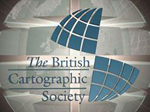
A Cartographic Event November 17th, Glasgow
The world of Cartography is changing beyond all recognition. It is no longer dominated by a few specialists in major companies or national organisations. The explosion of non-cartographic map makers has brought a vibrancy and freshness to the subject, the like of which has never been seen before. This presents two opportunities. Firstly an opportunity for the cartographic profession to learn from, and hopefully to incorporate, the graphic and artistic skills so abundant in other disciplines; and to benefit from the contribution Geographic Information Systems (GIS) has made to the industry. Secondly, there is an opportunity for the cartographic profession to explain some of the principles cartographers use when making maps. Cartographers have not been making maps for over 5000 years without learning a thing or two in the process. And yet for all the skills these diverse groups have brought to bear on map making, from GIS to map-Art, there remains one crucial problem. Most people can't read the maps they produce. For the first time in the UK, and probably worldwide, this seminar will bring together cartographic designers, and designers from the world of media and GIS, to discuss how to make maps effective, exciting, irresistible and ...readable.
Anyone who commissions maps, or who is involved in the making of maps, whether from GIS data or the imagination of the artist will be welcome at 'The Map Designers' seminar. The seminar is designed for architects, surveyors, tourism, foresters, utilities, earth scientists, cartographers, graphic artists, and government; in fact every branch of society that uses or creates maps. We would especially like to welcome students from Scotland, the North East and
further afield, with our incredible deal - for a once in a lifetime seminar! This amazing concessionary price is also open to all on proof of eligibility, i.e. unemployed, retired, BCS Associate Members etc... So here it is:-
THE MAP DESIGNERS at The Lighthouse Scotland's Centre for
Architecture and Design Glasgow 17th NOVEMBER 2006
PROGRAMME Chaired by Michael Wood OBE. Aberdeen University. President of the Society of Cartographers. Past President of the International Cartographic Association, and the British Cartographic Society.
SPEAKERS Alan Collinson FBCart.S Geo-Innovations. Co-Convener of the British Cartographic Society Design Group. The Principles of Cartographic Design, Cartographic Impressionism and Map Art. Mary Spence MBE FBCart.S, Global Mapping. President of the British Cartographic Society. The Qualities of Better Mapping. Dave Barbour FBCart.S, Stirling Surveys. International Award Winner. Maps People Can Read Easily. Design for Recreation and Orienteering. Wendy Price, Wendy Price Cartographic Services. Map Making as an Art. Susie Jones FBCart.S, Senior Lecturer at the School of Military Survey. Co-Convener of the British Cartographic Society Design Group. GIS and Map Design. Paul Stickley Head of Media Design, Glasgow School of Art. To be confirmed.
OPEN FORUM. Map Designers Talking. Cost. (BCS and SOC members, Students and concessions).
Details and booking from Lynda Bailey Cartographer and Map Librarian E213 FCO Library Foreign and Commonwealth Office King Charles Street London SW1A 2AH lynda.bailey2@virgin.net
Posted by newradio at 12:44 PM | Comments (0)
Max Payne Cheats Only
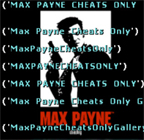
JODI in conversation
On Thursday, October 5 at 6pm at the Gene Siskel Film Center, Conversations at the Edge will present digital art pioneers JODI (Joan Heemskerk and Dirk Paesmans) in a rare public demonstration of their latest video game modifications, including Max Payne Cheats Only (2005), along with their ground-breaking modifications of Quake 1, Untitled Game (1996–2001), Software’s game Wolfenstein 3D, SOD (1999) and the early ’80s game Jet Set Willy, Jet Set Willy Variations © 1984 (2002)
Digital provocateurs JODI pioneered Web art in the mid-1990s, upending the conventions of the emerging medium to create anarchic programs that simulated computer crashes, viruses, and error messages. The duo has wrought similar havoc on computer programs and video games, radically disrupting the language of these systems—including interfaces, commands, errors, and code—to subvert the relationship between computer technology and its users. About JODI cont. JODI's works are typically seen online. Their recent solo exhibitions include INSTALL.EXE at Eyebeam, New York, which toured to Basel and to BuroFriedrich, Berlin; and the Computing 101B exhibition at FACT Centre, Liverpool, England. Their works have also been exhibited at the Centre for Contemporary Arts, Glasgow; Kunstverein Bonn; Stedelijk Museum, Amsterdam; Zentrum fur Kunst und Medientechnologie, Karlsruhe, Germany; and Documenta X, Kassel, Germany, among others.
JODI: Max Payne Cheats Only is co-presented by Conversations at the Edge (a program organized by the Department of Film, Video, and New Media in association with the Video Data Bank and the Gene Siskel Film Center), the Visiting Artist Program at the School of the Art Institute of Chicago and the Department of Interactive Arts and Media at Columbia College Chicago.
ODI: Max Payne Cheats Only is co-presented by Conversations at the Edge (a program organized by the Department of Film, Video, and New Media in association with the Video Data Bank and the Gene Siskel Film Center), the Visiting Artist Program at the School of the Art Institute of Chicago and the Department of Interactive Arts and Media at Columbia College Chicago.
http://www.myspace.com/conversationsattheedge
http://fvnm.info
http://www.vdb.org
http://www.siskelfilmcenter.org
http://www.saic.edu/art_design/vap
http://www.saic.edu
http://interactive.colum.edu
http://www.colum.edu
JODI: MAX PAYNE CHEATS ONLY!
Joan Heemskerk and Dirk Paesmans in person!
Max Payne Cheats Only (1996–2005, Netherlands, ca. 60 min)
THURSDAY OCTOBER 5 @ 6:00 PM
Gene Siskel Film Center
164 N. State
CHI IL .US
$ 9 USD
$ 5 USD for Film Center members
$ 7 USD for students
Posted by luis at 04:30 AM | Comments (0)
October 02, 2006
Maps & Devices (Glade)
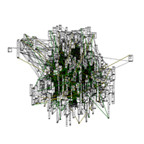
André Sier's exhibition
atan, je t'aime..., struct_0. To reach the glade. Maps & Devices will take several shapes at Agência de Arte Vera Cortês, in Lisbon, starting September 2006 and throughout 2007; in a series of small exhibitions, the audience will have the opportunity to see works by André Sier, who tries to cristallize inovative space-time relations, using computer programming languages to develop interactive audiovisual art works. In the first part of Maps & Devices - the Glade, we will find advertisements and maps for the construction of algorithmic devices that make time unravel in various ways.
attan (2005) is a group of cuomputer generated program-drawings that bring into view glimpses of arrangements of small objects and their interconections. It includes small image programs that develop around topics like Babel, Europe, WWW III, the sun and that map the evolution of moving code links that have become static in print. Atan is the mathematical operation that searches the arch based on its tangent- The drawings evolve using only elemnts of the program that generates them, creating incoherent programs that can not run without breaking down the system - but it is possible to provide these kamikaze programs with standard structural images, from which to evolve and crash.
je t'aime... (1998) is Sier's first site-specific work with continuous sound. it sends the sound from a space, through omnidirectional contact microphones that translate the vibrations created by the environment's sounds and people moving around, into a woofer modified in order to contain fluids. The physicalness of the amplified sounds creates concentric patterns that vibrate on the water surface of the speaker/object to the sound details captured by the microphones. The device also amplifies the fluid oscillating patterns using a light projector and a mirror to luminously enlarge the pattern at the woofer.
struct_0 (2001) is the first version of the struct series, exploring several conjugations of the open using sound and image. It is a site-specific audiovisual installation running code on the sound of the space. The computer application seeks to permeate different sound lines captured in the room, drawing gaps in the natural time flow. Visually, one can see a particle (line) system in synchrony with the orchestrated sound fabric, in permanent flow.
For more info visit Vera Cortes Agencia de Arte
Posted by luis at 04:49 PM | Comments (0)
in_rete

Digital art meets textile industry
Arte&Arte is pleased to announce in_rete (in_the_net), the XVI edition of the International Exhibition of Contemporary Textile Art Miniartextil. The exhibition will take place in various public and private venues in Como (Italy), and will run from the 7th of September through the 12th of November 2006.
This year, the exhibition will focus on the connections – both metaphorical and literal – between two worlds and two media: the fabric and the Net. In order to suggest these connections, the main venue of the exhibition – the fascinating church of San Francesco in Como – will host five new media installations, from both Italian and American artists: Relations (2004), a generative software by Italian Alessandro Capozzo; Exuvia (2006), mixed media innstallation by Alessandro Capozzo and Katia Noppes; Quixote (2004 – 2006), a moblog living performance by Italian artists Gianni Corino and Lorenzo Verna; Screening Circle (2006), the interactive installation of an online work by the American artist Andy Deck, a 2006 commission of the Whitney Artport and the Tate Online; Knitoscope Testimonies (2006) by Cat Mazza, a series of videos produced with a software that translates digital video into a knitted animation; and the Infome Imager Lite Workshop (2005), an installation featuring a Web Visualization Software by the American artist Lisa Jevbratt.
As the New Media Art section curator Domenico Quaranta wrote: “There are many associations between digital media and the world of textiles, dating right back to the advent of the computer and gradually firming up over time. Such links can be observed not only in terms of how computers work and the structure of binary code, but also in a series of metaphors, concepts and forms: the net, the web, weaving pixels, pattern, texture, etc.
New Media Art, which works with the social, political and cultural consequences of the media it utilises, is well aware of these links, and this awareness emerges both in its aesthetics, and in the operative techniques implemented. In particular, all Net Art (namely art which comes into being on the web and for the web, and uses the web as its tool of choice, and also its main theme) is by definition a textile art, as it plays a part in enriching the fabric of cyberspace and creating networks, building and activating communities. In other words, net art is the art of weaving the web, which grants it an enormous potential, enabling it not only to comment on the media it utilises but also to contribute to its life, its creation and its history.”
WORKS:
Alessandro Capozzo (IT), Relations, 2004, http://www.abstract-codex.net/relations/index.html
Alessandro Capozzo & Katia Noppes (IT), Exuvia, 2006, http://www.abstract-codex.net/exuvia/index.html
Gianni Corino & Lorenzo Verna (IT), Quixote, 2004 – 2006, http://www.quixote.it/
Andy Deck (USA), Screening Circle, 2006, http://artcontext.net/act/05/screeningCircle/
Cat Mazza (USA), Knitoscope Testimonies, 2006, http://www.turbulence.org/Works/microRevolt/
Lisa Jevbratt (USA), Infome Imager, 2002 – 2005, http://jevbratt.com/infome_imager/lite
HI-RES IMAGES & CATALOGUE TEXT:
http://www.domenicoquaranta.net/miniartextil.html
ORGANIZATION:
ARTE&ARTE Associazione Culturale
Via Pannilani 23 - 22100 Como
Tel & Fax 031.305621
Email artearte@miniartextil.it
Posted by luis at 07:00 AM | Comments (0)
October 01, 2006
Where's Jo?
Strong heart!
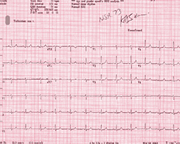
bum knee :(
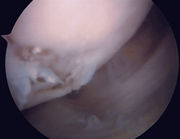
Back in a few weeks.
Jo
Posted by jo at 06:13 PM | Comments (0)
Turbulence Commission:
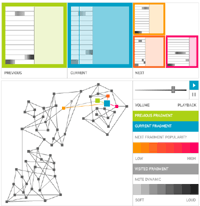
Graph Theory
Turbulence Commission: Graph Theory by Jason Freeman, with Patricia Reed and Maja Cerar :: [needs Macromedia Flash Player plugin; Internet Explorer 5+, Mozilla Firefox 1.5.0+, or Safari 1.0+]
"Graph Theory" seeks to connect composition, listening, and concert performance by coupling an acoustic work for solo violin or solo cello to an interactive web site. On the web site, users navigate among sixty-one short, looping musical fragments to create their own unique path through the composition. The navigation choices which users make affect future concert performances of the work. Before each performance, the soloist prints out a new copy of the score from the web site. That score presents her with a fixed path through the piece; the order of the fragments is influenced by the decisions that recent web site visitors have made.
"Graph Theory" is a 2006 commission of New Radio and Performing Arts, Inc. (aka Ether-Ore) for its Turbulence web site. It was made possible with funding from The Greenwall Foundation.
BIOGRAPHIES
JASON FREEMAN'S works break down conventional barriers between composers, performers, and listeners, using new technology and unconventional notation to turn audiences and musicians into compositional collaborators. His music has been performed by the American Composers Orchestra, Speculum Musicae, the So Percussion Group, the Nieuw Ensemble, Le Nouvel Ensemble Moderne, and Evan Ziporyn; and his interactive installations and software art have been exhibited at the Lincoln Center Festival, the Boston CyberArts Festival, and the Transmediale Festival and featured in the New York Times and on National Public Radio. N.A.G. (Network Auralization for Gnutella) (2003), a commission from Turbulence.org, was described by Billboard as "an example of the web's mind-expanding possibilities." Freeman received his B.A. in music from Yale University and his M.A. and D.M.A. in composition from Columbia University. He is currently an assistant professor of music at the Georgia Institute of Technology in Atlanta.
PATRICIA REED (1977, Ottawa, Canada) completed her studies in Studio Arts at Concordia University, Montréal (1999). In 2001-02 she attended the residency program of CCA Kitakyushu, Japan; in 2003 she relocated to Europe, through an artists' residency in Prague and Akademie Schloss Solitude in Stuttgart (2003-4, 05). While maintaining an active artistic practice, she also works as a designer with focus on developing interfaces and means of visualizing scientific research, thereby making accessible complex information to a broader audience. Recent design projects include the development of information cartography/exhibition architecture for The Gallery of Research, Vienna (2005) and a sociological web 'diorama', Paris:Ville Invisible, with Bruno Latour (2004) which will be featured in an exhibition at Centre Pompidou, Paris (2007). Graph Theory is Reed's first collaborative work within the field of musical composition. She currently lives and works in Berlin, Germany.
MAJA CERAR is a concert violinist who studied with Aida Stucki- Piraccini in Zurich and with Dorothy DeLay in New York and is currently completing her Ph.D in Historical Musicology at Columbia University. She frequently works with composers, has premiered numerous works written for her, and has been coached by Beat Furrer and György Kurtàg. Since her debut in the Zurich Tonhalle in 1991 she has played as a soloist with orchestras in Europe, given recitals with distinguished artists on international tours (Paris, Rome, Washington, Chicago, New York) as well as at festivals in Europe (including the Davos "Young Artists in Concert," the Gidon Kremer Lockenhaus Festival, the ISCM World Music Days and the ICMC Barcelona), America (Aspen, Vermont, Santa Fe, San Diego), and Asia.
Posted by jo at 09:01 AM | Comments (0)

